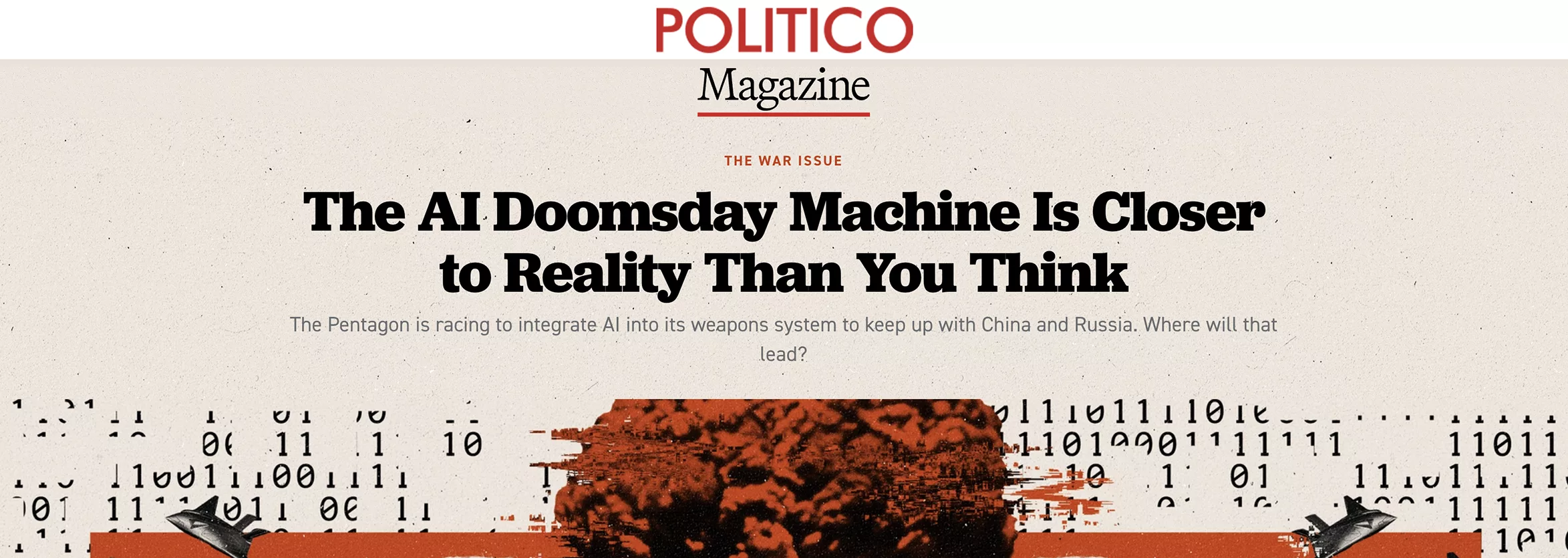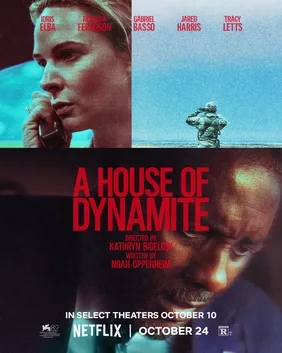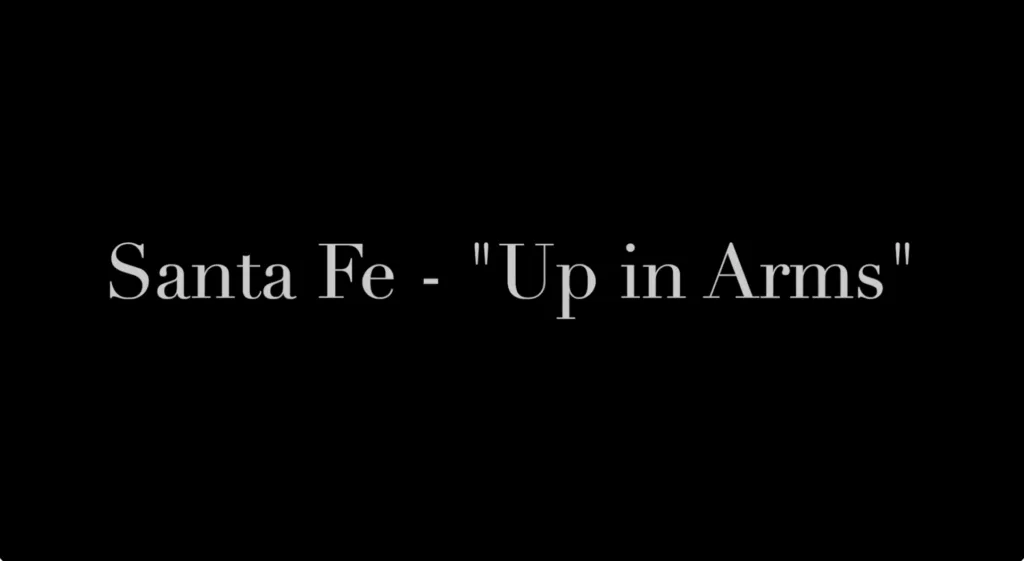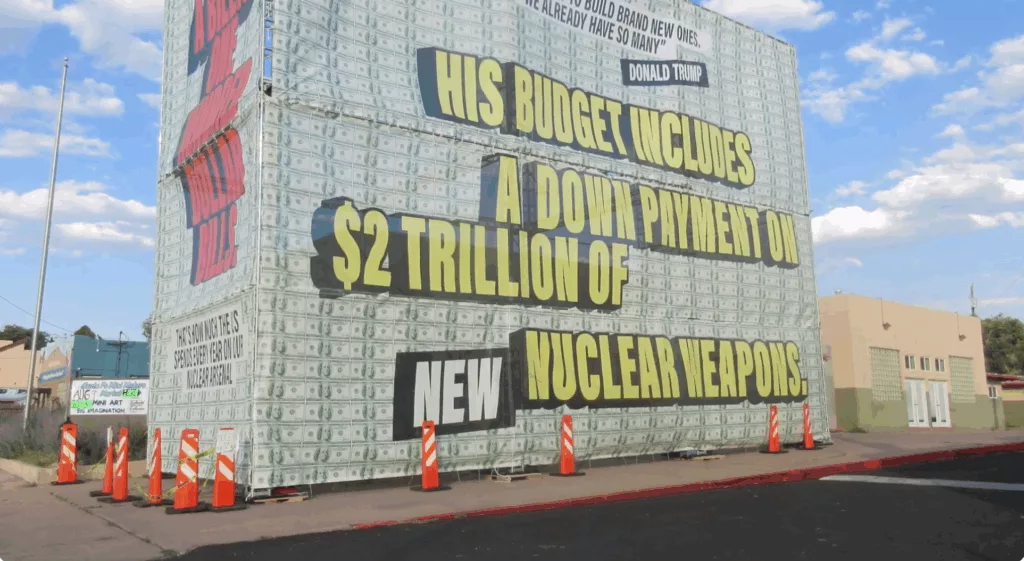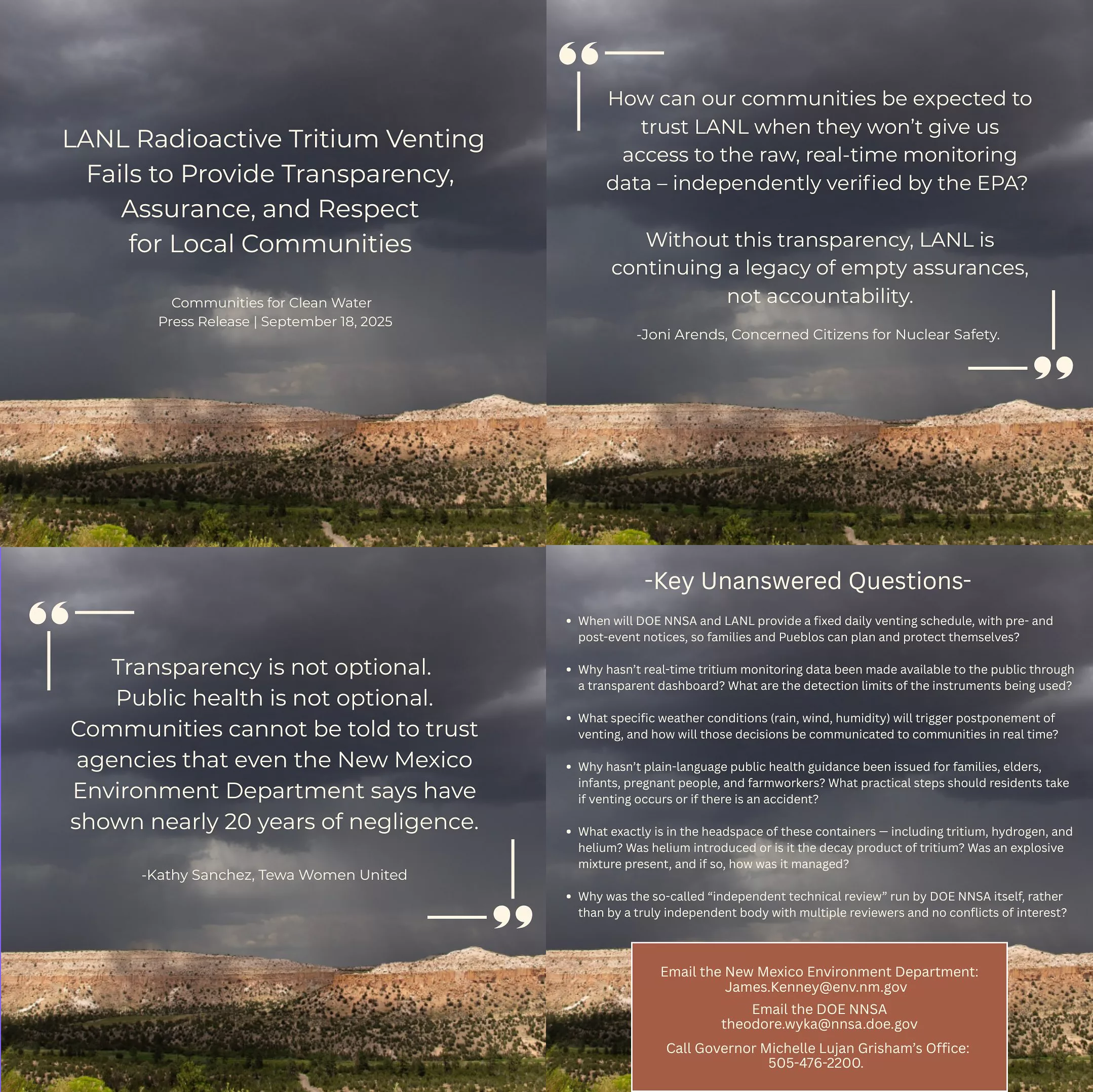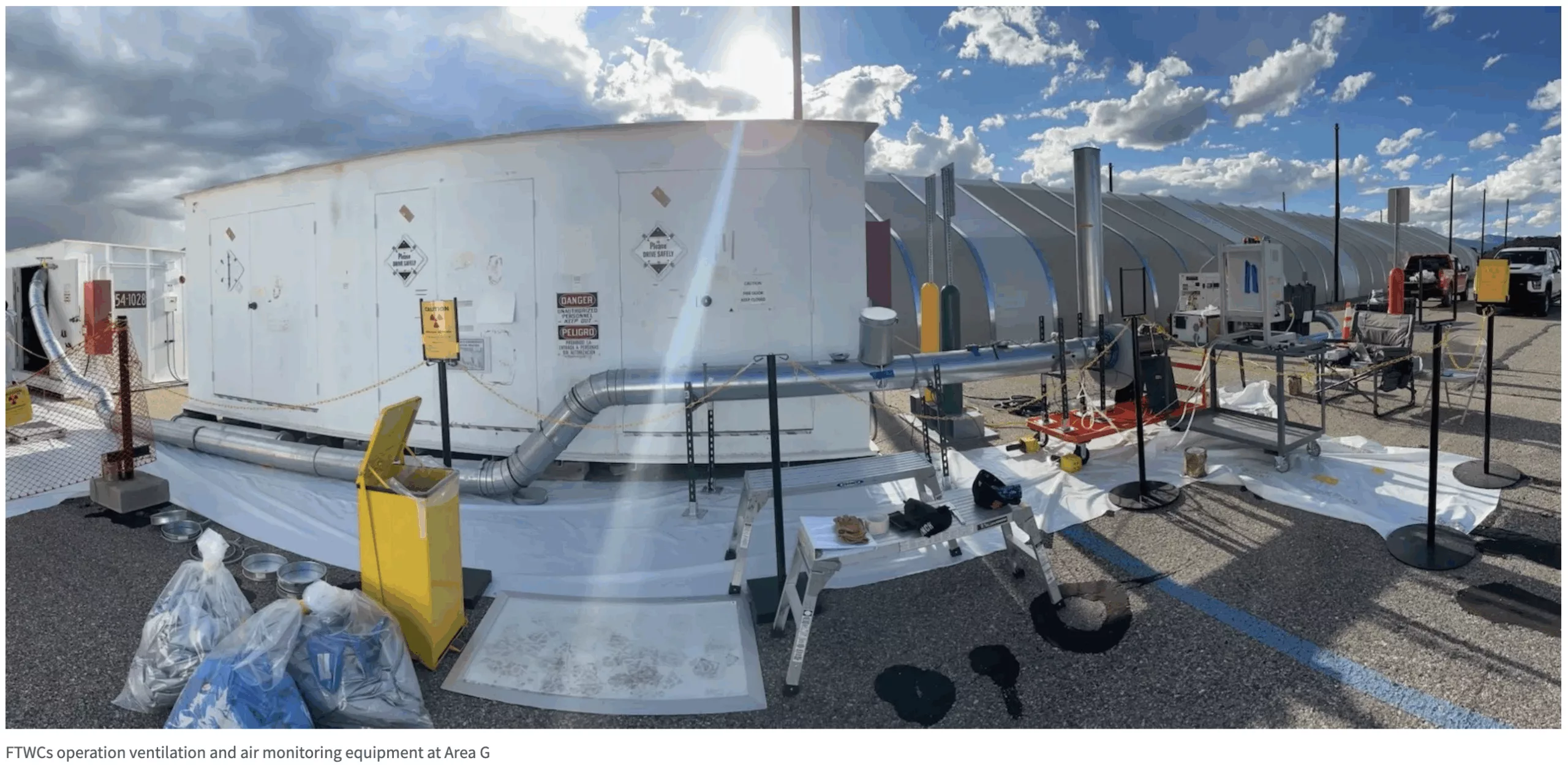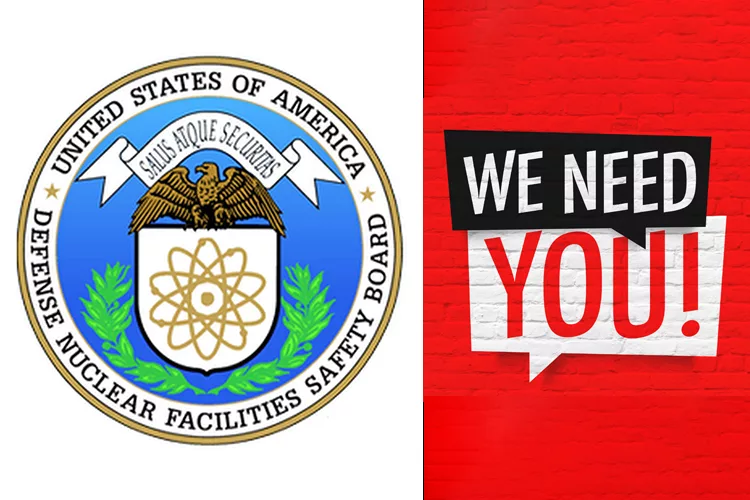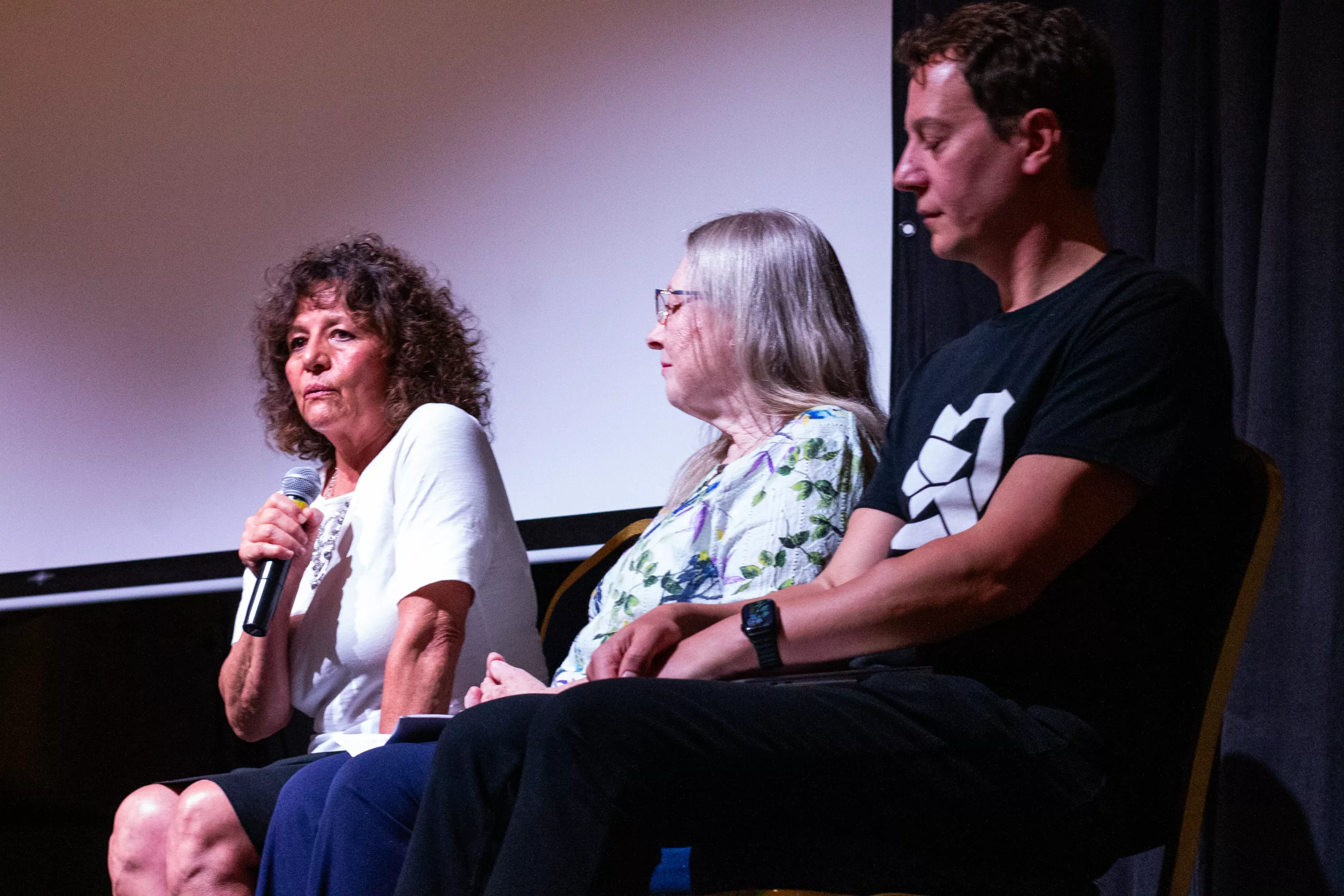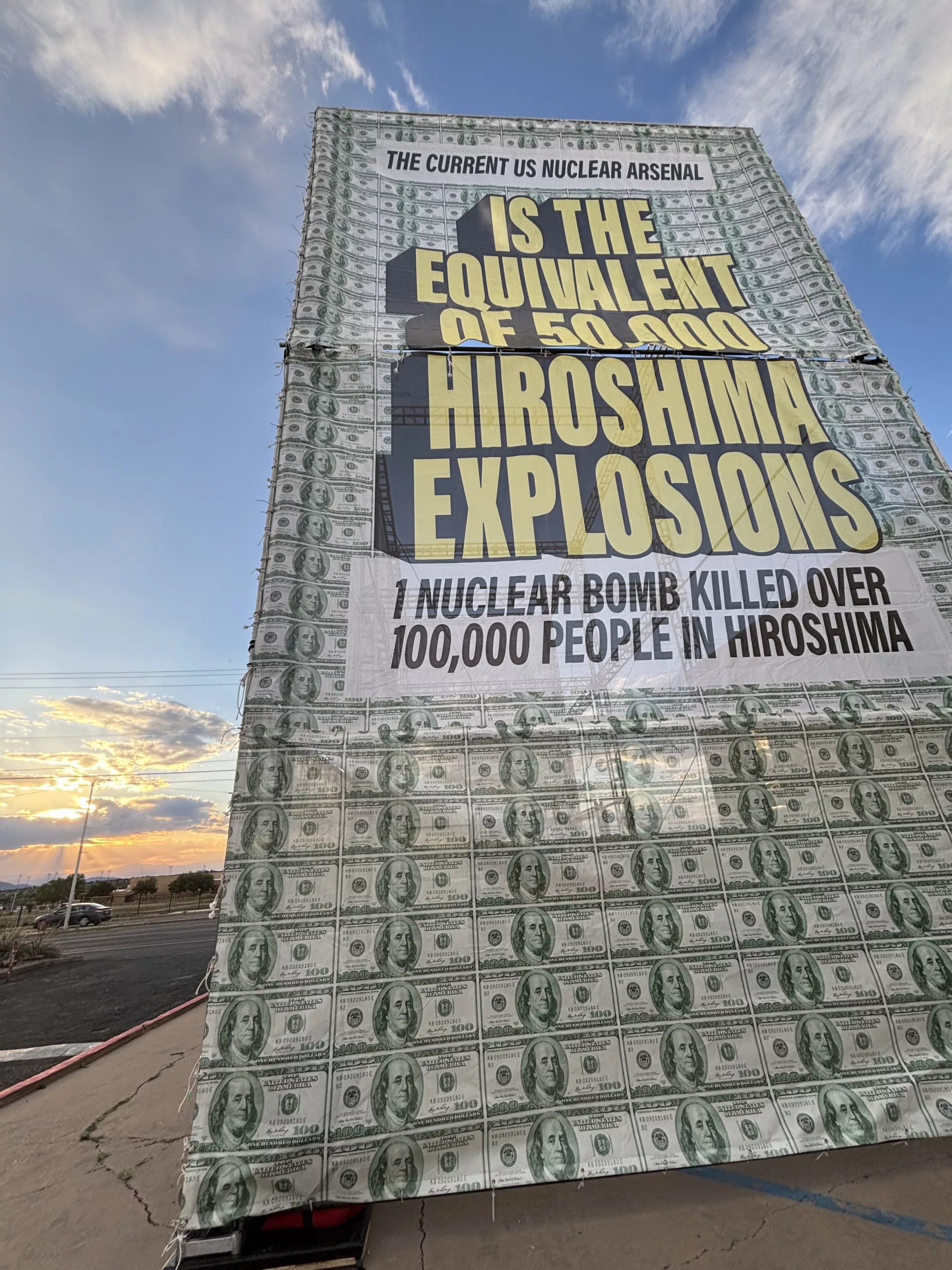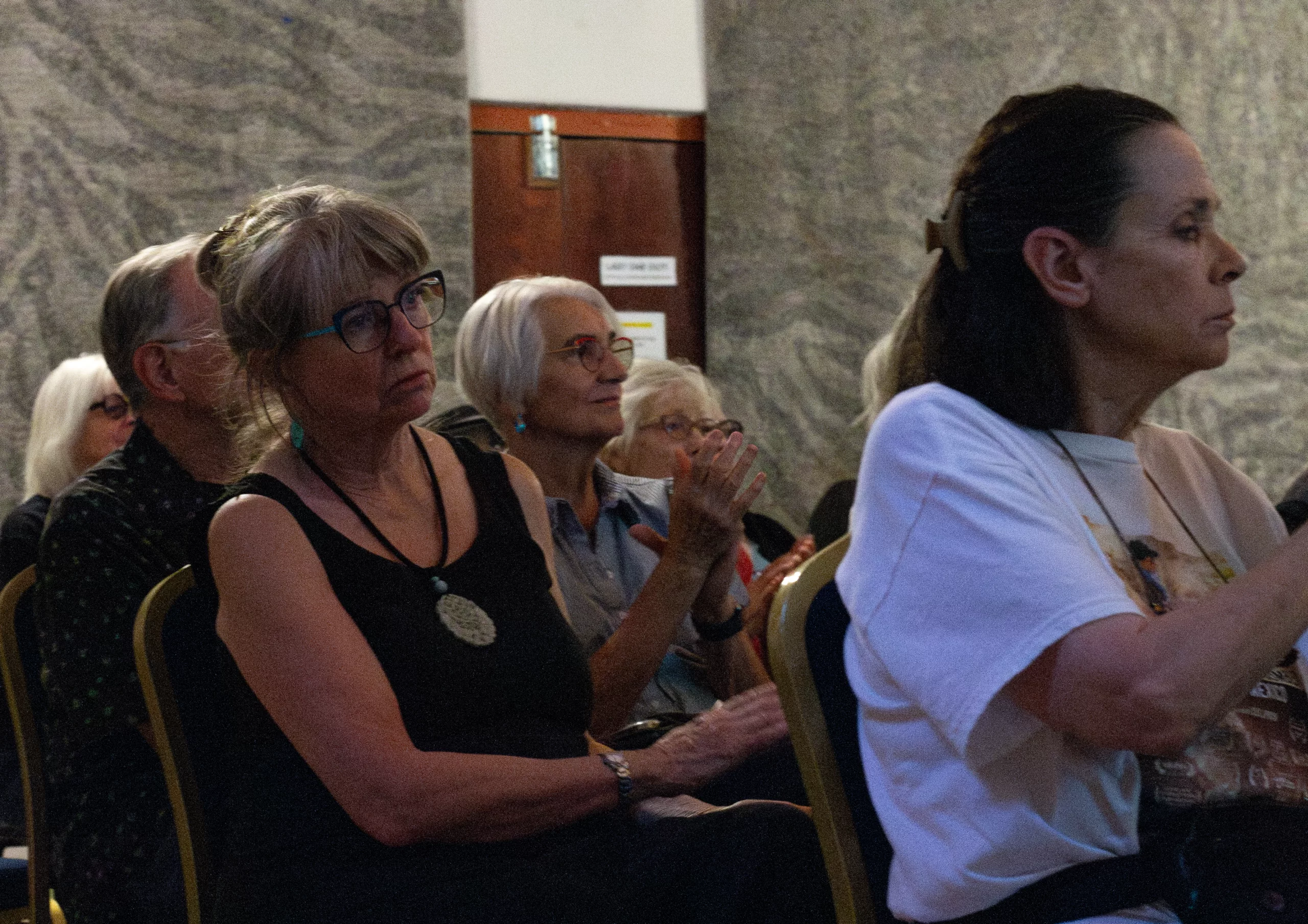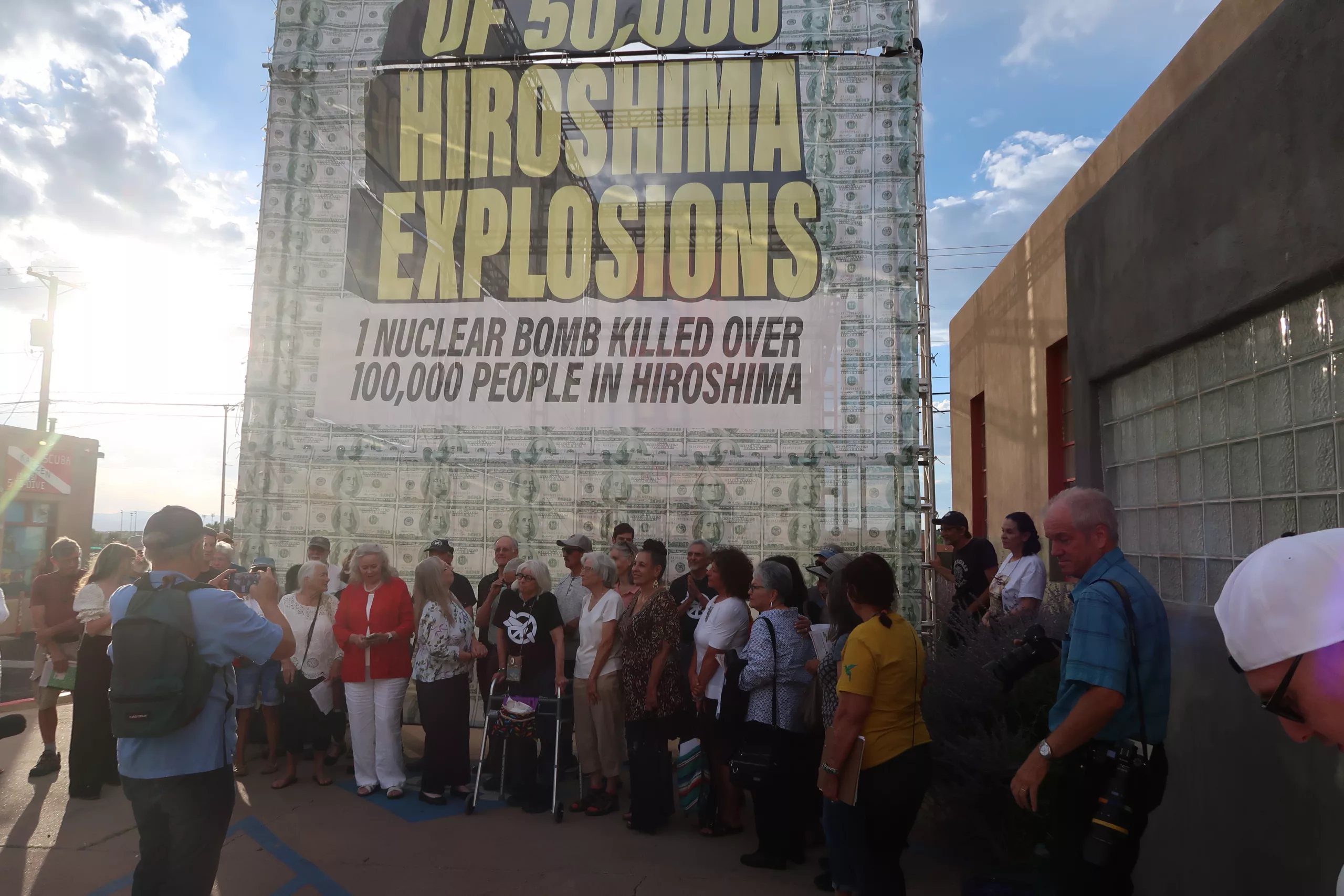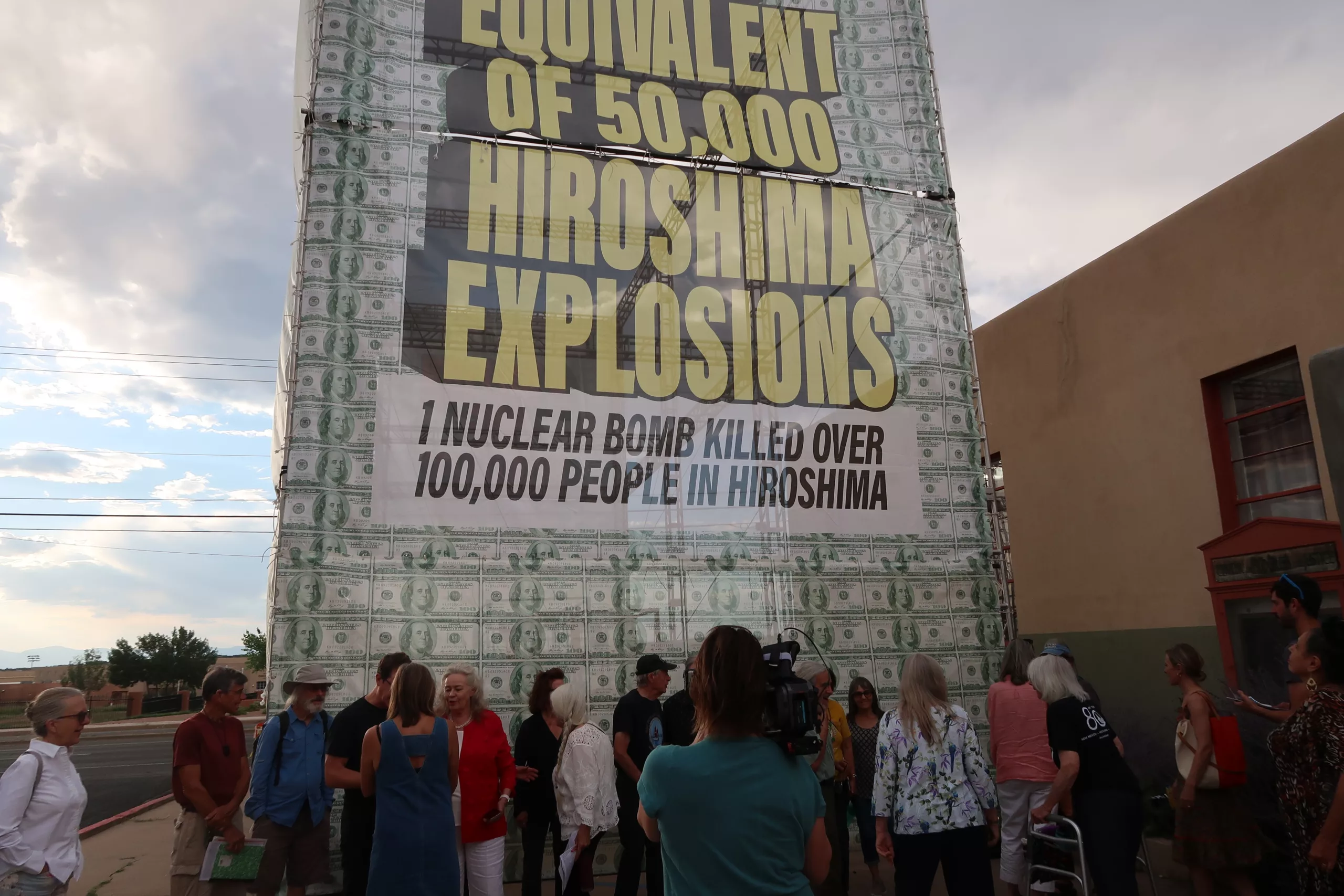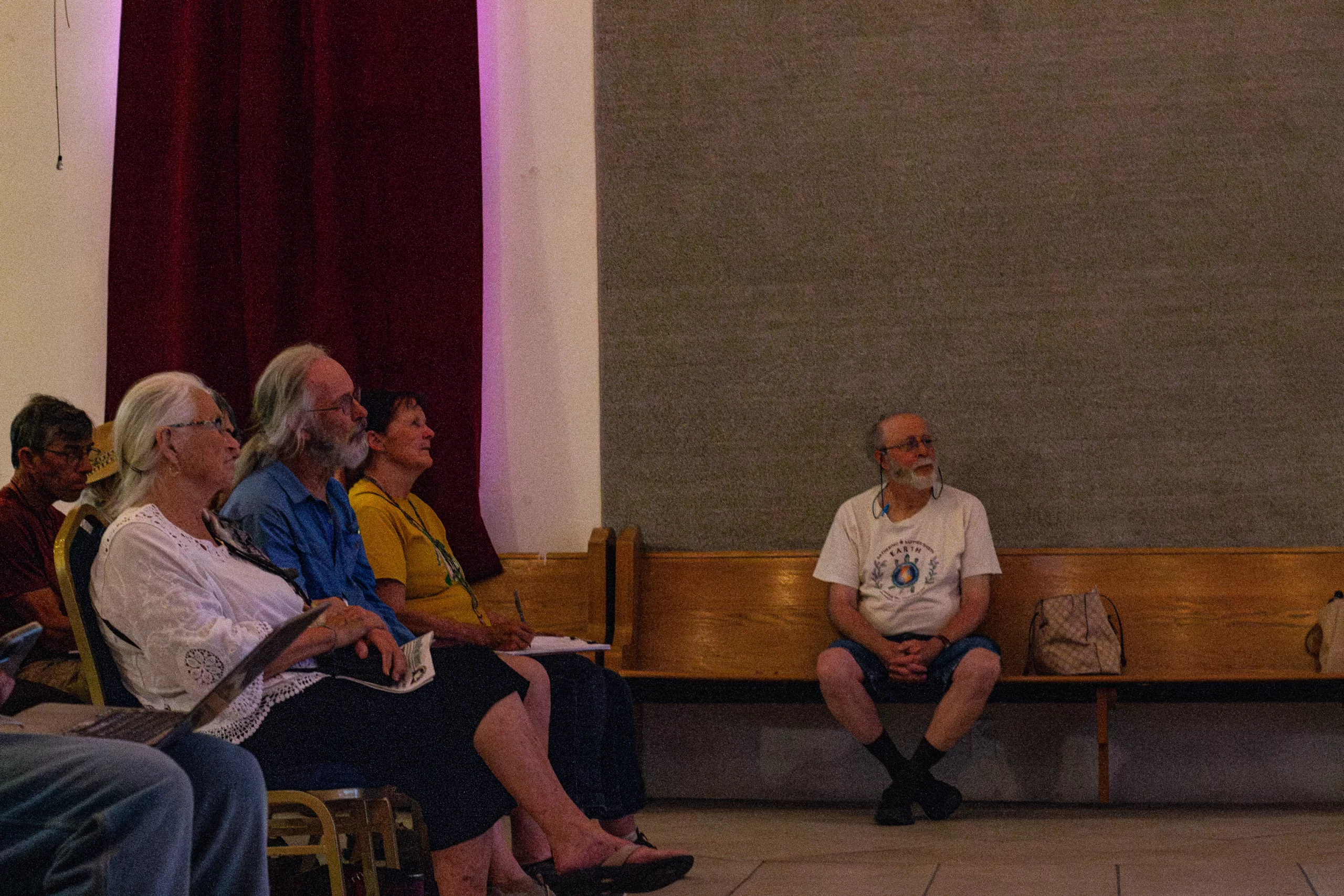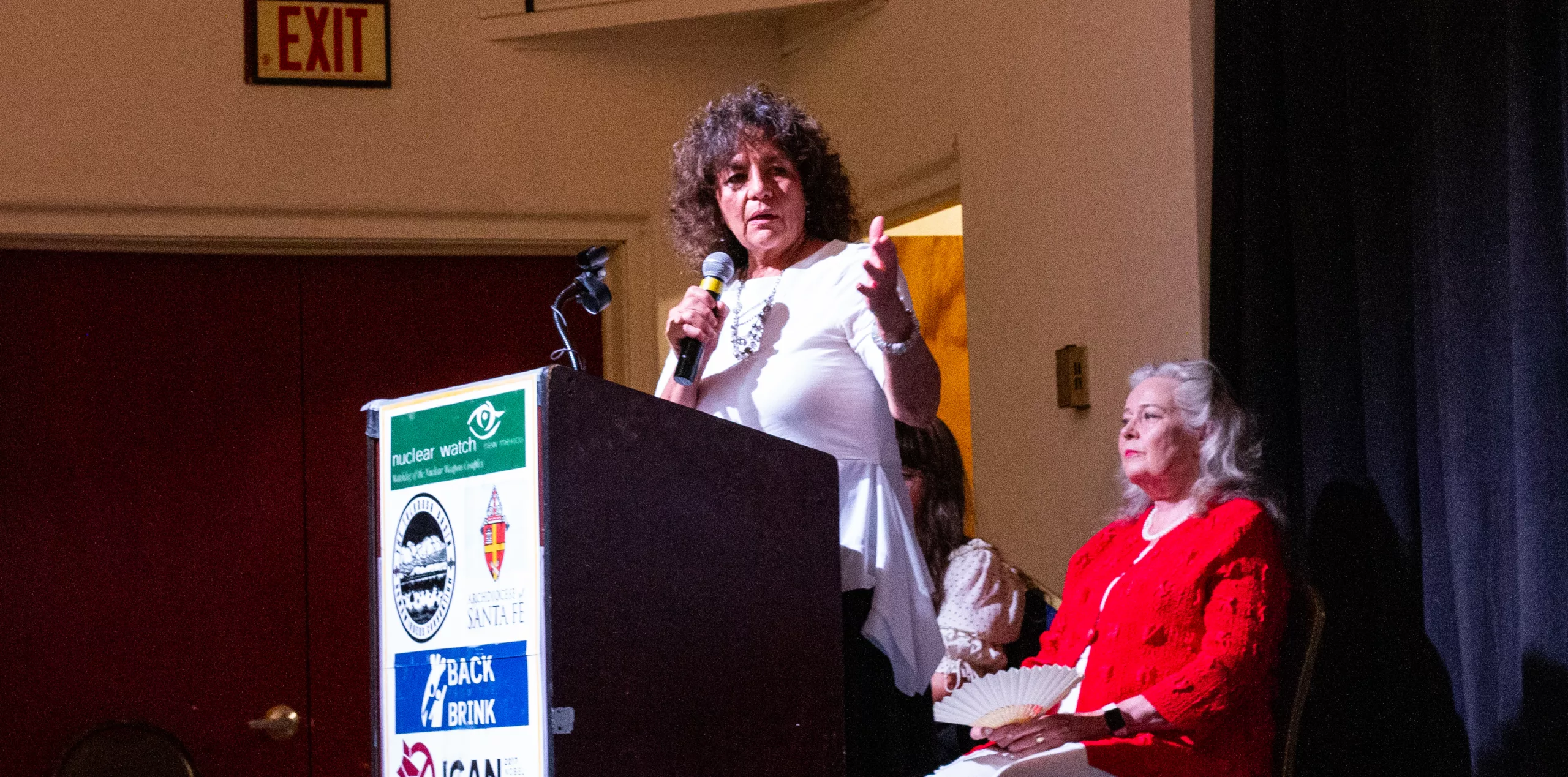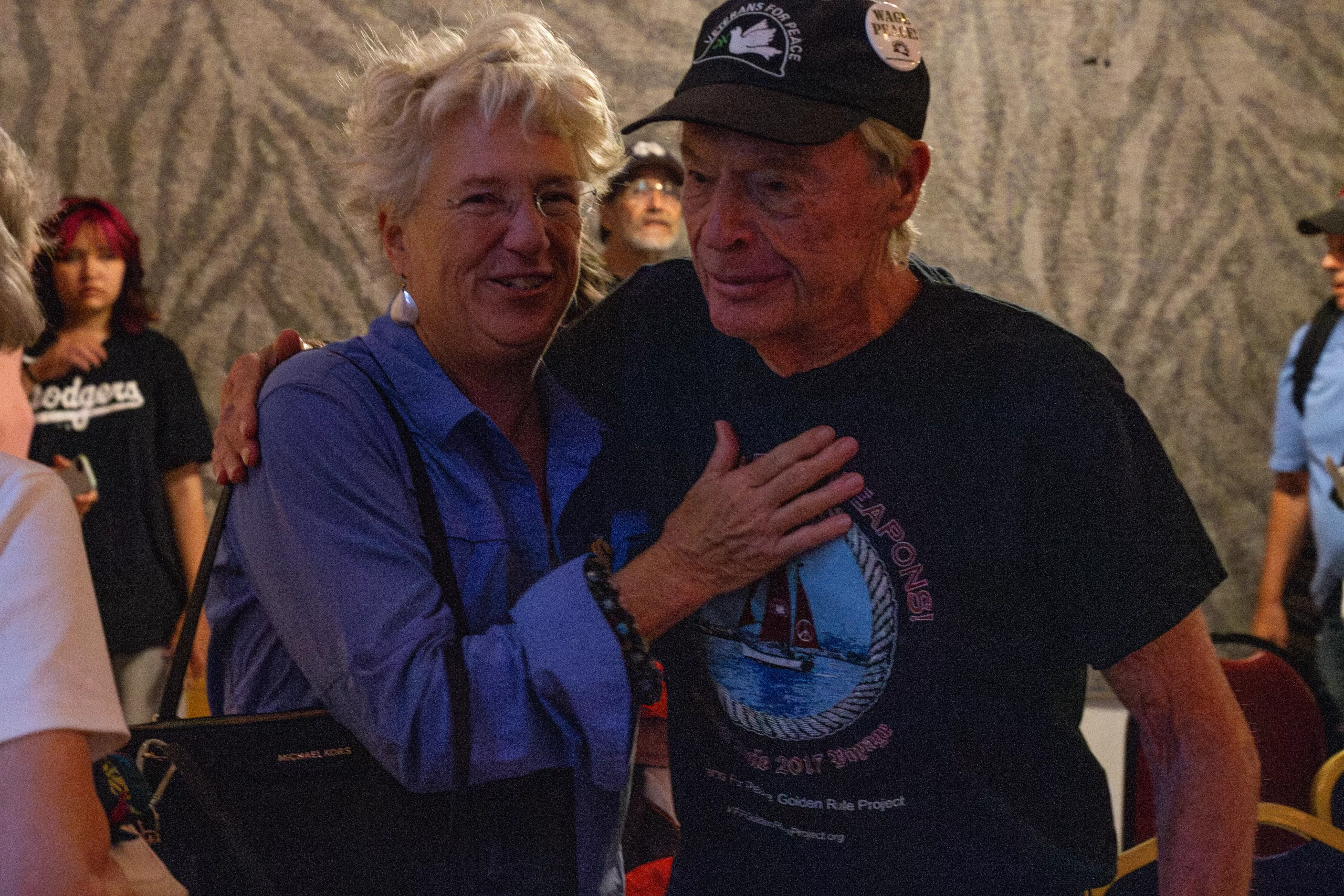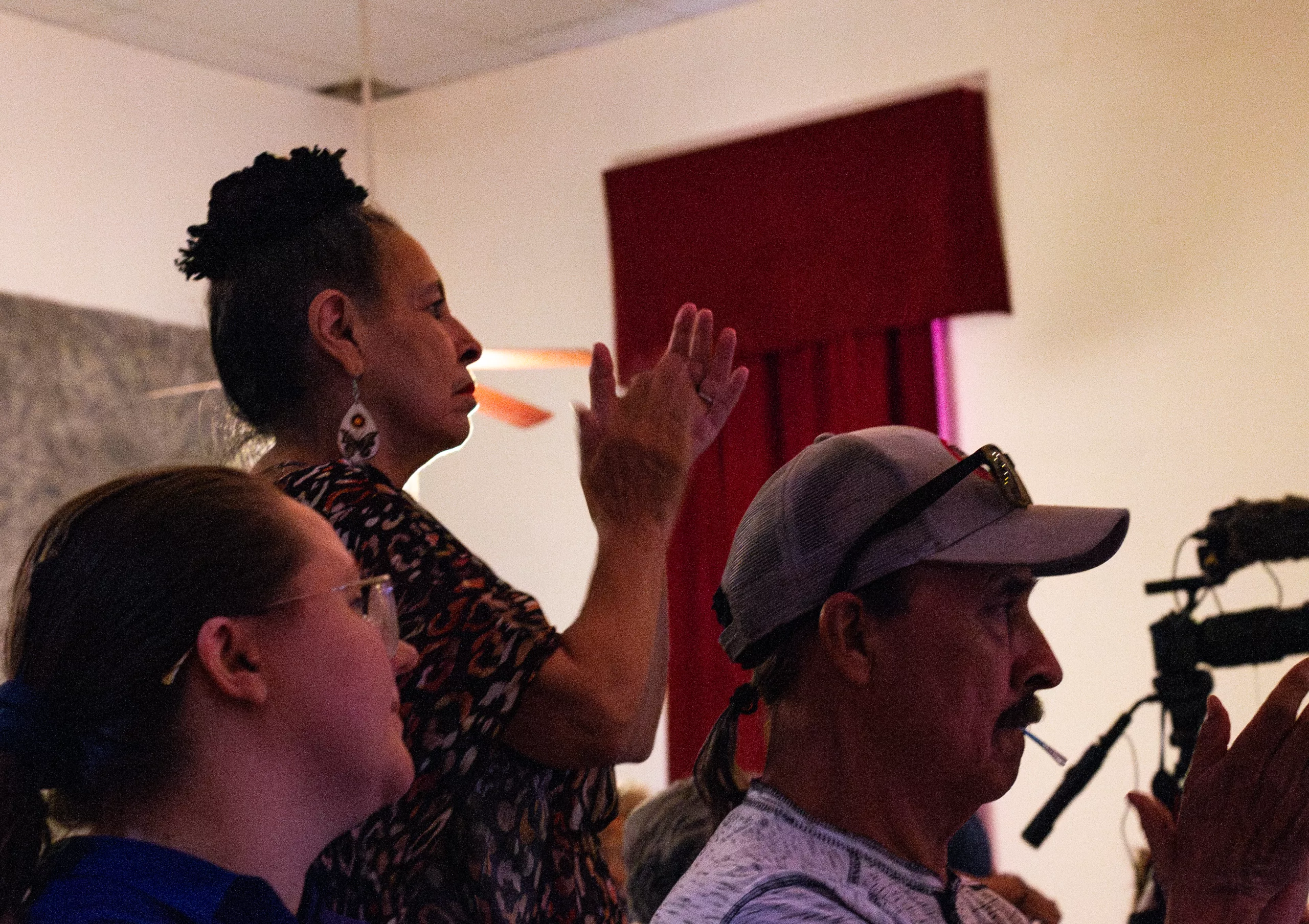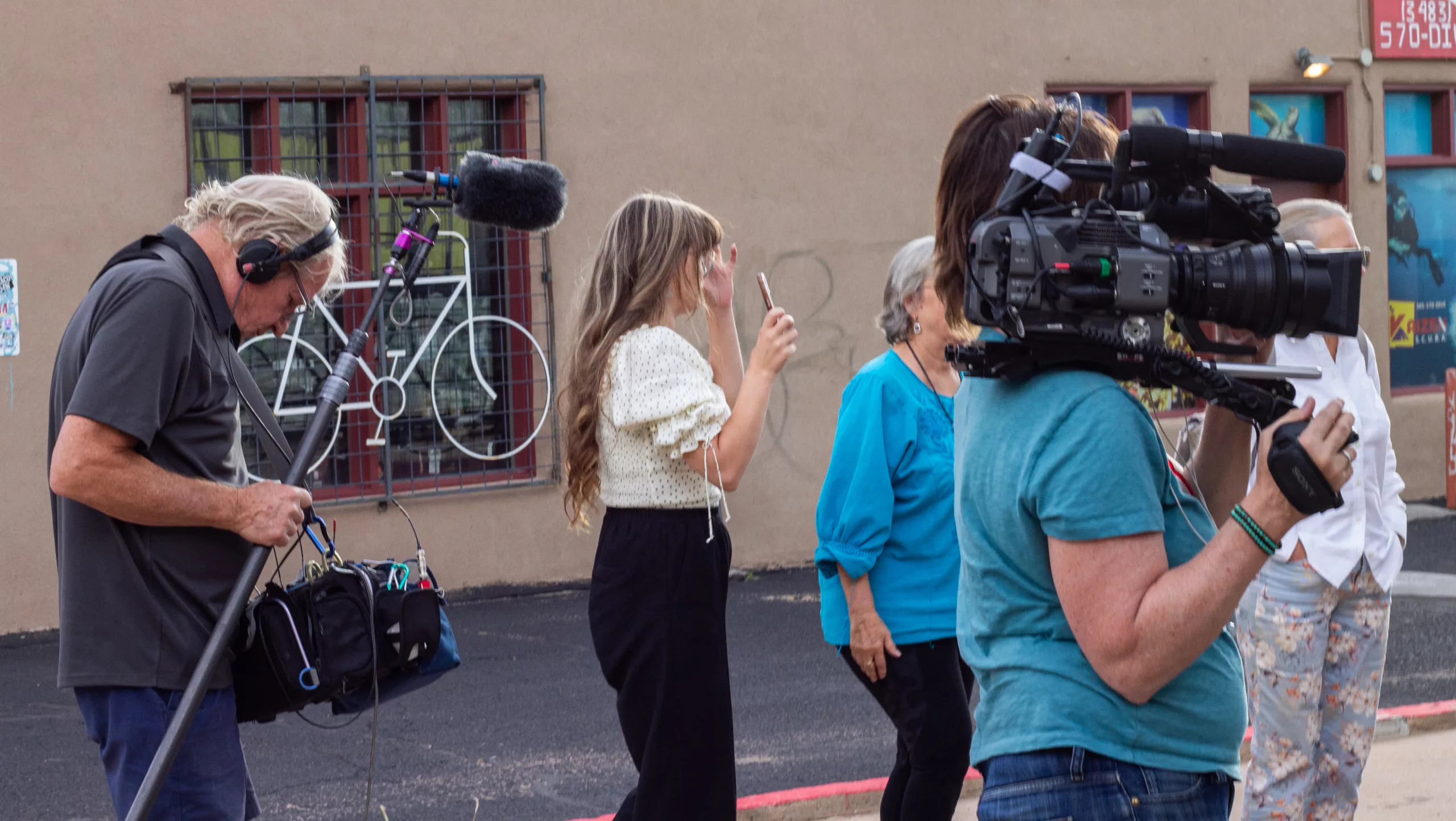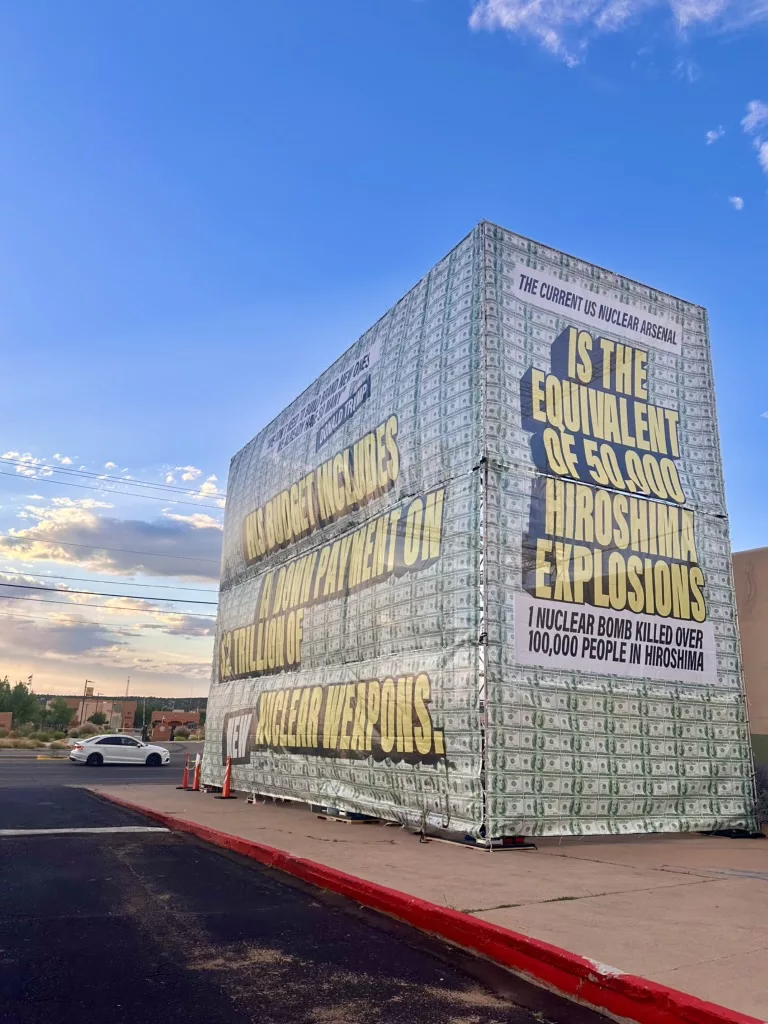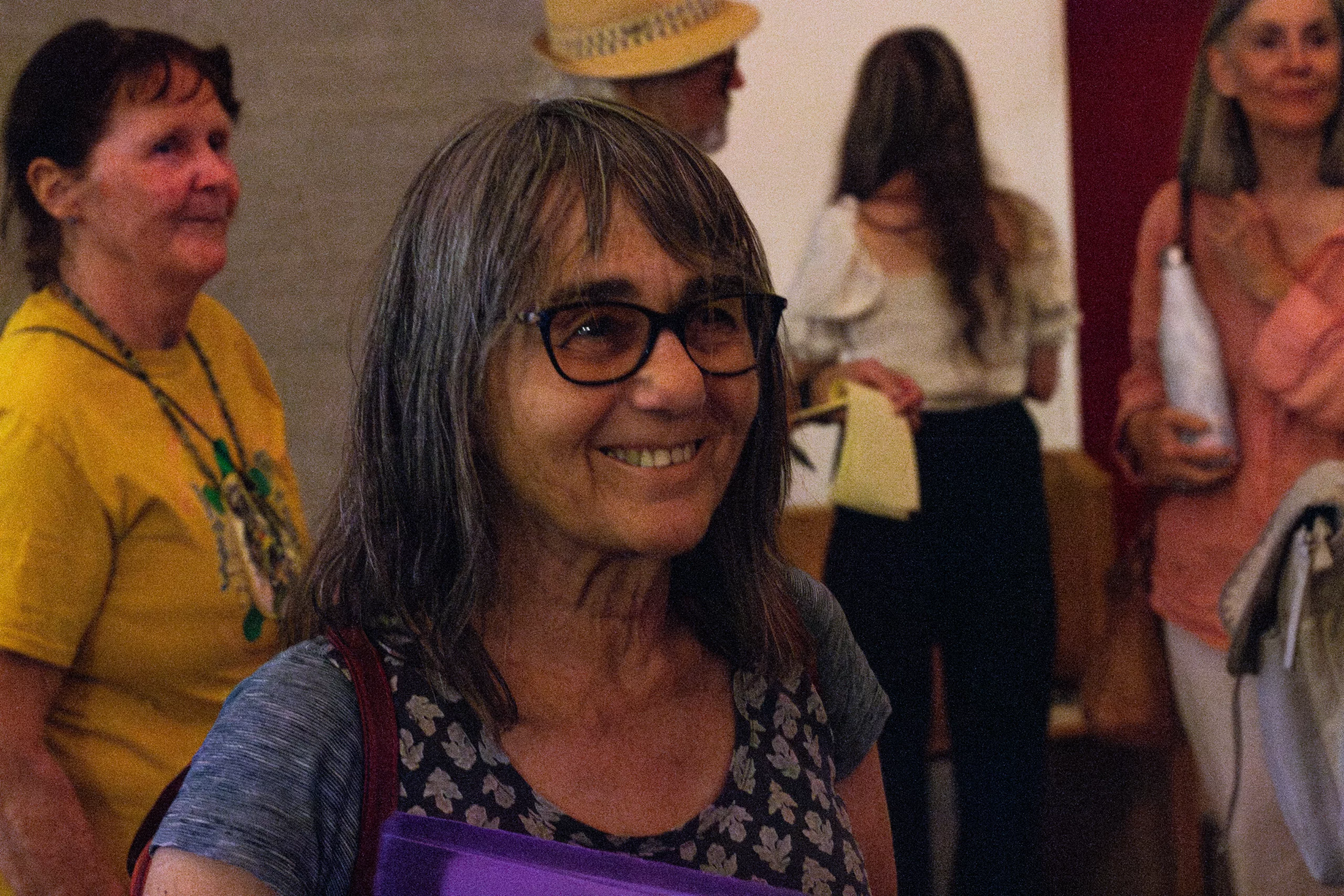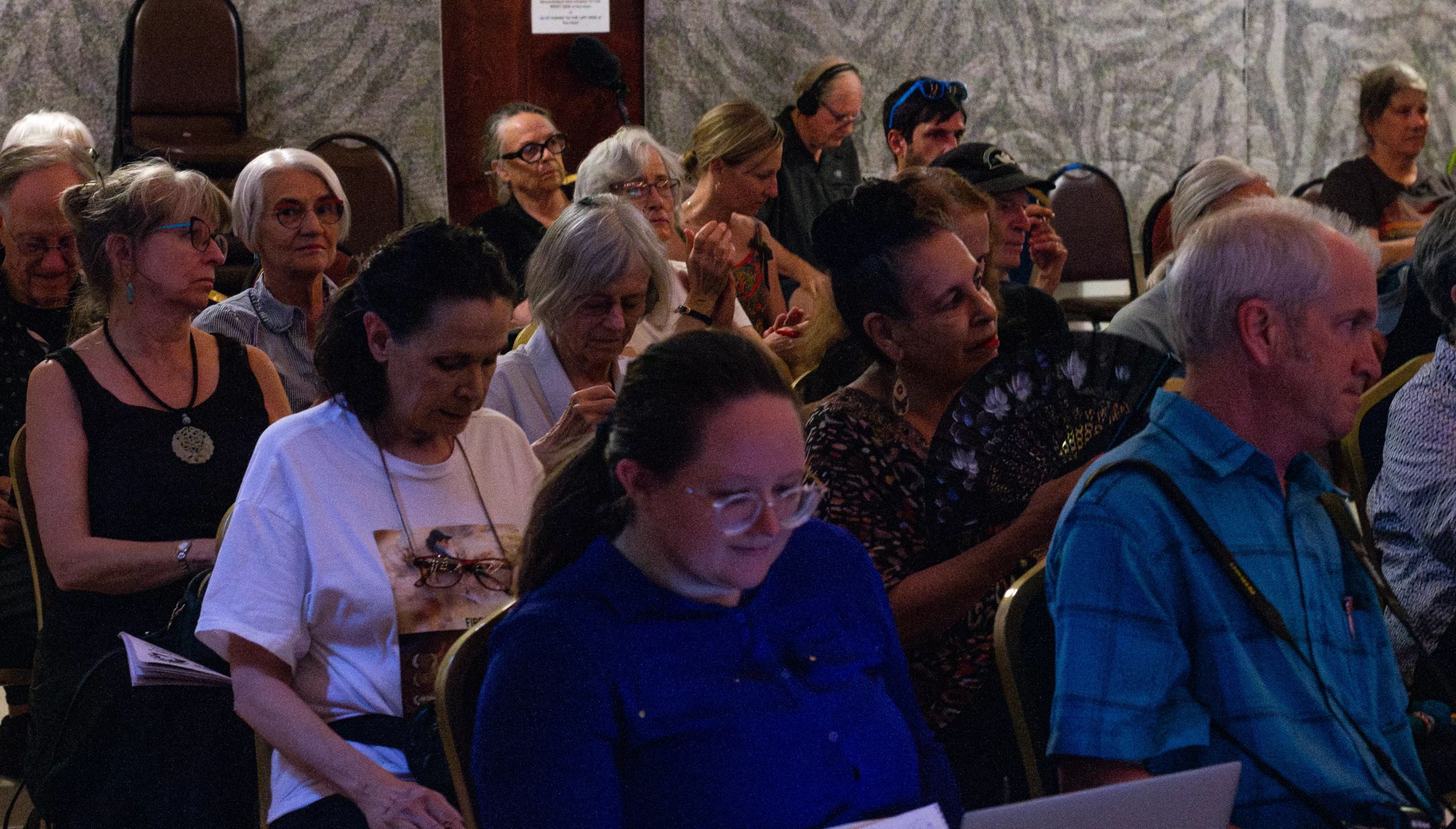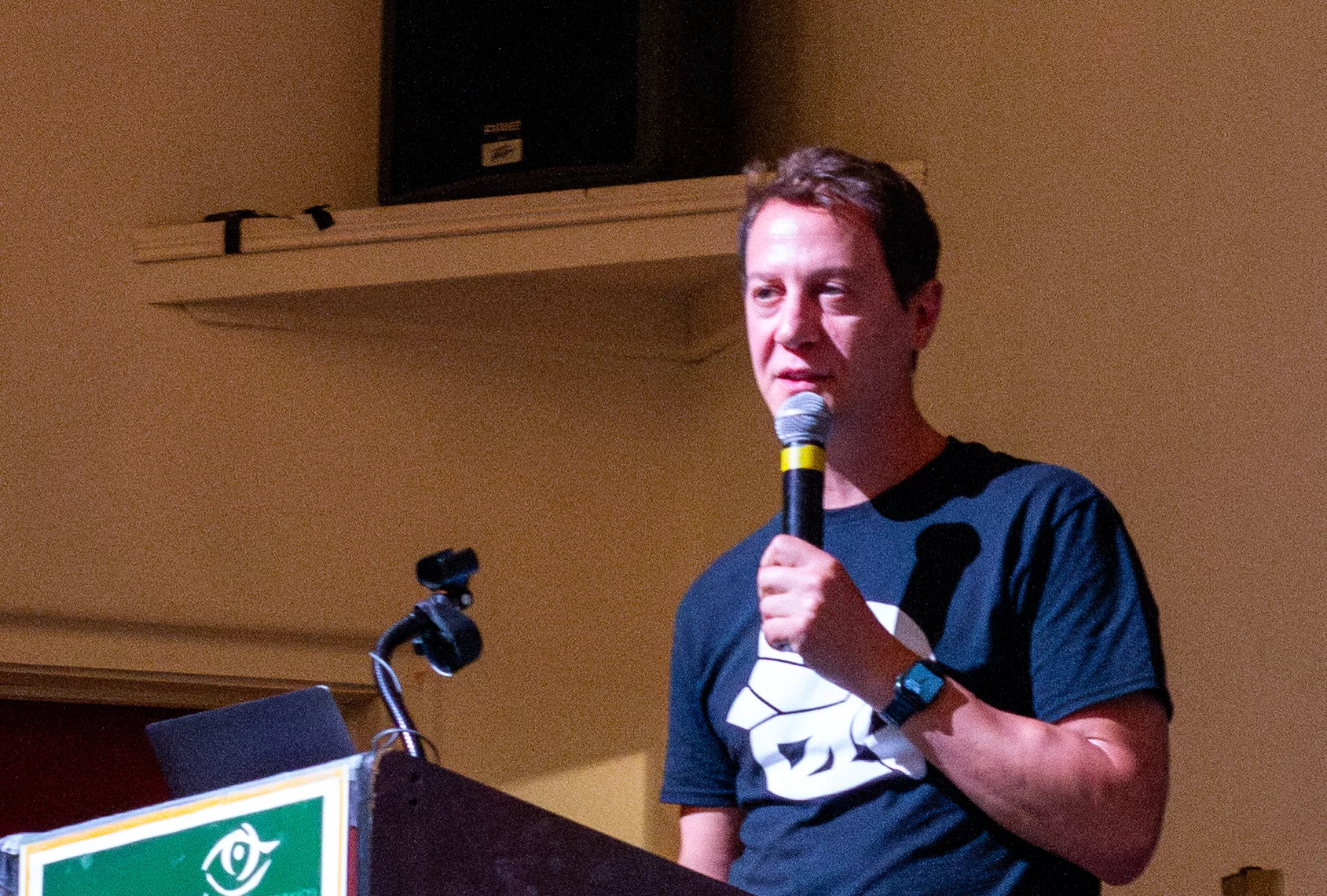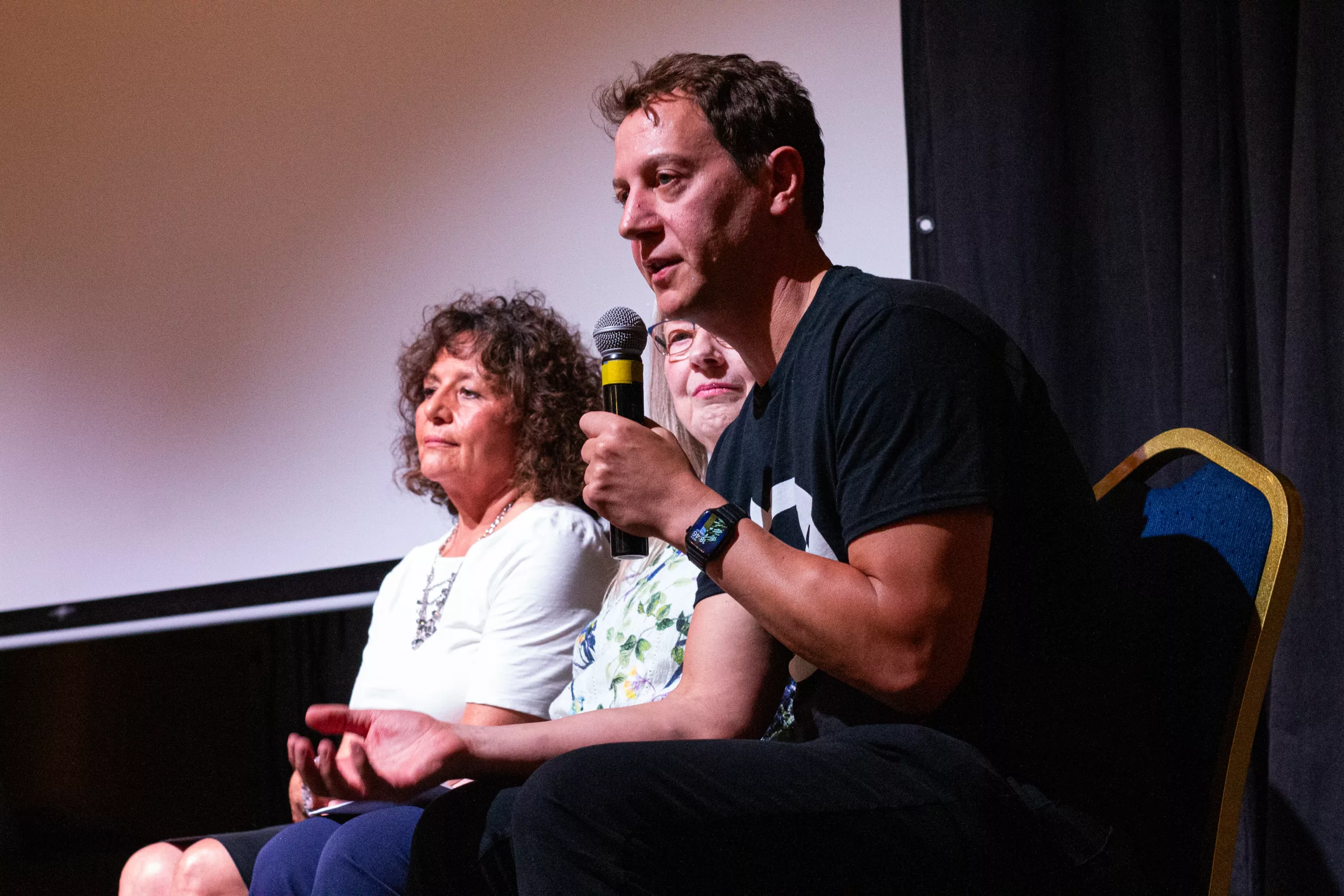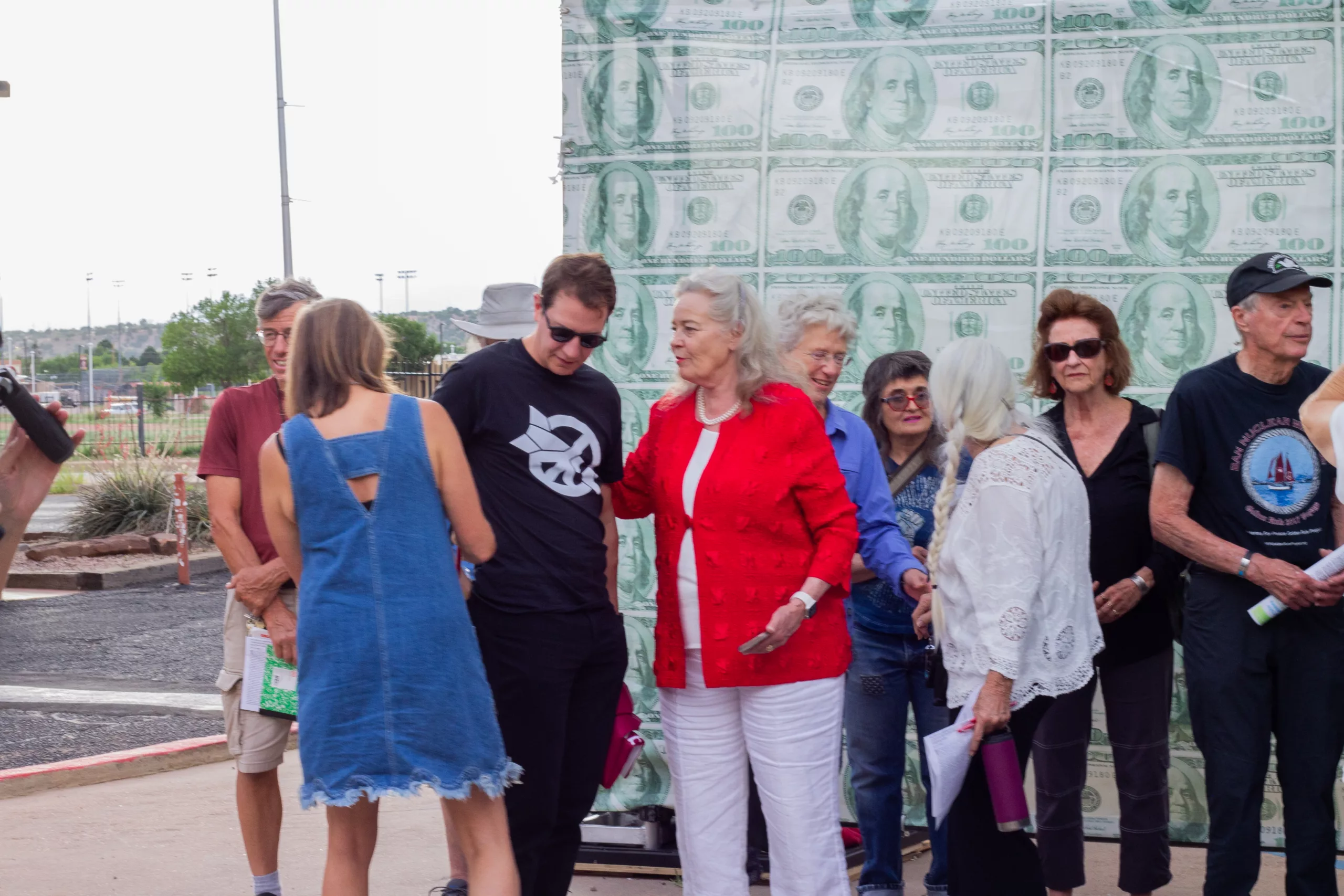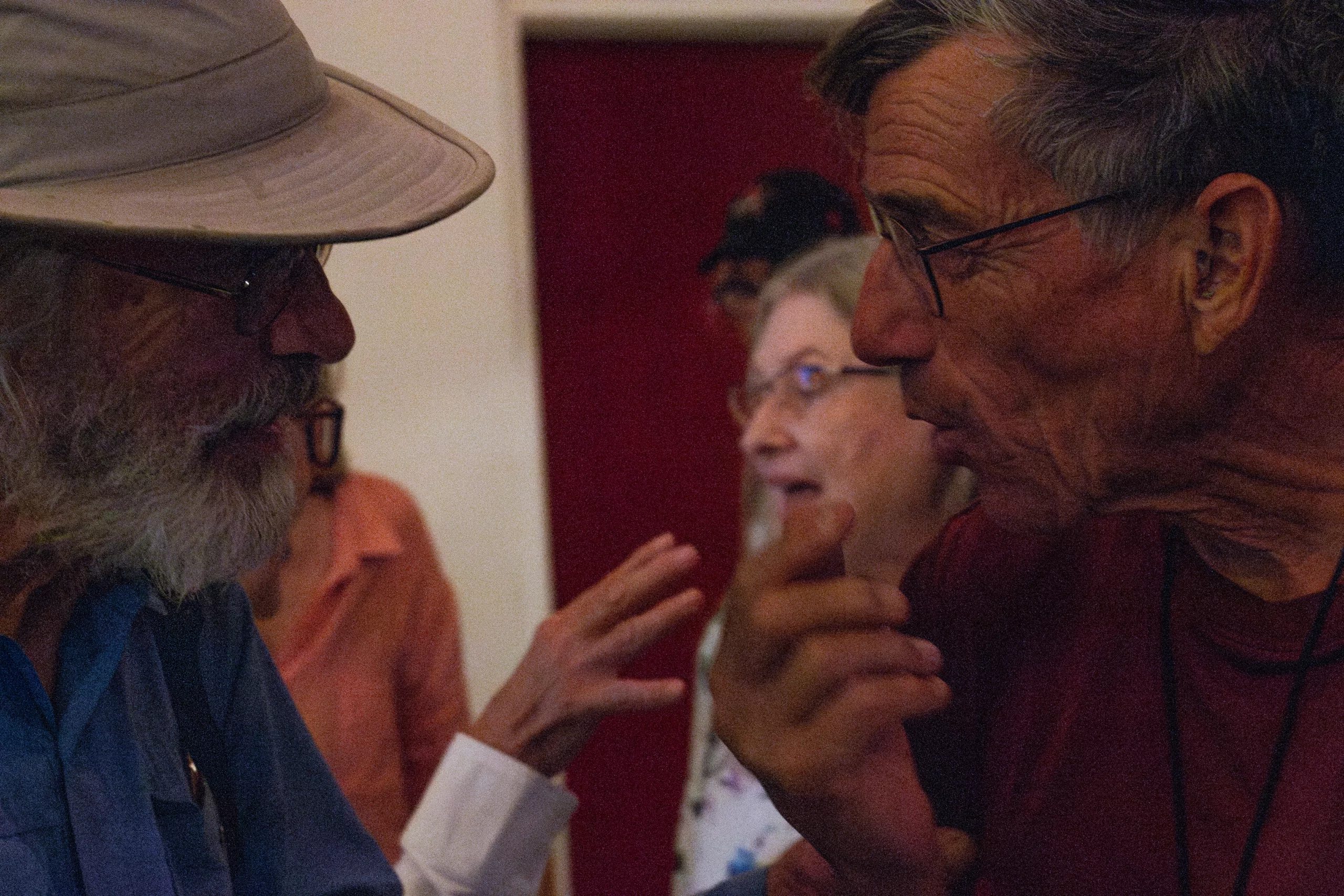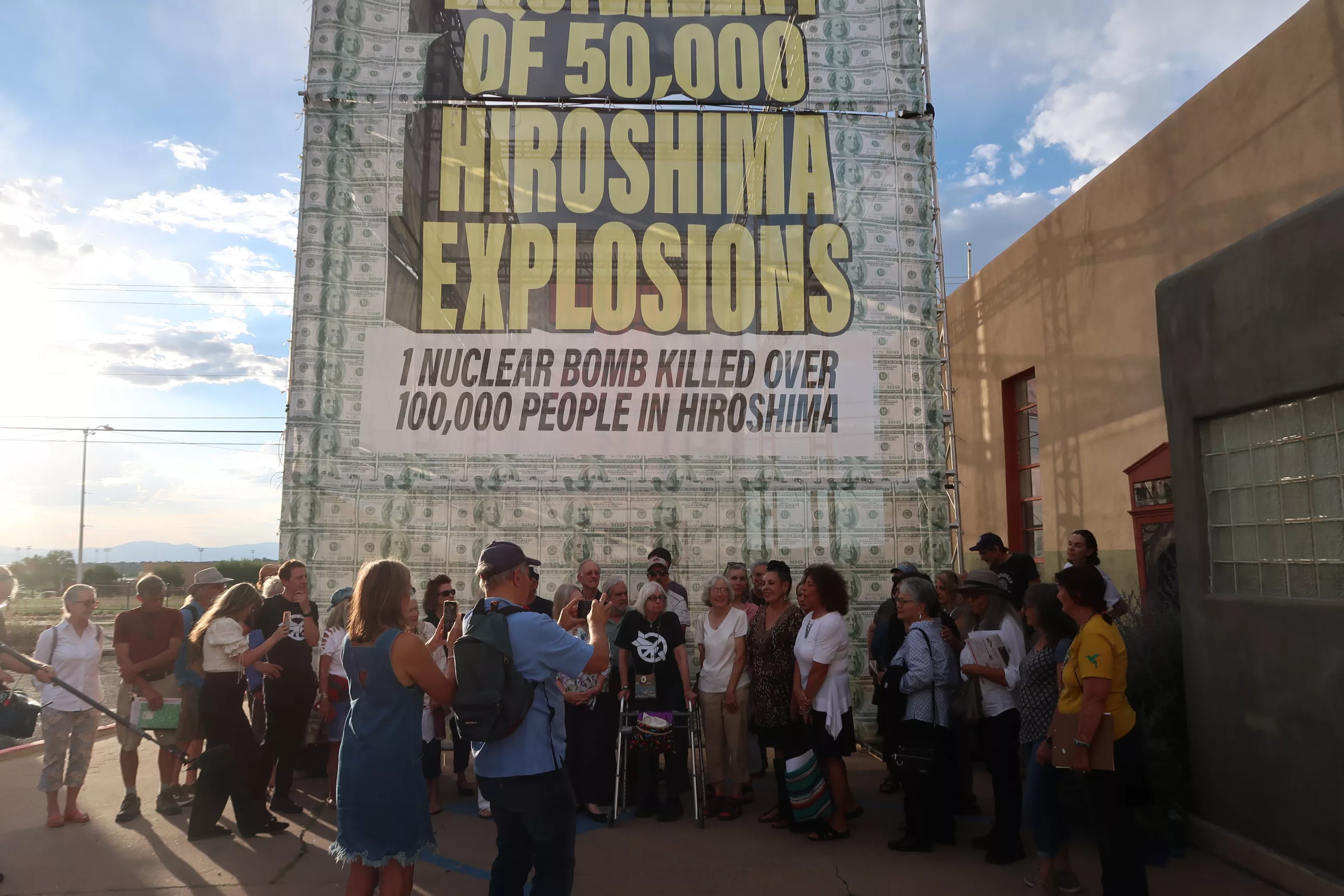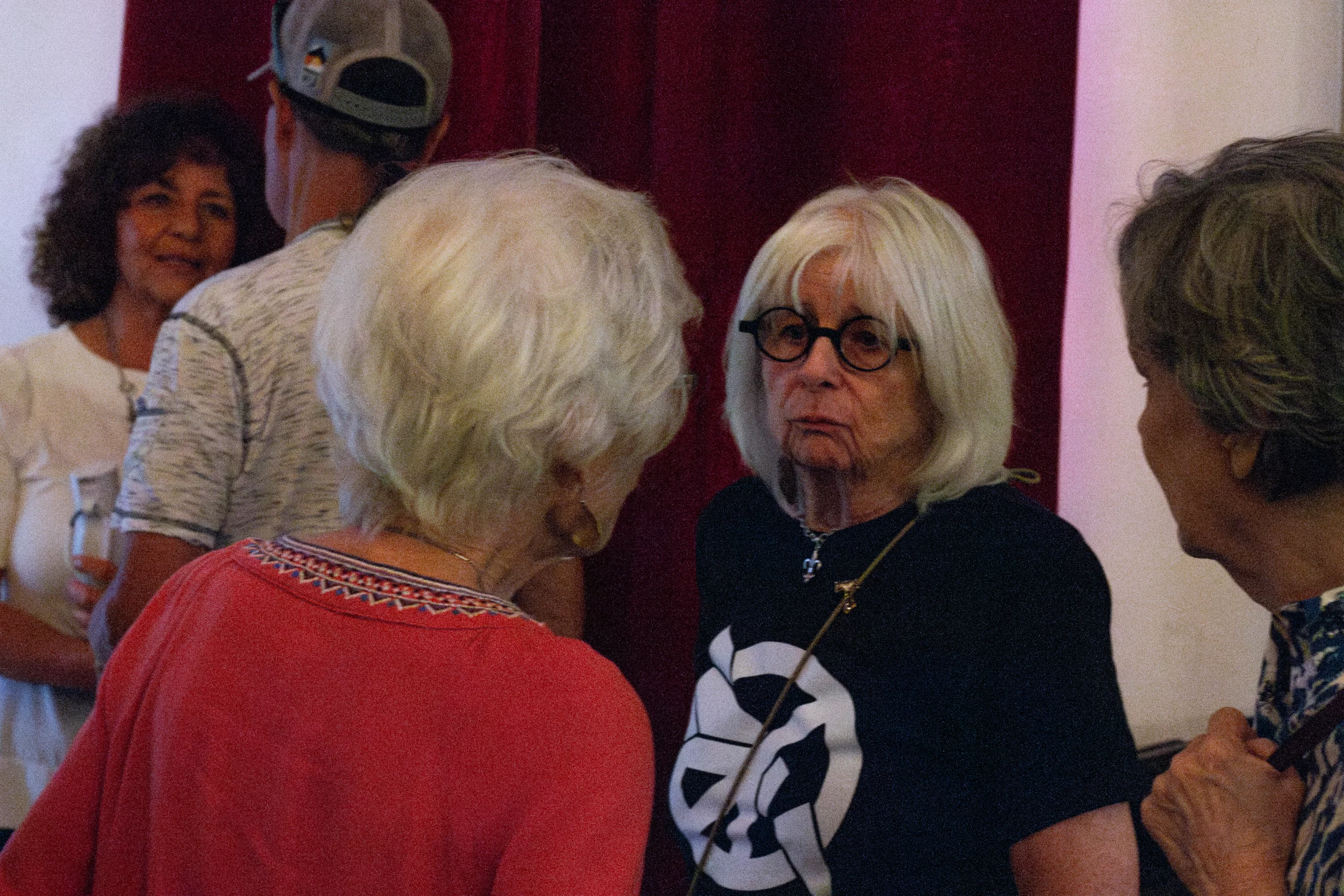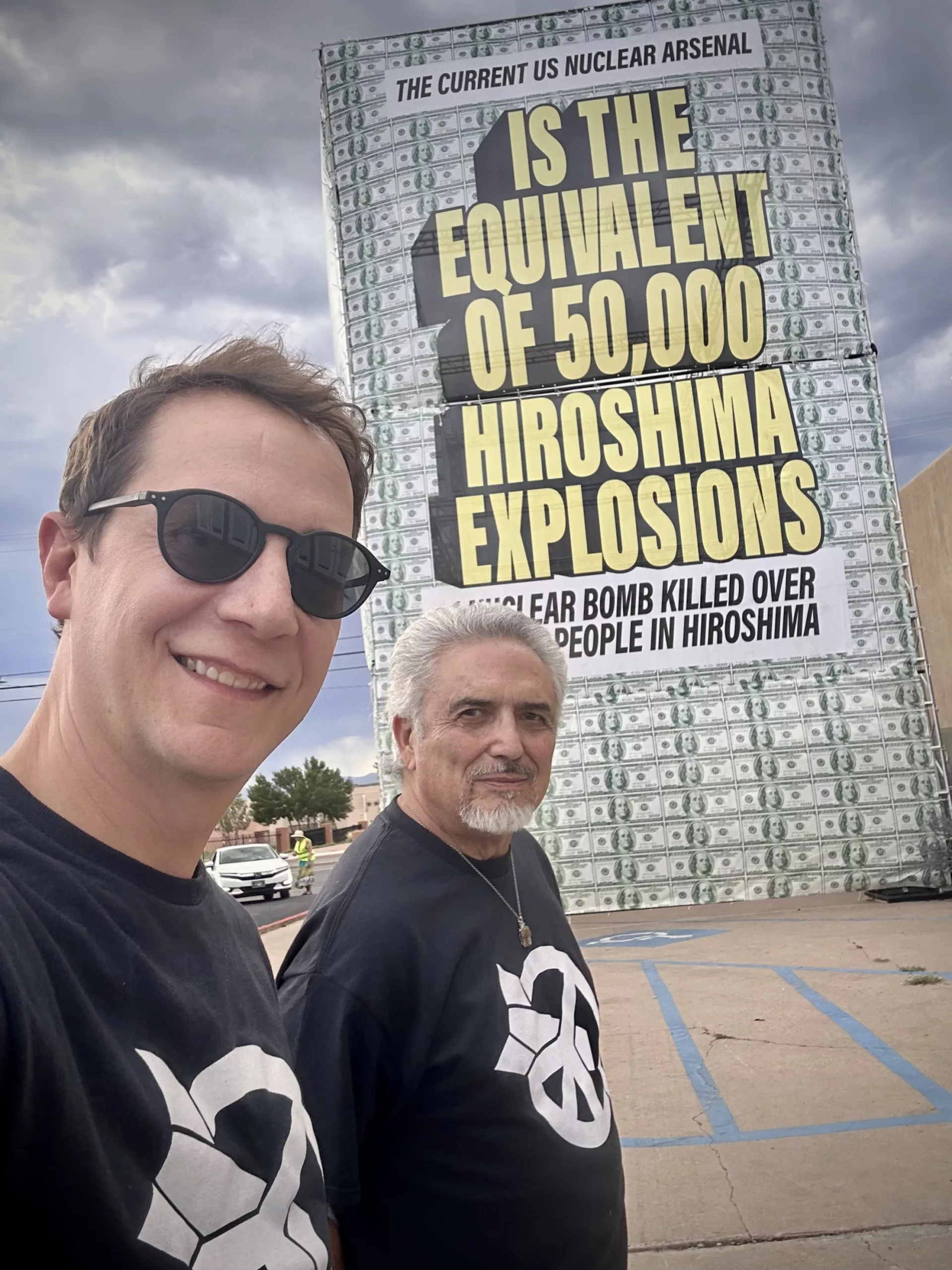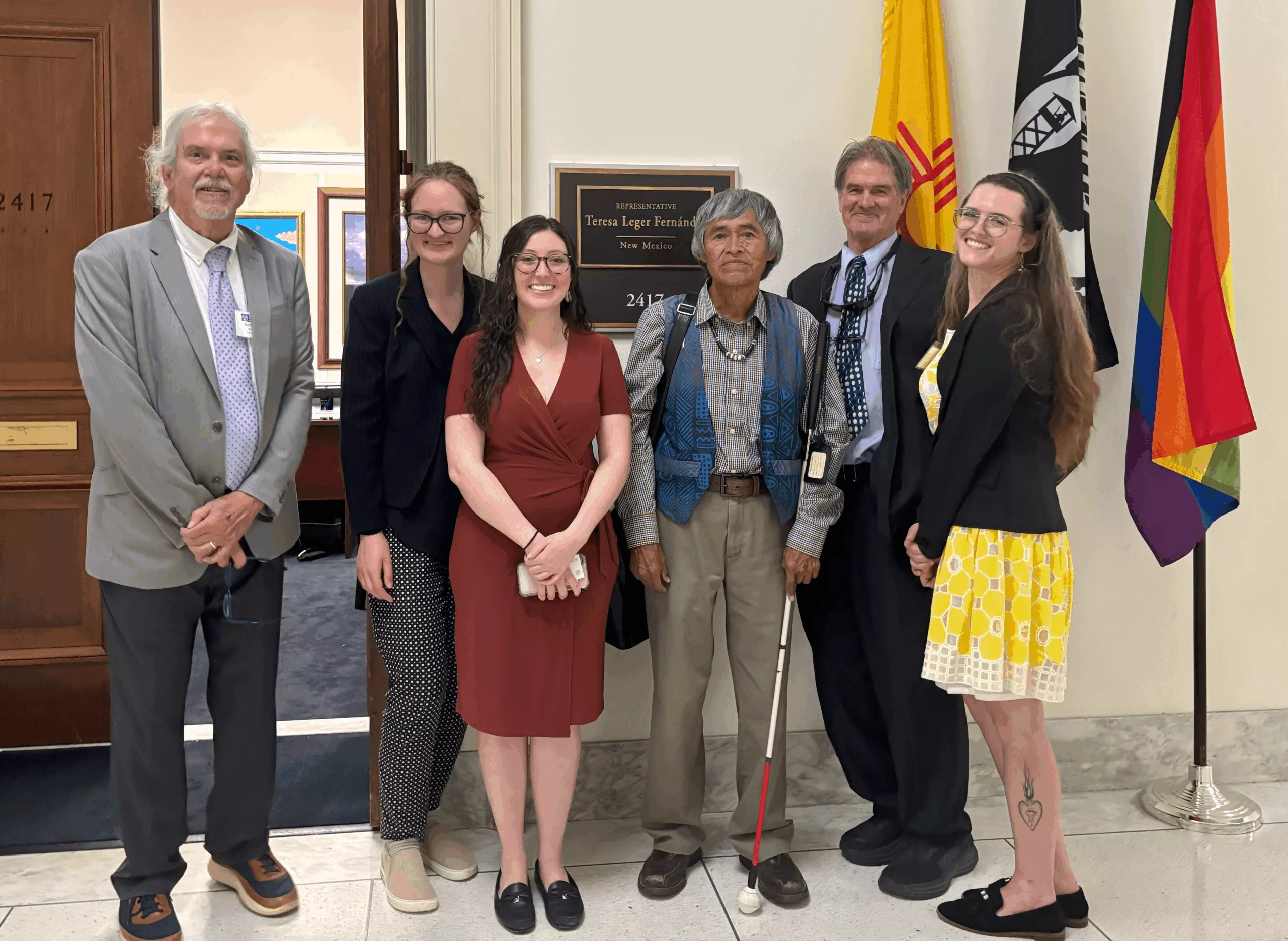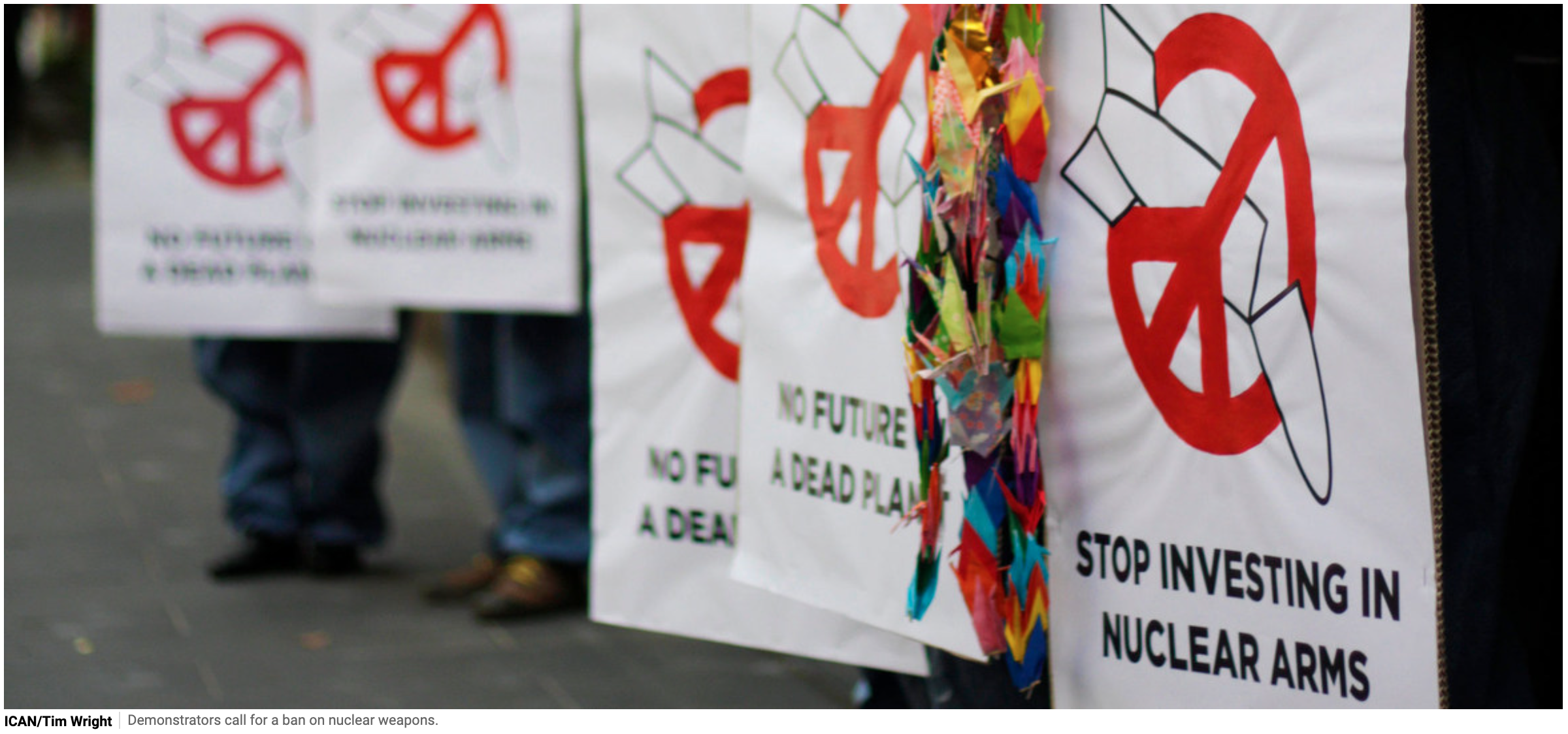New Article about “Participatory Democracy in Action” Describes WIPP Permit Negotiations
Thanks to our friends at Concerned Citizens for Nuclear Safety for this article:
In an essay for NYU’s Democracy Project, David F. Levi, a former federal judge and director emeritus of the Bolch Judicial Institute at Duke Law, reflected on the negotiations he facilitated in New Mexico about the renewal of the hazardous waste permit for the Waste Isolation Pilot Plant (WIPP), a deep geologic repository for plutonium-contaminated waste generated in the fabrication of nuclear weapons. Judge Levi’s essay is entitled “Participatory Democracy in Action.” He wrote:
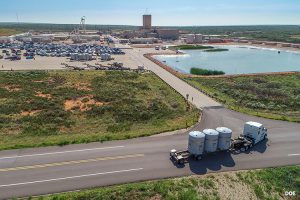 “A couple of years ago, I was asked to mediate a dispute between the U.S. Department of Energy (DOE) and the New Mexico Environment Department (NMED) concerning the renewal of a required state permit for DOE’s Waste Isolation Pilot Plant (WIPP), the nation’s only deep underground nuclear waste storage facility, located outside of Carlsbad, New Mexico. I thought I could help the two government entities but quickly came to realize that under the mediation procedures followed by New Mexico, the mediation would also involve citizen groups whose ultimate concurrence was essential to any complete resolution. This was entirely new to me.
“A couple of years ago, I was asked to mediate a dispute between the U.S. Department of Energy (DOE) and the New Mexico Environment Department (NMED) concerning the renewal of a required state permit for DOE’s Waste Isolation Pilot Plant (WIPP), the nation’s only deep underground nuclear waste storage facility, located outside of Carlsbad, New Mexico. I thought I could help the two government entities but quickly came to realize that under the mediation procedures followed by New Mexico, the mediation would also involve citizen groups whose ultimate concurrence was essential to any complete resolution. This was entirely new to me.
“In this case, there were seven such citizen groups entitled to participate and representing a variety of points of view. There was one group representing some of the government and business leaders of the town of Carlsbad who favored permit renewal on terms ensuring the continued long-term operation of WIPP. There were six groups expressing a variety of concerns about nuclear waste coming to New Mexico. They sought a more restrictive permit.
“To my astonishment, over the course of four full days, we worked through the multitude of issues and came to complete agreement. Something magical had happened. Thanks to the goodwill of the DOE and its contractor, the remarkable daily attendance and attentiveness of the NMED Secretary and the measured and well-informed way in which the various citizen groups made their points, we were able to find consensus and craft permit language that was acceptable to everyone.
“For me, as a former judge and mediator, the experience was thrilling. It was an experience of participatory democracy in action that made me proud of our fellow citizens and our government. Three aspects of the experience stand out. First, everyone in the room had taken responsibility for the way in which our nation’s only deep underground nuclear storage facility would be operated for the next 10 years. The citizen participants were not just making suggestions; they were assuming many of the attributes of decision makers. Second, all participants were advocating, compromising, and collaborating on behalf of what they saw as the public interest. These are the essential skills of democracy—the civic virtues so central to the Founders’ vision of what would make democracy work in America—and they require practice. Finally, over four days around a table, the citizens were able to take the measure of the DOE and NMED representatives. They came to realize, as I did, that these public servants, as well as the DOE contractor, were very well-informed, experienced, and intentioned. The government representatives had a similar experience of coming to appreciate the citizen questions and points of view. A government that relies on trust needs this kind of interaction to maintain that trust.
“It seems our democracy would be strengthened if we could extend the benefits of this kind of participatory structure to other areas of our legal and regulatory systems.”
“In Democracy in America, Alexis de Tocqueville made some of these points in reference to the jury trial in civil cases. He emphasized the importance of the civil jury trial as a free “public school” [https://contextus.org/Tocqueville,_Democracy_in_America_(1835),_Book_I,_Chapter_XVI_Causes_Mitigating_Tyranny_In_The_United_States_(Part_II).13?ven=Gutenberg&lang=en]  educating jurors in the democratic virtues and skills and teaching them to assume responsibility. In the same vein, every trial judge I know would attest to the importance of the jury experience for building confidence in the courts. After a trial, judges often hear words of gratitude from jurors who are deeply impressed by the legal process and are honored to have participated despite their initial dismay at being called to jury service. Sadly, the number of jury trials has diminished, particularly in federal court. Reversing that trend is a worthy goal, particularly for a branch of government that depends so heavily on public confidence.
educating jurors in the democratic virtues and skills and teaching them to assume responsibility. In the same vein, every trial judge I know would attest to the importance of the jury experience for building confidence in the courts. After a trial, judges often hear words of gratitude from jurors who are deeply impressed by the legal process and are honored to have participated despite their initial dismay at being called to jury service. Sadly, the number of jury trials has diminished, particularly in federal court. Reversing that trend is a worthy goal, particularly for a branch of government that depends so heavily on public confidence.
“As a final reflection: any persons involved as litigants will have an experience of the legal system. The experience can advance their sense of agency and participation, their ability to disagree civilly, and their trust in the courts. But how can these objectives be obtained when so many Americans cannot afford a lawyer? We can do so much better to provide understanding of and access to our justice system.”
The six New Mexico based non-governmental organizations were Citizens for Alternatives to Radioactive Dumping (CARD), Concerned Citizens for Nuclear Safety (CCNS), Conservation Voters New Mexico (CVNM), Nuclear Watch New Mexico, Southwest Alliance for a Safe Future (SAFE), and Southwest Research and Information Center (SRIC). The individual was Steve Zappe, a grandfather and former NMED WIPP Program Manager.
“A House of Dynamite” New Netflix Nuclear Catastrophe Film: Fiction, for Now
The reviews are rolling in for “A House of Dynamite,” which premiered in Europe earlier this month before coming to the U.S. on October 10th, with a full Netflix release scheduled for the 24th. Here’s the trailer, and see the schedule for Santa Fe theater showings here:
This Week! Santa Fe Theater Screenings for the Film “A House of Dynamite”
I attended one of these screenings last night, and I’ll let the professional critic reviews give the gist:
The Kathryn Bigelow thriller looks at what might happen if a ballistic missile were headed to the U.S. The director hopes the movie will start a conversation. New York Times: At Venice, ‘A House of Dynamite’ Is Scarier Than Most Horror Films
“The Netflix thriller captures from multiple perspectives the White House response to an unattributed missile launch headed for a major U.S. city in the harrowing 20 minutes until projected impact…”An unrelenting chokehold thriller so controlled, kinetic and unsettlingly immersive that you stagger out at the end of it wondering if the world will still be intact.” ‘A House of Dynamite’ Review: Idris Elba and Rebecca Ferguson in Kathryn Bigelow’s Precision-Tooled, Viscerally Unsettling Nail-Biter
“Told from the perspective of soldiers at a remote Alaskan missile base, staffers in the White House situation room, military officials at US Central Command (CENTCOM), and the president of the United States, the film weaves an overlapping timeline to show how the United States would respond to a missile attack…The film doesn’t want viewers to ask themselves how to thwart a nuclear attack on the United States. Rather, it wants the viewer to question the value of having nuclear weapons at all. ‘None of this makes sense,’ the President (Idris Elba) bemoans, ‘Making all these bombs and all these plans.'”
“A House of Dynamite is a terrifying examination of how terribly wrong things can go even with highly competent people in charge…But that’s also not necessarily the world we’re living in…The film shows why the worst can happen, even when competent, well-meaning people are trying to do the right thing.
But what if competence and decency are in short supply?” A House of Dynamite: Bigelow’s latest thriller shows why nuclear bombs are only part of the danger
This film left me reeling with tension and anxiety and exactly as the Times article titles it, is scarier than most horror films. Unlike ‘Oppenheimer,’ which largely glorified the invention of the atomic weapon, ‘A House of Dynamite’ makes it impossible to ignore the threat that nuclear weapons pose to our world. Working backwards from perspectives, and focused on how we can actually improve our odds of keeping this story a fictional one, here is what struck me most about this film:
-
-
Only one person decides what happens. But the real threat isn’t one reckless leader — it’s a reckless system. The final segment of the film features the “nuclear football” heavily, a briefcase containing launch procedures and options. In the United States, the president holds the sole and absolute authority to order the use of nuclear weapons. In the film, there are many voices in the President’s ear, but two primary perspectives quickly emerge after the defense fails and the ICBM remains inbound to its U.S. target: “One side advocates a retaliatory strike; the other, nothing. ‘It’s surrender or suicide,’ one adviser tells the President,” – thebulletin.org. The military aide carrying the nuclear football is tasked with providing the President the list of options if retaliation is chosen. An absolute must-read, Daniel Ellsberg’s book “The Doomsday Machine” breaks down many of the themes in the film with pure and terrifyingly honest account of Cold War-era nuclear strategy. In terms of launch authority, he describes how the inherent instability of the delegated command structure of the nuclear apparatus makes accidental or unwanted war an ever-present danger.
-
LANL tritium containers to head to Texas after last treatment
Four flanged tritium waste containers have been depressurized and transported to Los Alamos National Laboratory’s Weapons Engineering Tritium Facility, where they will be treated further before heading out-of-state for disposal.
By Alaina Mencinger amencinger@sfnewmexican.com | October 15, 2025 santafenewmexican.com
The containers’ final destination is Waste Control Specialists, a West Texas facility that handles the storage and disposal of radioactive waste.
The more than 1,300-acre facility in Andrews County is located on an approximately 14,000 acre property, which is sited on a thick clay formation which the company describes as “nearly impermeable.”
New documents have been added to the Los Alamos Legacy Cleanup Contract Electronic Public Reading Room.
All legacy cleanup documents required to be posted after April 30, 2018, are available on the site linked above.
For legacy cleanup documents that were posted prior to April 30, 2018, please visit the LANL electronic public reading room.
- Review, Notice of Completion of Off-Site Waste Shipments for Final Disposal, Activities 3.1.5, 3.1.8, and 3.3.4, Compliance Plan, Site Treatment Plan, Federal Facility Compliance Order Los Alamos National Laboratory [July 31, Aug. 21, 2025]
https://ext.em-la.doe.gov/GovFTPFiles/api/GetFiles/GetFile?fileName=EMID-703933_NMED_Review_STP_Shpmt_Jul_31_Aug_21_101525.pdf
Strong Political and Public Opposition Means Consolidated Interim Storage Facility (CISF) in NM “Impossible in the Near Future”
NEW UPDATE OCTOBER 10, 2025:
Holtec abandons plan to build New Mexico storage facility for spent nuclear fuel
This is excellent news. The Governor and state legislature (specifically Senator Jeff Steinborn and Representative McQueen) are to be commended for not allowing New Mexico to become the nation’s dumping ground for highly radioactive commercial spent fuel rods, especially when the Land of Enchantment has never had its own nuclear energy plant. Hard work from many New Mexicans made this happen.
So-called “interim” storage would never be interim when the federal government has failed for more than four decades to find a permanent repository for these lethal wastes. This also shows how hollow all the hype is about the claimed renaissance of nuclear power, when on the front end the industry can’t survive without taxpayer handouts, and on the back end can’t solve its radioactive waste problem.
Holtec’s quote that “New Mexico’s acquiescence is necessary” for interim storage to go forward is interesting, implying that we have to surrender as the nuclear colony that we are. Well, guess what, we didn’t surrender, and I predict you’ll see more of this. Moreover, whether you’re pro-nuclear or anti-nuclear, Holtec is an ethically questionable company, which is why the attorneys general of New Jersey and Massachusetts have sued it.
Adiós and good riddance, Holtec!
New York Times: Tax Break Scandal Leads to $5 Million Fine for N.J. Energy Company
SEE MORE:
Nuclear Weapons Issues & The Accelerating Arms Race: September 2025
Nuclear Weapons Update:
Putin has offered Trump a one-year extension of the numerical cap on strategic nuclear weapons in the new Strategic Arms Reduction Treaty which is 1,550 warheads (however, B52s are counted as one warhead while they can carry a dozen). New START expires in February 2026, which will be the first time the world will be without any nuclear arms control treaties since the mid-1970s. Trump has said it sounded like a good idea.
Note: New START ratification in 2010 provided the opportunity for Republicans in the Senate to attach the condition of $88 billion for nuclear weapons “modernization” that has since metastasized to ~$2 trillion. Nuclear disarmament must be prioritized as the ultimate goal over simply continued arms control.
A mere extension of the numerical cap would not involve Congressional ratification. The extension of New START’s numerical cap is in part to allow for a year in which to begin negotiations for a treaty replacement.
Plutonium Pit Production:
A draft plutonium pit production programmatic environmental impact statement is expected to be released next year in early 2026.
Accelerating Arms Race:
Is North Korea set to become world’s ‘fourth ICBM power’ after missile breakthrough? | Park Chan-kyong | South China Morning Post | September 11, 2025
A new era in North Korea’s missile programme may be dawning, as analysts warn of an imminent test launch of an intercontinental ballistic missile capable of carrying multiple warheads to the US mainland. Fresh from his appearance at China’s Victory Day parade in Beijing last week, North Korean leader Kim Jong-un personally oversaw the trial of a lighter, more robust solid-fuel ICBM engine, state media reported on Tuesday, touting the achievement as a “strategic” breakthrough.
Saudi Arabia signs a mutual defense pact with nuclear-armed Pakistan after Israel’s attack on Qatar | MUNIR AHMED & JON GAMBRELL | AP NEWS | September 18, 2025
DUBAI, United Arab Emirates (AP) — Pakistan’s defense minister says his nation’s nuclear program “will be made available” to Saudi Arabia if needed under the countries’ new defense pact, marking the first specific acknowledgment that Islamabad had put the kingdom under its nuclear umbrella.
Defense Minister Khawaja Mohammad Asif’s comments underline the importance of the pact struck this week between Pakistan and Saudi Arabia, which have had military ties for decades.
The move is seen by analysts as a signal to Israel, long believed to be the Middle East’s only nuclear-armed nation. It comes after Israel’s attack targeting Hamas leaders in Qatar last week killed six people and sparked new concerns among Gulf Arab nations about their safety as the Israel-Hamas war devastated the Gaza Strip and set the region on edge.
Russia suspected of helping North Korea build nuclear submarines, Seoul investigating | Park Chan-kyong | South China Morning Post | September 18, 2025
South Korea is investigating reports that Russia has supplied North Korea with nuclear submarine reactor modules, a move analysts see as highly plausible and one that could mark a breakthrough in Pyongyang’s decades-long push for a nuclear-powered navy… At the 8th Party Congress in January 2021, North Korea declared five core defence goals, including the development of nuclear-powered submarines and submarine-launched strategic nuclear weapons.
China Hardens Military Stance Against U.S. With Nuclear Weapons and Tough Talk | Brian Spegele | The Wall Street Journal| September 18, 2025
China played down its rapidly rising military might for years. In the past few weeks, Beijing has broadcast a steady drumbeat of firepower displays and muscular rhetoric, carrying an unmistakable warning for the U.S… Part of China’s confidence stems from the rapid growth of its firepower. The Pentagon estimates that China’s stockpile of nuclear warheads has more than doubled since 2020, alongside a growing array of options to launch those weapons, from mobile ground-launch systems to increasingly stealthy submarines.
Holtec Pulls Out of New Mexico Spent Nuclear Fuel Interim Storage Project
Holtec International has confirmed it is canceling plans to build a consolidated interim storage facility for spent nuclear fuel in southeastern New Mexico.
By Radwaste Solutions | October 9, 2025 ans.org
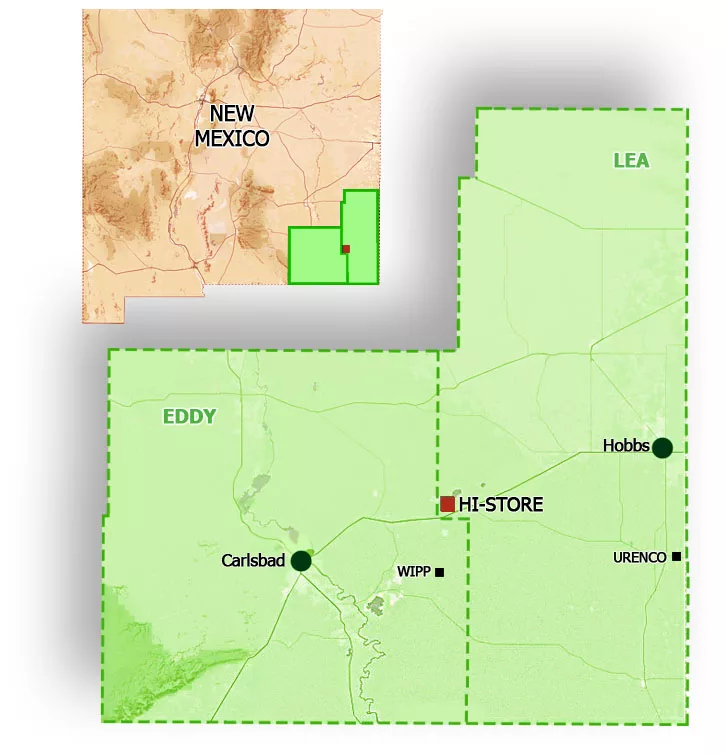
Named the HI-STORE CISF, the facility would have stored up to 10,000 canisters of commercial SNF on land owned by the Eddy-Lea Energy Alliance (ELEA) near the towns of Carlsbad and Hobbs.
“After discussions with our longtime partner in the HI-STORE project, the Eddy-Lea Energy Alliance, and due to the untenable path forward for used fuel storage in New Mexico, we mutually agreed upon canceling the agreement. This allows for ELEA to work to redevelop the property in a manner that fits their needs and allows Holtec to work with other states who are amenable to used fuel storage based on the recent DOE work on public education and outreach,” Holtec said in a statement (emphasis added).
Following the U.S. Supreme Court’s June ruling in NRC v. Texas, which found that petitioners did not have standing to challenge the Nuclear Regulatory Commission’s licensing of Interim Storage Partners’ CISF in Texas, Holtec said it expected to have its HI-STORE CISF license reinstated, allowing the company to move forward with the project. Holtec and ISP’s NRC licenses were vacated by the 5th Circuit Court of Appeals in a 2023 ruling.
Despite the court’s decision, New Mexico Gov. Michelle Lujan Grisham said she remained committed to preventing the HI-STORE CISF from being built. In 2023, New Mexico passed a bill barring the storage and disposal of high-level radioactive waste in New Mexico without the state’s explicit consent.
The AI Doomsday Machine Is Closer to Reality Than You Think
“Most troubling to experts on AI and nuclear weapons is that it’s getting harder and harder to keep decisions about targeting and escalation for nuclear weapons separate from decisions about conventional weapons.”
“There is no standing guidance, as far as we can tell, inside the Pentagon on whether and how AI should or should not be integrated into nuclear command and control and communications,” says Jon Wolfsthal, director of global risk at the Federation of American Scientists.
By Michael Hirsh | September 2, 2025 politico.com
Jacquelyn Schneider saw a disturbing pattern, and she didn’t know what to make of it.
Last year Schneider, director of the Hoover Wargaming and Crisis Simulation Initiative at Stanford University, began experimenting with war games that gave the latest generation of artificial intelligence the role of strategic decision-makers. In the games, five off-the-shelf large language models or LLMs — OpenAI’s GPT-3.5, GPT-4, and GPT-4-Base; Anthropic’s Claude 2; and Meta’s Llama-2 Chat — were confronted with fictional crisis situations that resembled Russia’s invasion of Ukraine or China’s threat to Taiwan.
Director Kathryn Bigelow is Sounding the Nuclear Alarm – Washington Post New Review
“A House of Dynamite” asks: How would the White House respond in the face of a nuclear attack?
By Max Boot | October 2, 2025 washingtonpost.com
VIEW MORE: “A House Of Dynamite” Q&A w/ Director Kathryn Bigelow, Tracy Letts, Jared Harris, And More At New York Film Fest —
80th Commemorations of Ban the Bomb – Trinity, Hiroshima & Nagasaki Remembrances in New Mexico
Exchange Monitor: DNFSB makes agency fixes, but needs members, GAO finds
The Defense Nuclear Facilities Safety Board (DNFSB) has tackled all but a few third-party recommendations to improve its culture over the past decade but suffers from a depleted board, according to a new report.
By ExchangeMonitor | September 5, 2025 santafenewmexican.com
Progress is tough with the five-person board probably…
China Hardens Military Stance Against U.S. With Nuclear Weapons and Tough Talk
Xi positions Beijing as powerful center of new global order as security forum convenes in capital
By Brian Spegele | September 18, 2025 wsj.com
BEIJING—China played down its rapidly rising military might for years. In the past few weeks, Beijing has broadcast a steady drumbeat of firepower displays and muscular rhetoric, carrying an unmistakable warning for the U.S….
Saudi Arabia signs a mutual defense pact with nuclear-armed Pakistan after Israel’s attack on Qatar
While not specifically discussing the bomb, the agreement states “any aggression against either country shall be considered an aggression against both,” according to statements issued by both Pakistan’s Foreign Affairs Ministry and the state-run Saudi Press Agency.
By MUNIR AHMED and JON GAMBRELL | September 18, 2025 apnews.com
ISLAMABAD (AP) — Saudi Arabia and nuclear-armed Pakistan have signed a mutual defense pact that defines any attack on either nation as an attack on both — a key accord in the wake of Israel’s strike on Qatar last week.
The kingdom has long had close economic, religious and security ties to Pakistan, including reportedly providing funding for Islamabad’s nuclear weapons program as it developed. Analysts — and Pakistani diplomats in at least one case — have suggested over the years that Saudi Arabia could be included under Islamabad’s nuclear umbrella, particularly as tensions have risen over Iran’s atomic program.
COMMUNITIES FOR CLEAN WATER: LANL Radioactive Tritium Venting Fails to Provide Transparency, Assurance, and Respect for Local Communities
FOR IMMEDIATE RELEASE: September 18, 2025
Santa Fe, NM — As NNSA and LANL continue operations to depressurize Flanged Tritium Waste Containers, Communities for Clean Water (CCW) calls out federal agencies for issuing vague assurances instead of transparent, verifiable data — and for dismissing community concerns with contradictory and incomplete statements that disregard what independent experts have found, the Department of Energy’s (DOE) own legal obligations, and the New Mexico Environment Department’s (NMED) acknowledgment that LANL has a long record of compliance failures.
“How can our communities be expected to trust LANL when they won’t give us access to the raw, real-time monitoring data – independently verified by the EPA,” asks Joni Arends with Concerned Citizens for Nuclear Safety. “Without this transparency, LANL is continuing a legacy of empty assurances, not accountability.”
Key Concerns:
-
Lack of real-time transparency – Since Friday (Sept. 12), the public has been forced to rely on NMED’s Facebook page for piecemeal updates. While LANL’s website provides very brief daily summaries, no near-real-time monitoring dashboard from DOE, NNSA, or LANL has been made available.
-
Vague assurances, not real information – NNSA’s updates claim “no tritium was released” while simultaneously telling the public to expect “very low levels of tritium” for subsequent venting. Without numbers, monitoring data, or detection thresholds, these phrases do not provide reassurance.
-
Weather risks – LANL has not disclosed thresholds for wind, rain, or humidity that would postpone venting. Communities watch weather shifts in real time but are left in the dark about how safety decisions are being made.
-
Dismissal of public health concerns – When asked for plain-language guidance that NMED stated LANL would provide, LANL responded only with “no offsite impact anticipated.” This is not meaningful and reassuring guidance, it’s a blanket dismissal that disregards independent expert findings and fails to meet DOE’s obligations to protect vulnerable populations.
-
Ignoring daily lifeways – Avoiding Pueblo Feast Days is not enough. This is harvest season, when outdoor cultural events, youth programs, and farming are in full swing. LANL’s scheduling continues to disregard these realities.
Unanswered Questions
Independent experts and community advocates have raised critical unanswered questions:
-
Unclear “depressurization” – LANL said “no internal pressure was found” in a container, but also claimed it was “depressurized.” If no pressure existed, what was released?
-
Unanswered helium questions – NMED stated helium was released, but LANL has not explained its origin. Was it introduced at sealing of the outer container, or a decay product of tritium?
-
Monitoring limits undisclosed – LANL has not disclosed the detection limits of its monitoring equipment. Readings “indistinguishable from zero” could still mask releases.
DOE NNSA Gives Misleading Statements on Native America Calling
On a recent Native America Calling program, DOE NNSA’s Los Alamos Field Office Deputy Director Pat Moss compared LANL venting to global natural tritium stocks. Independent expert Dr. Arjun Makhijani pointed out this comparison as misleading: “The problem is not global background, but local contamination. If venting occurs in rain and calm winds, local rainfall could exceed U.S. drinking water standards by hundreds to thousands of times.”
In their most recent public meeting, LANL admitted that infants could receive three times the radiation dose as adults. During the interview, Dr. Makhijani pressed this point – if adults are modeled at 6 mrem, that means infants could be at 18 mrem, nearly double the EPA’s 10 mrem compliance limit. Instead of addressing this directly, Mr. Moss provided a stock line, “We will be compliant with the regulatorily imposed release threshold and will be doing the calculations per the regulation.”
That is exactly the problem – hiding behind regulatory caps while ignoring clear evidence that infants, our most vulnerable, face exposures above legal limits.
DOE NNSA also pointed to the Defense Nuclear Facilities Safety Board (DNFSB) – an independent federal oversight body created by Congress – as if it had declared the tritium venting operation as “fully protective of the public”. That is misleading. First, the DNFSB has been operating without a quorum for months, limiting its ability to issue independent recommendations. Second, what the Board staff said in its July 2025 presentation was that the overall nuclear safety risk to the public is low if DOE’s proposed controls are followed. The DNFSB has also flagged ongoing safety concerns at LANL including deficiencies in Area G’s safety analysis and risk to workers.
First of four containers of tritium waste at LANL has been vented
The first of four flanged tritium waste containers awaiting removal from Los Alamos National Laboratory has been vented, the New Mexico Environment Department announced Tuesday afternoon.
By Alaina Mencinger amencinger@sfnewmexican.com | September 16, 2025 santafenewmexican.com
The container can now be moved for treatment at LANL and then, eventually, to an off-site disposal area.
No internal pressure was found in the first container, according to the National Nuclear Security Administration, suggesting the inner containers in the flanged tritium waste container hadn’t leaked. Air monitoring did not show an increase of tritium beyond background levels, the federal agency wrote.
No tritium emissions were released, the Environment Department wrote in its Tuesday post on X, formerly Twitter. Both the state agency and the U.S. Environmental Protection Agency are monitoring the process.
The depressurization of the containers is set to continue at 7 a.m. Wednesday, although the NNSA noted the schedule is subject to change due to weather. The four containers will be vented one at a time over an estimated two-week period.
*The featured image differs from the article photo due to usage rights.
New Mexicans Can Save the DNFSB; Contact Our Senators Today
From our friends at Concerned Citizens for Nuclear Safety:
The independent Defense Nuclear Facilities Safety Board has been dwindling from a five-member board to one member and may disappear if we, the People, do not raise our voices to support its essential nuclear safety work. The Safety Board needs at least two new members. And that needs to get done by Saturday, October 18th. https://www.dnfsb.gov/about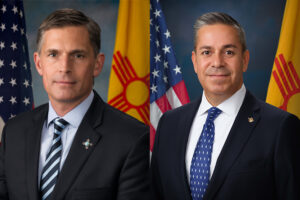
New Mexico U.S. Senators Heinrich and Lujan have key roles to play to ensure the Safety Board’s work continues unimpeded. https://www.heinrich.senate.gov/ and https://www.lujan.senate.gov/ Our voices of support are essential to ensure communities continue to receive the essential services of the Safety Board and its staff.
Right now members of the Safety Board’s staff are monitoring the venting of radioactive tritium from Area G at Los Alamos National Laboratory (LANL). Their expertise in the field of nuclear safety and their demonstrated competence and knowledge relevant to their independent investigative and oversight functions are an essential part of the process. They will be part of the follow-up once the venting of the four flanged tritium waste containers is completed. https://tewawomenunited.org/?s=tritium, https://www.ccwnewmexico.org/tritium, https://nuclearactive.org/
Not only does the Safety Board have staff at LANL, but also at Sandia National Laboratories in Albuquerque and at the Waste Isolation Pilot Plant, the burial site for plutonium contaminated nuclear weapons waste, near Carlsbad. https://ananuclear.org/facilities/
Russia suspected of helping North Korea build nuclear submarines, Seoul investigating
Analysts said such a technology transfer was plausible given Pyongyang’s support for Russia’s ongoing war in Ukraine
By Park Chan-kyong | September 18, 2025 scmp.com
South Korea is investigating reports that Russia has supplied North Korea with nuclear submarine reactor modules, a move analysts see as highly plausible and one that could mark a breakthrough in Pyongyang’s decades-long push for a nuclear powered navy…
Holy See tells nations at UN to end threat of nuclear weapons, even as deterrence
Amid a global arms race, ending the threat of nuclear war — and even the testing of nuclear weapons — is imperative, said the Holy See’s diplomat to the United Nations.
By Gina Christian, OSV News | September 8, 2025 catholicreview.org
Archbishop Gabriele G. Caccia, the Holy See’s U.N. permanent observer, shared his thoughts in a statement he delivered Sept. 4 at U.N. headquarters in New York, during the General Assembly High-level Plenary Meeting to Commemorate and Promote the International Day Against Nuclear Tests, observed that same day.
“The pursuit of a world free of nuclear weapons is not only a matter of strategic and vital necessity, but also a profound moral responsibility,” Archbishop Caccia in his remarks.
He pointed to the introduction of nuclear weapons — first detonated by the U.S. in 1945 over the Japanese cities of Hiroshima and Nagasaki, killing an estimated 110,000 to 210,000 people, during World War II — as unveiling to the world “an unprecedented destructive force.”
Historic peace vigil partially dismantled after Trump orders: ‘Take it down’
Law enforcement officials on Sunday removed parts of the White House Peace Vigil, which has sat just outside the White House for decades.
By Marissa J. Lang, The Washington Post | September 8, 2025 washingtonpost.com
But over the past week, it faced a new threat as Trump turned his attention to the vigil and federal officers picked apart the structure that shields protesters and their signs from the elements. The vigil is maintained by a rotating cast of volunteers who keep the protest going 24 hours a day, seven days a week.
On Friday, Brian Glenn, a correspondent for the conservative network Real America’s Voice, told the president during a gathering with reporters that there was “a blue tent” in front of the White House that was “an eyesore.” Trump initially said he was unaware of it, but he then quickly ordered its removal.
Photo by Sig. Chiocciola, Creative Commons: The White House Peace Vigil on March 30, 2025 staffed by volunteers, Philipos Melaku-Bello (left) and Joe Brown (right).
For 80 years, nuclear weapons have been the unused threat
Amid a global arms race, ending the threat of nuclear war — and even the testing of nuclear weapons — is imperative, said the Holy See’s diplomat to the United Nations.
By Matt Kelly, mkelly@virginia.edu, September 3, 2025 news.virginia.edu
In the 80 years since World War II, which ended with the use of two atomic bombs, the world has maintained a tenuous relationship with nuclear weapons.
Philip Potter, professor of public policy at the University of Virginia’s Frank Batten School of Leadership and Public Policy and director of the National Security Data and Policy Institute, said he worries about the current delicate nuclear balance.
“Eighty years of non-use is the product of both good diplomacy and a recognition of the potential consequences,” Potter said. “The fearsome power of nuclear weapons causes countries pause before they use them, but a great deal of work has also gone into nonproliferation and the management of crises to keep them away from the nuclear brink. In some ways the dynamics of the Cold War made managing the potential for nuclear confrontation easier.”
It’s a very different strategic scenario now, where there are nine nuclear powers and less capacity to manage them.
A House of Dynamite review – Kathryn Bigelow’s nuclear endgame thriller is a terrifying, white-knuckle comeback
★★★★★: Amid a global arms race, ending the threat of nuclear war — and even the testing of nuclear weapons — is imperative, said the Holy See’s diplomat to the United Nations.
By Peter Bradshaw, The Guardian | September 2, 2025 theguardian.com
Kathryn Bigelow has reopened the subject that we all tacitly agree not to discuss or imagine, in the movies or anywhere else: the subject of an actual nuclear strike. It’s the subject which tests narrative forms and thinkability levels.
Maybe this is why we prefer to see it as something for absurdism and satire – a way of not staring into the sun – to remember Kubrick’s (brilliant) black comedy Dr Strangelove, with no fighting in the war room etc, rather than Lumet’s deadly serious Fail Safe.
NEW UPDATED INFORMATION: MUST READ!!! PROVIDED BY: THE TULAROSA BASIN DOWNWINDERS CONSORTIUM — WHAT TO KNOW ABOUT THE COMPENSATION AVAILABLE THROUGH THE RECA PROGRAM
 SEEKING JUSTICE FOR THE UNKNOWING, UNWILLING, AND UNCOMPENSATED INNOCENT VICTIMS OF THE JULY 16, 1945 TRINITY BOMB
SEEKING JUSTICE FOR THE UNKNOWING, UNWILLING, AND UNCOMPENSATED INNOCENT VICTIMS OF THE JULY 16, 1945 TRINITY BOMB
A Message From Tina
The DOJ is now accepting claims and has provided guidance on the claims process. They will only accept mail in claims at this time. They have indicated that an electronic process will be implemented by the end of the year. For more information you can go to the DOJ website at: https://www.justice.gov/civil/reca
Please be careful when supplying documentation via the regular mail. If you decide to file this way you may want to send the documents via certified mail. Once the electronic process begins it will be easier to assure that your documents are safe and being handled properly with little to no risk.
There are organizations/attorneys who are soliciting people to file claims with them. They use all sorts of tactics to get people to believe their services are necessary and often guarantee results. Please be aware that if an entity files a RECA claim on your behalf they will charge a fee. They receive the check, deduct their fee, and then pay you.
There will be Radiation Exposure Screening and Education Program (RESEP) clinics in our State that will assist people with claims. The claims process is not necessarily difficult and we’ll be training people to assist with the application process when needed. We’ll also be looking to government agencies to cooperate in locating necessary documentation for the application process. PLEASE DO NOT TURN OVER YOUR RECORDS TO ANYONE THAT YOU ARE NOT SURE ABOUT. You can remain updated about the application process, the training we’re going to organize or other questions you might have by going to our website at: www.trinitydownwinders.com
What does the expansion of RECA do?
The Radiation Exposure Compensation Act program has been re-authorized and extended through Dec 31, 2028 but the application deadline is Dec 31, 2027.
Downwinders who lived in New Mexico for one year from 1944 through Nov. 1962 will be eligible and family members can apply on behalf of a deceased loved one.
There are 19 cancers that are covered by the expansion.
The cancers covered are:
Leukemia (except chronic lymphocytic Leukemia); Lymphoma (other than Hodgkins); Primary cancers of the Thyroid, Breast, Esophagus, Stomach, Pharynx, Small Intestine, Pancreas, Bile Duct, Gall Bladder, Salivary Gland, Urinary, Bladder, Brain, Colon, Ovary, Liver (unless cirrhosis/Hepatitis B present), and Lung.
Compensation for downwinders will be increased to $100,000 and Downwind coverage is expanded to cover the entire state of New Mexico
Coverage for uranium miners and workers would be expanded:
To workers through Dec 31, 1990
To core drillers and remediation workers
To cover additional kidney disease for uranium miners
To allow for combined work histories
What does this mean?
This is the biggest expansion of RECA in the history of the program and it wouldn’t have happened without the tireless advocacy of Senator Lujan, Representative Leger Fernandez, Senator Heinrich, Representative Stansbury and Representative Vasquez.
While it is a significant win, it still leaves out many impacted communities, including the parts of Nevada and Arizona not previously covered, along with Montana, Colorado, and Guam.
The 2-year extension will likely not be adequate time to get all the people in New Mexico who qualify enrolled and this bill does not have health care benefits for Downwinders. We will continue to fight for a longer extension and the addition of healthcare benefits. This is an important first step because it reinstates the program keeping it operational so people can continue to apply for benefits and get the help they need, and it shows that expansion is possible and provides an opportunity to address concerns raised about the cost of expansion.
We are grateful for the win and consider this a big step in the right direction. We look forward to the day that claims are successfully filed and the people of New Mexico begin to see the benefit of the expansion of RECA. Stay tuned for updates and many thanks to all of you who have stood together with us in this fight!Continue reading
Threads cast and crew suffered ‘trauma’ after film
The creators of a documentary about the making of nuclear apocalypse film Threads say many of the cast and crew had “suffered with the trauma of being involved”.
By Chloe Aslett, BBC News | August 29, 2025 bbc.com
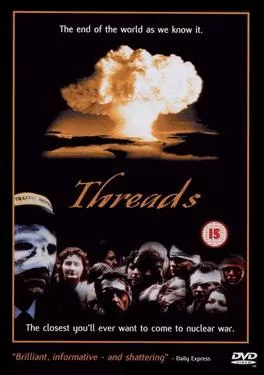
Threads, which tracks the aftermath of a nuclear attack on Sheffield, was first screened on the BBC on 23 September 1984 and fast became a cult classic.
Now filmmakers Craig Ian Mann and Rob Nevitt have spoken to more than 50 people involved in the making of the film for their documentary Survivors: The Spectre of Threads.
Mr Mann said: “[Threads] is a film that more than any I can think of everybody who worked on it it has impacted their lives in some way or another. Sometimes very positively and sometimes somewhat negatively.”
“There are people who have suffered the trauma of having been in and seen Threads,” he told BBC Radio Sheffield.
“There’s one participant in the documentary who has become a Doomsday prepper.
“He lives in America and has a bunker and canned food and weapons and he is prepared for the end of the world at any moment and that’s because he was in and saw Threads.”
Trump wants to stop nuclear proliferation. STRATCOM could play a major role.
Henry Sokolski, executive director of the Nonproliferation Policy Education Center, argues that the US needs to carry a new “big stick.”
By Henry Sokolski, Breaking Defense | August 29, 2025 breakingdefense.com

Last Monday, President Donald Trump pronounced, “We can’t let nuclear weapons proliferate.” Two days later, Secretary of State Rubio met with International Atomic Energy Agency (IAEA) Director General Rafael Mariano Grossi and recommitted the United States to preventing the proliferation of nuclear weapons.
After America’s bombing of Iran’s suspect nuclear sites, there’s cause to take these commitments seriously, but only if it’s more than a one off.
Emphasizing consistency is essential. Historically, America has backed nonproliferation in fits and starts. Under Presidents Gerald Ford and Jimmy Carter, the United States opposed the recycling of plutonium for commercial use because it was too close to bombmaking. It blocked reprocessing activities in South Korea, Taiwan, and Brazil.
Full Event Recording: Press Conference & Commemoration – Hiroshima Atomic Bombing 80th Anniversary Event (August 6, 2025)
DOE and LANL Silence Public and Tribal Community Member Voices While Pushing Radioactive Tritium Venting
For Immediate Release: August 22, 2025
Contact: Kalyn Mae Finnell, Coordinator, Communities for Clean Water
Los Alamos, NM — This week’s so-called “public meeting” regarding Los Alamos National Laboratory’s (LANL) proposal to vent radioactive tritium emphasized the persistence of the Department of Energy (DOE) National Nuclear Security Administration (NNSA) and LANL to disregard communities concerns while prioritizing nuclear weapons projects.
In-person attendees were allotted three minutes to make statements about their concerns. Over 100 online participants—including many Pueblo community members who could not attend the meeting in Los Alamos in-person due to health, distance, or work commitments—were surprised to find that they were not permitted to provide verbal comments and restricted to submitting only one emailed question. DOE/NNSA and LANL gave no prior notice of this change. “This is not meaningful participation. It is exclusion,” said Marissa Naranjo with Honor Our Pueblo Existence.
The stakes are at an all time high. Tritium — produced in the development of nuclear weapons as triated water — is a radioactive isotope of hydrogen that travels quickly through air, water, soil, and food. When exposed to the human body, it can cause cancer, genetic damage, cross the placental barrier, and cause health impacts across generations. DOE/NNSA insists venting is the sole safe option moving forward—however, their own “independent” technical review revealed significant issues with this assertion. The review acknowledged significant deficiencies: the absence of real-time monitoring, a lack of container-specific risk analysis, and insufficient examination of safer alternatives such as filtration or storage until decay occurs. Community members are also asking: How can a review be independent when DOE managed the process, designated the reviewer, and defined the scope? This does not represent independence—it signifies a conflict of interest.
“This is the same broken pattern we’ve seen for decades,” said Joni Arends with Concerned Citizens for Nuclear Safety. “LANL creates the danger, then tells us radioactive releases are our only option. They force the public and Pueblo communities into what NMED itself has called ‘untenable situations.'”
Local community leaders also noted that DOE has consistently overlooked reports by Tewa Women United, Communities for Clean Water, and scientific experts regarding the risks associated with tritium. These technical reports documented exposure pathways unique to Pueblo communities, including impacts on women, children, and traditional farming lifeways. By sidelining this research, DOE has once again dismissed Indigenous voices and lived experiences—further diminishing trust and perpetuating environmental racism.
“If our gathering here today is to mean anything, it must mean that in fidelity to all those whose lives were destroyed or savagely damaged on August 6, 80 years ago, we refuse to live in such a world of nuclear proliferation and risk-taking. We will resist, we will organize, we will pray, we will not cease, until the world’s nuclear arsenals have been destroyed.”
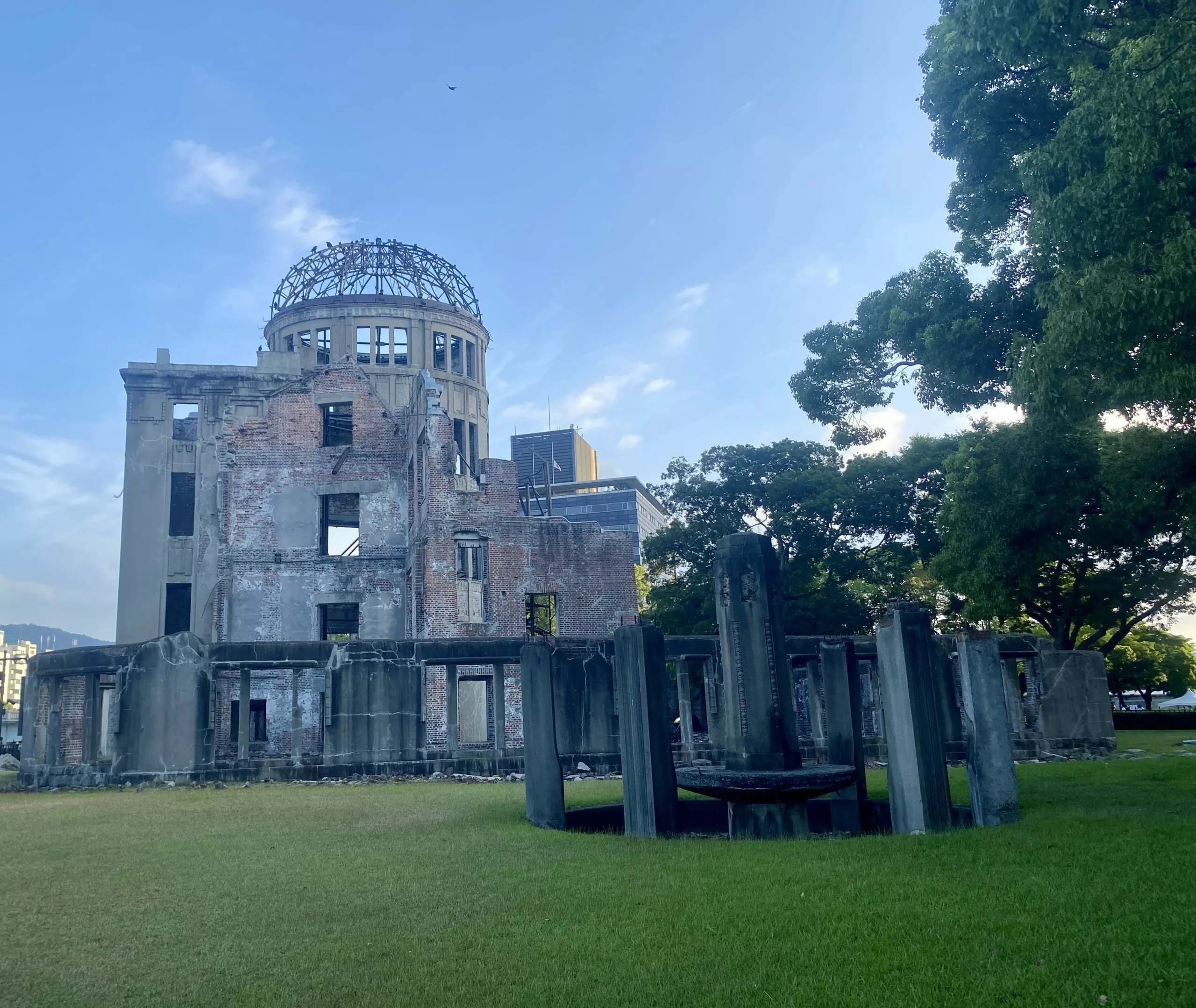 — Cardinal Bob McElroy of Washington, DC, August 5, 2025, at the World Peace Memorial Cathedral in Hiroshima, Japan.
— Cardinal Bob McElroy of Washington, DC, August 5, 2025, at the World Peace Memorial Cathedral in Hiroshima, Japan.
Nuclear Weapons Issues & The Accelerating Arms Race: August 2025
Nuclear Weapons Budget:
• NNSA’s detailed budget was finally released, the latest ever. $2.8 billion is for “plutonium modernization” (i.e., pit production) projects, of which $1.8 billion for LANL. The Lab’s nuclear weapons programs are having a full billion dollars added to them for FY 2026 (which begins this October 1) on top of the $4 billion they already have. The Lab’s $6 billion FY 2026 budget is now 84% nuclear weapons. Meanwhile cleanup and nonproliferation programs are being cut by 5% and renewable energy research completely eliminated.
• Over for the next four years the “reconciliation” bill adds another $750 million for plutonium modernization (mostly at SRS) and $1 billion “to accelerate the construction of National Nuclear Security Administration facilities.”Continue reading
August 6th U.S. Atomic Bombing of Hiroshima Commemoration in Santa Fe
Eighty Years Later, it is Beyond Time to Get Rid of Nuclear Weapons.
Last week on August 6, 2025, the 80th anniversary of the U.S. atomic bombing of Hiroshima, community members gathered at the Center for Progress and Justice on Cerrillos Road in Santa Fe to honor the solemn occasion and demand an end to the ongoing nuclear weapons harm and destruction that first began here in New Mexico.
The event was organized by Nuclear Watch New Mexico in collaboration with the Up in Arms campaign by Ben Cohen, co-founder of Ben & Jerry's, to reduce military and nuclear weapons spending, the International Campaign to Abolish Nuclear Weapons (winners of the 2017 Nobel Peace Prize), the Santa Fe Archdiocese, the Back from the Brink New Mexico Hub, and the Tularosa Basin Downwinders Consortium. It centered around a massive public art installation from Up in Arms of a towering cubic structure framed by messages on top of images of $100 bills. The structure is sized to literally hold $100 billion of those bills, respresenting what the U.S. spends every year on nuclear weapons (the total cost of nuclear weapons "modernization" is up to $2 trillion). Visible to thousands of drivers each day, the large installation pressures viewers to reckon with the scale of this cost and to imagine what else those resources could make possible. A prominent message on one of the four sides quotes the president in saying, "'We don't need to build brand new ones. We already have so many,' — Donald Trump" and below it, "His budget includes a down payment of $2 trillion of nuclear weapons." Another side reads, "The current U.S. nuclear arsenal is the equivalent of 50,00 Hiroshima explosions. One nuclear bomb killed over 100,000 people in Hiroshima."
The installation will remain on display for the foreseeable future, GO SEE IT NOW! 1420 Cerrillos Road, Santa Fe, NM 87505.
During the event, speakers Archbishop John C. Wester (by video from Japan), Tina Cordova of the Tularosa Basin Downwinders, Sophie Stroud from Nuclear Watch New Mexico, Anne Pierce-Jones from Back from the Brink, Ben Cohen representing Up in Arms, and Seth Shelden from ICAN all gave concrete steps and actions that concerned citizens can take to help promote a safer world. The speakers were presented by former Santa Fe County Commissioner Anna Hansen, who stated, “Disarmament is the only answer. I have spent my life working to end the nuclear cycle, as many have, and most of us in this room have never known a world without nuclear weapons.”
Speakers drew connections between the devastation in Hiroshima and the continued production of plutonium pits at LANL. At Los Alamos National Lab alone, five billion dollars will be poured into nuclear weapons programs in Fiscal Year 2026, starting this October. One billion dollars was added to last year’s budget, which includes a 42% increase for nuclear warheads. At the same time, nonproliferation programs are being cut, the science budget sliced in half, and funds for renewable energy zeroed out and gone completely. The push for "modernization" of the US’s nuclear arsenal is directly linked to plutonium pit production at Los Alamos, specifically expanding plutonium pit production. LANL will receive $1.7 billion in direct costs for pit production in 2026. Add in the indirect costs, and it’s roughly double that. All of this future pit production is exorbitantly expensive, yet the National Nuclear Security Administration still has no credible cost estimate for these plans.
WHAT YOU NEED TO KNOW: New plutonium pits are not needed to maintain the existing stockpile - it is all for future, new designs. And these new weapons cannot be tested because of the testing moratorium - or conversely could pressure the US to resume testing. In 2006, independent experts concluded that existing plutonium pits last at least a century. Their average age now is about 43 years. A new pit aging study is expected this year. Expansion plans should stop until then.
The U.S.’s $2 trillion “modernization” program is a plan to keep nuclear weapons forever. It is claimed to be essential for “deterrence.” But deterrence relies upon the flawed assumption that all actors will behave rationally, and that accidents or miscalculations will never occur. History says otherwise. Moreover, the U.S. and Russia have always rejected minimal deterrence in favor of nuclear warfighting capabilities that could end civilization overnight. That is why we have 1,000s of nuclear weapons and are funneling billions of dollars into mass death machines, even though everybody knows that a nuclear war must never be fought and can never be won.
See more on the myth of deterrance here:
Deterrence is the Threat: NukeWatch Presentation for Western New Mexico University – April 1, 2025
Media coverage of the event includes the Santa Fe New Mexican articles below:
New Mexico reckons with its role in Japan’s atomic devastation on 80th anniversary of Hiroshima
‘End the nuclear cycle’: Antinuclear New Mexicans speak out 80 years after Hiroshima bombing
View the full event recording - Click HERE or below:
Nobel Peace Conference: A Message to Humanity – Featuring a Video with Nuclear Watch New Mexico on Our Plutonium Pit Federal Lawsuit to Show What Citizen Action on the Legal Front Can Accomplish for Nuclear Disarmament
The video above shows the entire conference (but begins playing at our portion); to view our video alone on YouTube CLICK HERE or watch below!
Santa Fe New Mexican MY VIEW – 80 years on: The immorality of nuclear weapons
By John C. Wester, SANTA FE NEW MEXICAN | August 5, 2024 santafenewmexican.com
Greetings New Mexicans. The lord’s blessings upon you. I am writing to you from Hiroshima, Japan, on the 80th anniversary of its horrific atomic bombing. All wars are against Christ’s teachings. Two wrongs (including Japanese atrocities in World War II) never make a right.
I am here with Cardinal Blase Cupich of Chicago, Cardinal Robert McElroy of Washington, D.C., Archbishop Paul Etienne of Seattle and our brother Japanese bishops to commemorate the dead and to honor the living Hibakusha (the aging atomic survivors). We especially congratulate the Hibakusha organization, Nihon Hidankyo, for winning the 2024 Nobel Peace Prize.Continue reading
‘End the nuclear cycle’: Antinuclear New Mexicans speak out 80 years after Hiroshima bombing
Organized by Nuclear Watch New Mexico, the event featured speakers from the international campaign — which won the Nobel Peace Prize in 2017 — the Back from the Brink New Mexico Hub and the Tularosa Basin Downwinders Consortium, a group that advocates for “downwinders” in New Mexico who say they were sickened by fallout from the 1945 Trinity Test southeast of Socorro.
By Cormac Dodd cdodd@sfnewmexican.com, The Santa Fe New Mexican | August 6, 2025 santafenewmexican.com
The face of Archbishop John C. Wester played over the screen as the Catholic leader, on the same day surreal moments of horror unfolded during the bombing of Hiroshima 80 years ago, pleaded for nuclear disarmament.
“Do we pull back from the brink and choose life, or do we continue to play with fire, hoping our luck will hold out?” the leader of the Archdiocese of Santa Fe said in a video, recently recorded before he traveled to Japan with a delegation of U.S. bishops.
Wester has made antinuclear advocacy a central part of his tenure since he was appointed to the post in 2015. A group of about 50 people entered the Center for Progress and Justice on Cerrillos Road on Wednesday evening to commemorate the nuclear bombing of Hiroshima and Nagasaki toward the end of World War II.
New Mexico reckons with its role in Japan’s atomic devastation on 80th anniversary of Hiroshima
At a Wednesday evening event organized by Nuclear Watch New Mexico, Archbishop John C. Wester of the Archdiocese of Santa Fe, long an outspoken advocate of nuclear disarmament, is set to celebrate Mass in Japan for victims with some other U.S. Catholic bishops and will participate in commemoration services. The event will be played by video at an event in Santa Fe.
By Cormac Dodd cdodd@sfnewmexican.com, The Santa Fe New Mexican | August 5, 2025 santafenewmexican.com
Wesley Burris remembers waking to a morning of potent, white light and panic as the planet’s first atomic bomb went off in a test in the Jornada del Muerto desert near his family’s Southern New Mexico home in July 1945.
He does not recall, however, hearing the news from Hiroshima and Nagasaki in Japan over the radio just weeks later. In fact, because the U.S. government did not tell his family what it was they saw that July, it was years before Burris realized how the Trinity Test he witnessed as a child served as a prelude to the world-altering bombings of Japan on Aug. 6 and Aug. 9, 1945.
Eighty years ago, the U.S. dropped a nuclear bomb on Hiroshima near the end of World War II, unleashing immediate death on a sweeping scale and rendering vast corridors in the southwestern Japanese city charred and fragmented, with buildings reduced to rubble with harrowing speed.
Santa Fe Archbishop Wester on RECA, Nuclear Weapons
80 years after nuclear bomb tested in N.M., victims will get reparations
NBC News NOW, July 16, 2025, nbcnewsnow.com
Trinity “downwinders” of New Mexico exposed to the first ever nuclear explosion are receiving recognition and compensation 80 years after the bomb was tested. NBC News’ Aaron Gilchrest spoke with several people who shared their sacrifice and suffering over the years.
An appreciation of Bob Alvarez, a fearless advocate for those harmed by the US nuclear weapons complex
By Michael Slater – The Bulletin of Atomic Scientists| July 10, 2025, thebulletin.org
SEE ALSO: THIS WONDERFUL TRIBUTE TO BOB ALVAREZ FROM BEYOND NUCLEAR & OTHERS: https://beyondnuclear.org/bob-alvarez-presente/
And view the Alliance for Nuclear Accountability’s Lifetime Achievement Awared given to Bob in 2022: https://ananuclear.org/bob-alvarez/
Nuclear Weapons Issues & The Accelerating Arms Race: June/July 2025
Nuclear Weapons Budget:
• The just passed “reconciliation” bill and Trump’s proposed FY 2026 budget are reverse Robin Hood iniatives, robbing from the poor to give to the rich. While Medicaid is gutted, there are huge tax breaks for the ultra-wealthy and a big bump up for nuclear weapons.
• The following is from the DC-based Center for Arms Control and Non-Proliferation (https://armscontrolcenter.org/fiscal-year-2026-defense-budget-request-briefing-book/):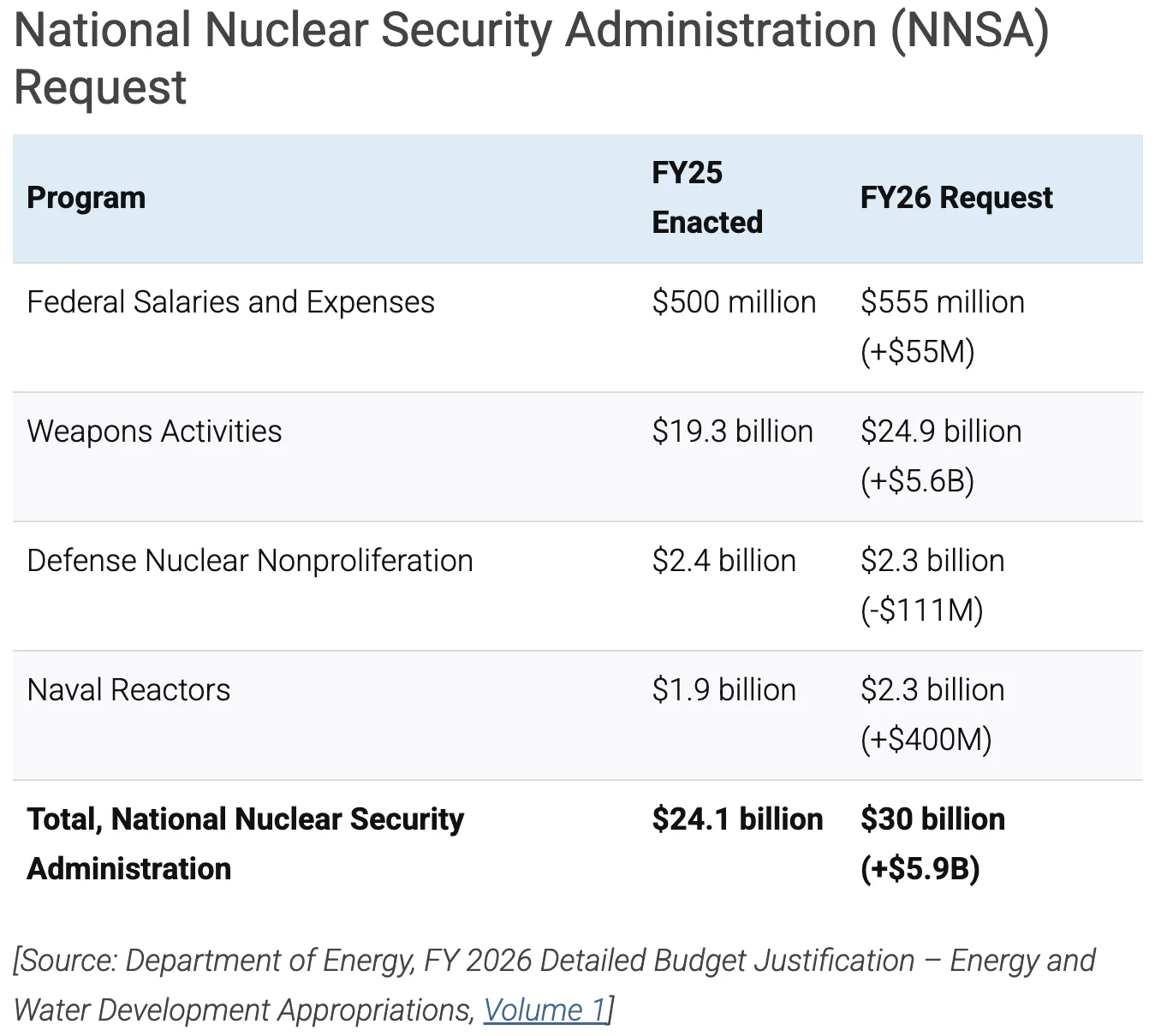
 Note: the + or – signs result from the “reconciliation” bill.
Note: the + or – signs result from the “reconciliation” bill.
• Radiation Exposure Compensation Act: Sen. Josh Hawley of MO got RECA extension and expansion attached to the bill, which is really something. Tina Cordova of the Tularosa Basin Downwinders Consortium has acknowledged that many deserving people have still been left out. See more: https://www.santafenewmexican.com/news/local_news/new-mexico-downwinders-celebrate-bittersweet-victory-in-trumps-big-beautiful-bill/article_9dc4ae5e-d4d0-4689-a255-a83576076963.html Finally, it is good for only two years because it was part of budget “reconciliation” that is supposed to deal only with funding matters (hence is limited to this 2-year term of Congress). We will continue to fight to get RECA permanently extended and expanded.
Nuclear Weapons Update:
The manufacture of new pits has more to do, as per the last Nuclear Posture Review (NPR), with preserving and “modernizing” the infrastructure than it does with the warheads themselves. This is in essence a huge continuing program of institutional preservation that guarantees large inflows of taxpayer dollars and corporate profits.
Further, we are talking about W87-1 pits for the new Sentinel intercontinental ballistic missile, which is already 80% over budget before the Air Force admitted it had to build new silos. Moreover, the reported production of ~800 plutonium pits when there are only to be 400 fielded Sentinels may lead to the uploading of multiple warheads per missile (AKA MIRVing for Multiple Independently-targeted Reentry Vehicles). This is regarded as deeply destabilizing since land-based ICBMs are known fixed targets which encourage pre-emptive strikes and/or use them or lose them scenarios.
Accelerating Arms Race
• The U.S. bombed Iranian hardened, deeply buried uranium enrichment sites with B2s carrying 30,000 lb. conventional bunker busters (32 hours roundtrip from Whiteman AFB in Missouri). The U.S. has rushed produced nuclear B61-13s for this kind of job.
Planned Nuclear Weapons Activities Increase to 84% of Lab’s Budget; All Other Programs Cut

The Department of Energy and Los Alamos National Laboratory have released the LANL congressional budget request for the upcoming fiscal year, 2026, which begins on October 1, 2025. The request shows a continued major increase and expansion of the plutonium pit production program (plutonium pits are the triggers of nuclear weapons). LANL is frantically trying to increase its capabilities to begin making 30 pits per year by 2028.
NukeWatch created the attached chart to give a visual of how taxpayer dollars are annually spent at the Lab. LANL’s FY 2026 total budget request is $6 billion, which is a 17% increase over the FY 2025 $5.2 billion total budget. This includes a 24% increase in the nuclear weapons budget over FY 2025.
Nuclear Weapons Activities represent 84% of LANL’s total budget.
Under the headline of “Unleashing a Golden Era of Energy Dominance and Energy Innovation and Protecting the Nation,” the nuclear weapons budget is increasing dramatically. As a baseline, 65% of the Department’s proposed $46 billion budget is earmarked for its semi-autonomous nuclear weapons agency, the National Nuclear Security Administration (NNSA). In turn, more than 80% of NNSA’s proposed FY 2026 funding is for its nuclear weapons research and production programs, with a 25% funding increase over FY 2025.
Due to so-called “reconciliation” funding, “Total Weapons Activities” increase to just under $30 billion. This adds up to a 53% increase above FY 2025 for the nuclear weapons research and production programs across the country. To help pay for this, national nonproliferation and cleanup programs are being cut by 5%, science by 14%, cybersecurity and emergency response by 25%, and energy efficiency and renewable energy programs by 74%.
NukeWatch in DC Lobbying for Nuclear Disarmament and Non-Proliferation
Your Nuclear Watch New Mexico team has just returned from a weeklong trip to Washington D.C. (we went so you don’t have to!). The Alliance for Nuclear Accountability (ANA) hosts an annual “DC Days” conference and following Spring Meeting, and we proudly joined as part of a record number of groups this year. Over 60 individuals from 30+ organizations journeyed to DC to lobby congress on nuclear weapons, energy, and waste policy on behalf of the frontline nuclear communities we represent. Members were present from groups representing the entire U.S. nuclear complex, including sites in Georgia, New Mexico, Tennessee, California, Missouri, Colorado, Idaho, Nevada and beyond. NukeWatch NM brought all three staff members—Jay Coghlan, Scott Kovac, and Sophia Stroud (whose participation was made possible by a youth scholarship from ANA)—to participate in DC Days and the subsequent two-day spring meeting. The ANA DC Days schedule included over 70 meetings with senators, representatives, and other relevant agencies, such as the Department of Energy, the Government Accountability Office, and the Defense Nuclear Facilities Safety Board. Our NukeWatch team attended nearly 30 of these meetings. The Alliance for Nuclear Accountability put together a new report to present our “asks” to congress as a coalition, including analysis and recommendations for nuclear weapons, nuclear waste, and nuclear energy policy and funding. Please click HERE for the full report, and HERE for a short summary.
I was glad to see increased representation from Nevada this year, and especially Indigenous representation. In light of the current administration’s attacks on Environmental Justice, it is more important than ever that ANA as a whole, as well as individual member groups, continue to prioritize uplifting Native American voices, not only because of their deep cultural, spiritual, and social connections to the land, including sacred sites and traditional knowledge essential to religious freedom and access, but also because of the violent legacy and ongoing reality of nuclear colonialism, in which Indigenous lands and peoples have been deliberately and disproportionately targeted in the nuclear industry with uranium mining, nuclear weapons testing and production, and the disposal of radioactive waste. To learn more about Nuclear Colonialism, see: www.networkadvocates.org/downwinders and read Nuclear Nuevo México: Colonialism and the Effects of the Nuclear Industrial Complex on Nuevomexicanos by Myrriah Gómez.
THE ATOMIC BOWL: Football at Ground Zero —and Nuclear Peril Today
First prize, Best Documentary Feature, International Uranium Film Festival, Rio de Janiero
Coming to PBS in July 2025. (53-minute and 27-minute versions).
There have been numerous films on The Bomb, even one or two about Nagasaki, but “The Atomic Bowl: Football at Ground Zero — and Nuclear Peril Today” is unique, and with many lessons and warnings for today–as nuclear dangers proliferate and civilian casualties in wars climb even higher.
This football showdown featured college and pro stars, on January 1, 1946, and in (of all places) Nagasaki, near ground zero for the second atomic bomb, which killed over 80,000 just a few weeks earlier. The film, narrated by Peter Coyote, is not only the first full first-hand account of the game, but a provocative and disturbing story of the decision to drop a second atomic bomb just three days after Hiroshima–and the dangerous message to today’s leaders. Nearly all of the victims of the “forgotten bomb” were women and children and other civilians.
This important film, which includes rare footage and dozens of never published photographs, then offers a convincing argument about the relevance of Nagasaki today as mass civilian casualties in wars surge and nuclear dangers by all estimates grow every year.
Its writer and director Greg Mitchell has been one of the world’s leading authorities on the atomic bombings for several decades, and his recent film, “Atomic Cover-up,” won several awards, including the top prize from the Organization of American Historians and was aired via PBS. His two other recent films, “The First Attack Ads” and the award-winning “Memorial Day Massacre,” also earned PBS distribution (as well as Emmy nods), and like “The Atomic Bowl” were produced by Academy Award nominee Lyn Goldfarb.
Nuclear News Archive – 2022
Biden administration reveals number of nuclear weapons in US stockpile
“The Biden administration’s decision to declassify updated information on the number of nuclear warheads in the U.S. nuclear weapons arsenal is a welcome step that reverses an unwise decision by the Trump administration to classify this information,” the Arms Control Association said in a statement Wednesday.
“It also puts pressure on other nuclear armed states that maintain excessive secrecy about their arsenals.”
By Chandelis Duster and Nicole Gaouette, CNN, benningtonbanner.com October 7, 2021
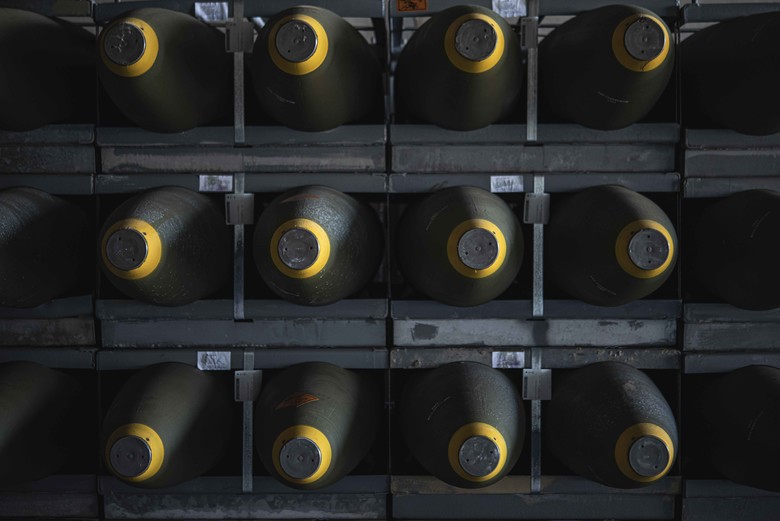
(CNN) In a reversal from the Trump administration, the State Department revealed the number of nuclear weapons in the US stockpile for the first time in four years on Tuesday.
“Increasing the transparency of states’ nuclear stockpiles is important to nonproliferation and disarmament efforts, including commitments under the Nuclear Non-Proliferation Treaty, and efforts to address all types of nuclear weapons, including deployed and non-deployed, and strategic and non-strategic,” the State Department said.
Nuclear submarines will not deter China from conflict with Taiwan, but Australia has an alternative arsenal
As a committed supporter of international institutions and the world’s 13th largest economy, Australia has real clout
“As the gap between China’s military and Australia’s widens, it is unlikely that Australia’s capability – even with a fleet of nuclear submarines, supplied by its Aukus partners – will determine the balance of military power in the Indo-Pacific.”
By Jonathan Pearlman October 6, 2021 The Guardian theguardian.com
For an emerging superpower prone to petulant outbursts and coercive retaliation, China’s initial response to the recent announcement of the new three-way security pact between Australia, the United States and Britain seemed surprisingly tepid.
Hours after the trio unveiled their “forever partnership”, known as Aukus, China formally requested that it be allowed to join an 11-member Asia-Pacific trade grouping, the Comprehensive and Progressive Agreement for Trans-Pacific Partnership (CPTPP).
This was an odd move by China, whose application requires the consent of the grouping’s members, which include Australia. In recent years, China has responded to previous perceived slights from Canberra by imposing economic sanctions worth $20bn and freezing ministerial contacts.
Nuclear-Weapon-Free States Demand Immediate End to Deterrence Policies, Start of Dismantling Atomic Arsenals, as First Committee Continues General Debate
Calling for swift remedies to mend a fractured non-proliferation landscape, nuclear-weapon-free States demanded an immediate end to deterrence policies and the start of dismantling atomic arsenals, as the First Committee (Disarmament and International Security) moved into the third day of its general debate.
UNITED NATIONS MEETINGS COVERAGE GENERAL ASSEMBLY FIRST COMMITTEE SEVENTY-SIXTH SESSION, 4TH MEETING (PM)
As thousands of atomic bombs located around the world pose grave risks to humanity, delegates implored nuclear-weapon States to steer the planet onto a path of peace. Some suggested such ways to do so, with delegates agreeing that dismantling nuclear arsenals must start now, in line with the Treaty on the Non-Proliferation of Nuclear Weapons and under safeguards established by the International Atomic Energy Agency (IAEA). Many urged all nations with atomic arsenals to sign, ratify and fully implement existing conventions, including the Treaty on the Prohibition of Nuclear Weapons, which entered into force in January, and some decried the quarter of a century delay in entering into force the Comprehensive Nuclear-Test-Ban Treaty. To rectify this, many called for nuclear-weapon States to sign and ratify it so that atomic bomb testing can become part of the past.
One Man Shouldn’t Control the Nuclear Button
Congress should require consultation, so generals wouldn’t have to break the rules to save the world.
The critics are missing the point. The overriding issue is not whether Gen. Milley was correct in his assessment, or whether he was authorized to take the reported actions, but what the consequences could have been if his concern had been warranted. It is not hyperbole to say that the consequences could have been a profound tragedy and, in the worst case, the end of civilization.
The Stealthy F-35 Fighter Jet Is One Step Closer to Carrying Nuclear Weapons
“A pair of F-35s from Nellis Air Force Base in Nevada released dummy nuclear bombs at a nearby test range this month, moving the advanced stealth fighter closer to carrying the world’s most powerful weapons into combat, the Air Force said.”
By Stephen Losey • military.com
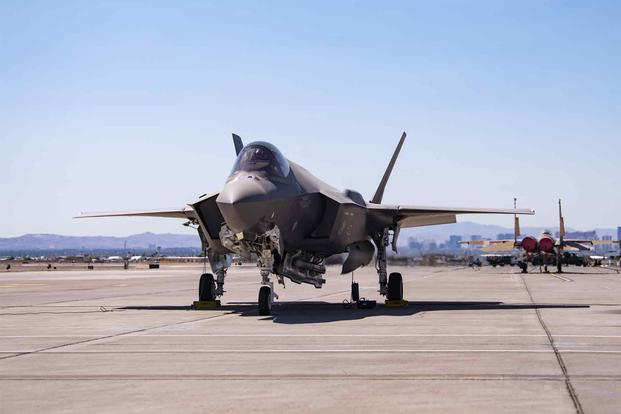
The flights on Sept. 21 marked the “graduation” test exercise necessary for the Air Force variant of the F-35 to move ahead with what’s called the nuclear design certification process, according to the service’s press release.
It’s still not clear when the F-35A will receive its full nuclear certification allowing it to move from training ranges and dummy bombs to real-world battlefields. But when that happens, the Air Force will have a second stealth aircraft in its fleet that can carry nukes.
“The B-2 [Spirit] bomber was the prominent nuclear-capable stealth aircraft,” Lt. Col. Daniel Jackson, division chief for strategic deterrence and nuclear integration at Air Combat Command, said in the press release.
F-15E Strike Eagle and F-16C and D Fighting Falcon fighters do not have stealth capability but can carry nuclear weapons. The B-21 Raider heavy bomber will also have the capability and is expected to join the Air Force’s fleet in the mid-2020s, according to the latest estimates.
Opinion: Too many ‘downwinders’ are still suffering
“We are sponsoring a bill that would make sure the government’s responsibility to those who were harmed by nuclear testing does not get swept under the rug.”
By Burgess Owens and Chris Stewart deseret.com

Any objective study of American history brings us to the realization that there are many Americans who quietly made, and continue to make, great sacrifices for our national security. Many of these women and men willingly give of themselves to ensure that our country remains free.
Tragically, under the banner of national security the United States government exposed Americans to radioactive uranium ore and radioactive dust — subjecting them to lung cancer and other respiratory illnesses.
On July 16, we marked the 76th anniversary of the detonation of the first nuclear weapon — code-named Trinity — in the desert of New Mexico’s Tularosa Basin. Three weeks after the Trinity detonation, the United States exploded the Little Boy bomb over Hiroshima and, three days later, the Fat Man bomb over Nagasaki. Six days later, Japan surrendered. In the aftermath of World War II, a nuclear arms race began that reached its zenith with over 60,000 nuclear weapons worldwide in 1986.
Many lives were lost or severely altered by the nuclear weapons program. Thankfully, the world stockpile of nuclear weapons has steadily declined since 1986 and will, hopefully, continue to do so in the future. Yet, the effects of detonating over 1,100 nuclear weapons since the Trinity test in 1945 continue to mar the lives of Americans to this day.
Through atmospheric weapons tests, as well as mining, transporting and milling of uranium ore, many Americans have been slowly killed by radiation exposure. Thousands of Utahns were infected by radiation exposure simply by living “downwind” of the federal government’s nuclear weapons testing sites. Additional Utahn miners were affected as they worked the uranium necessary for these weapons. These “downwinders” and miners and their families friends, and communities often suffered excruciating illness, loss and devastation.
In response to this malfeasance, Congress rightly enacted (and later amended in 2000) the Radiation Exposure Compensation Act (RECA) in 1990. This legislation was a good first step in making recompense to those who mined and hauled uranium ore and those who processed the ore at a mill. The RECA legislation also addresses those exposed to radiation downwind from nuclear test sites.
It has been more than 20 years since any meaningful reform to RECA has been made for those whose lives have been taken or irreversibly altered by our foray into the arms race. Several classifications of workers such as core drillers and ground workers have been denied justice by being excluded completely from the process.
Some diseases that should have been compensable have been excluded. Numerous geographical locations exposed to downwind radiation have been left out. Uranium miners continued to mine after the United States stopped buying uranium for its nuclear weapons programs in 1971. These so-called post-1971 workers were excluded from accessing benefits since the original RECA legislation had an arbitrary cutoff date of Dec. 31, 1971 — even though the federal government continued to regulate uranium mines long after 1971. To make matters worse, RECA is scheduled to sunset in July 2022 — potentially leaving all classifications of exposure victims without redress.
We are honored to represent some of these “downwinders” and their family members and want them to know their suffering — and the sacrifices they made for our nation — are not forgotten.
That is why we are pleased to be the lead Republican members of the House of Representatives on the “RECA Amendments Act of 2021,” legislation that will reauthorize RECA for those still suffering the consequences of nuclear testing.
The tragic consequences of the nuclear arms race cannot be swept under the rug of history. We urge our colleagues in Congress to support the “RECA Amendments Act of 2021.” Our country must act now to address the injustices of those who have been forgotten by their own government.
Rep. Burgess Owens represents Utah’s 4th Congressional District. Rep. Chris Stewart represents Utah’s 2nd Congressional District.
Four Takeaways from the 2021 World Nuclear Industry Status Report
“Although net nuclear capacity rose last year, the 0.4-gigawatt increase was minuscule in comparison with the gains made by renewable energy. ‘Nuclear is irrelevant in today’s electricity capacity newbuild market,’ the industry report concludes.”
By Dawn Stover | October 1, 2021 The Bulletin thebulletin.org
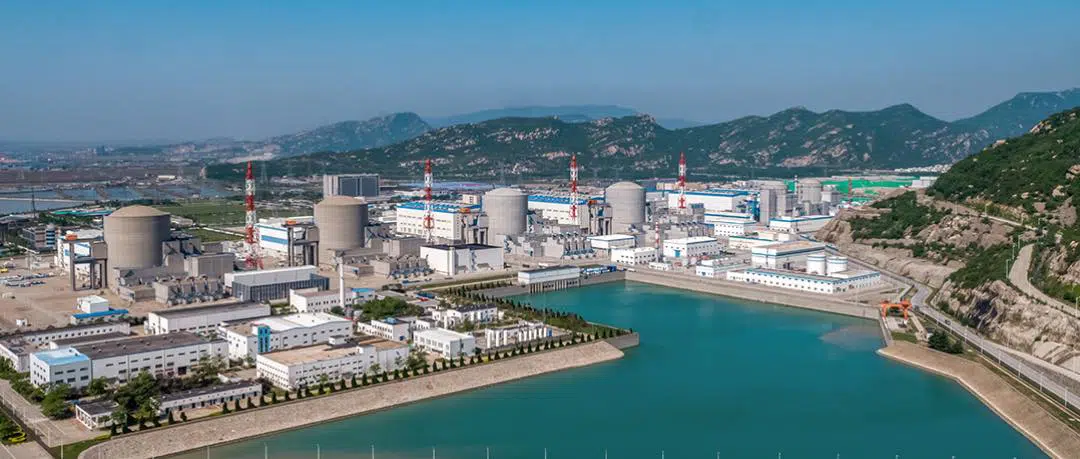
Although there are 23 fewer nuclear reactors in the world today than at the 2002 peak of 438, the past year saw a small uptick in the number of reactors operating worldwide and a corresponding increase in the global fleet’s net operating capacity.
That’s one data point in the World Nuclear Industry Status Report 2021, the latest in a series of annual industry reports compiled by an international team of independent experts led by Mycle Schneider, a consultant based in Paris. The 409-page report, released this week, is packed with information about global and country-specific trends, but several findings stand out, and they don’t bode well for the nuclear energy industry.
First, although nuclear capacity is up, nuclear electricity production is down.
As of mid-2021, there were 415 nuclear reactors operating in 33 countries, seven reactors more than a year earlier. Their total capacity was 1.9 percent higher than a year earlier. But in 2020, the worldwide nuclear fleet generated 3.9 percent less electricity than in the previous year. That was the first decrease in output since 2012, when many reactors remained shut down in the wake of the Fukushima nuclear disaster.
Without China, where most of the new construction is happening, the decrease in production would look even bigger. In 2020, China for the first time produced more nuclear electricity than France, which relies heavily on nuclear energy. Only the United States produced more.
NRDC: Legislation Offers Path Forward on Nuclear Waste
“This legislation could end years of debate and acrimony and help determine a path forward for disposing of nuclear waste. Placing nuclear waste under bedrock environmental laws could ensure strong repository standards, while giving states the power to approve what is sequestered within their borders.”
– Kit Kennedy, managing director for the Climate and Clean Energy program at NRDC (Natural Resources Defense Council)
WASHINGTON – Sen. Ed Markey (D-Mass.) and Rep. Mike Levin (D-Calif.) introduced legislation today that could end a 60-year impasse over our nation’s nuclear waste.
The bill would establish a task force to consider removing exemptions for radioactive waste and spent nuclear fuel from our bedrock environmental laws. Doing so would allow for geologic repositories for nuclear waste that have strong environmental protections and the consent of state leaders and local residents.
Senator Markey and Rep Levin Introduce Legislation to Determine a Viable Consent Based Path Forward for Nuclear Waste
Currently, the United States has no permanent geologic repository for disposal of high-level nuclear waste
“The current system of spent nuclear fuel storage is not sustainable, particularly for sites that no longer have operating reactors and could be redeveloped for other beneficial uses, such as the San Onofre Nuclear Generating Station,” said Representative Levin.
PRESS RELEASE September 28, 2021 markey.senate.gov
Washington (September 28, 2021) – Senator Edward J. Markey (D-Mass.), Chair of the Clean Air, Climate, and Nuclear Safety Subcommittee of the Senate Environment and Public Works Committee, and Congressman Mike Levin (CA-49) today introduced the Nuclear Waste Task Force Act, legislation to establish a new task force to consider the implications of amending the Atomic Energy Act of 1954 to remove exemptions from environmental laws for nuclear waste. Eliminating this loophole could help enable consent-based siting of long-term storage solutions for nuclear waste. The task force would also be responsible for providing a clear explanation of what constitutes “consent-based siting.”
“Enabling consent-based storage is the key to developing real, practical solutions for the long-term storage of nuclear waste. This nuclear waste task force will play a critical role in determining how to make that happen.”
Survivors Of The Trinity Nuclear Test Weren’t Warned — Then Were Lied To After
NPR’s Leila Fadel talks with Lesley Blume about the struggle of the survivors of the Trinity nuclear test in 1945 — one locals didn’t know was coming and caused serious health issues.
“The compensation act – RECA as it’s called – is about to expire next July…What’s happening right now is that several members of Congress from New Mexico and from other Western states are trying to extend RECA, and they’re making a bid to have the Trinity downwinders included under this legislation at last, among other exposed communities.”
NPR News Heard on All Things Considered
An aerial view of the aftermath of the first atomic explosion at the Trinity test site in New Mexico in 1945. The device exploded with a power equivalent to 21,000 tons of TNT. Credit Associated PressLEILA FADEL, HOST:
This was most of America’s introduction to nuclear power.
(SOUNDBITE OF ARCHIVED RECORDING)
HARRY TRUMAN: A short time ago, an American airplane dropped one bomb on Hiroshima and destroyed its usefulness to the enemy.
FADEL: President Harry Truman’s announcement in August of 1945 heralded a terrifying new weapon.
(SOUNDBITE OF ARCHIVED RECORDING)
TRUMAN: It is an atomic bomb. It is a harnessing of the basic power of the universe. The force from which the sun draws its power has been loosed against those who brought war to the Far East.
FADEL: But the Atomic Age actually began the month before At the Alamogordo Bombing and Gunnery Range in New Mexico. The first nuclear test, codenamed Trinity, was a closely guarded secret. Locals, some as close as 12 miles away, had no idea it was coming. Lesley Blume wrote about them for National Geographic.
Welcome back.
LESLEY BLUME: Thank you so much.
FADEL: So, first, tell us what happened during that first test, codenamed Trinity.
BLUME: It was a huge success, but it also – the bomb was a lot more powerful than they had expected, three to five times as powerful. And, you know, initially they thought that the cloud was only going to go up about 12,000 or 13,000 feet. Well, guess what. It went up between 50,000 and 70,000 feet. It created sort of an estimated fallout zone about 100 miles long and 30 miles wide…
“Now is the time to eliminate nuclear weapons from our world, and usher in a new era of dialogue, trust and peace”, declared UN Secretary-General António Guterres on Sunday, marking the International Day for the Total Elimination of Nuclear Weapons.
Addressing the threat of nuclear weapons, said Mr, Guterres, has been central to the work of the United Nations since its inception; the first General Assembly resolution in 1946 sought “the elimination from national armaments of atomic weapons and of all other major weapons adaptable to mass destruction.”
The UN chief pointed out that, although the total number of nuclear weapons has been decreasing for decades, some 14,000 are stockpiled around the world, which is facing the highest level of nuclear risk in almost four decades: “States are qualitatively improving their arsenals, and we are seeing worrying signs of a new arms race.” Humanity, continued the UN chief, remains unacceptably close to nuclear annihilation.
Veterans Group Urges President Biden to Adopt No First Use Policy
To mark the International Day for the Total Elimination of Nuclear Weapons, September 26, Veterans For Peace is publishing an Open Letter to President Biden: Just Say NO to Nuclear War!
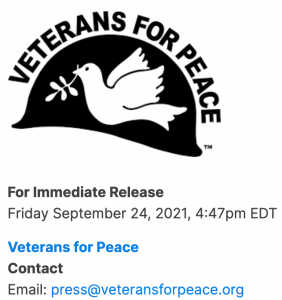
ST. LOUIS, MO –
Veterans For Peace, with over 140 chapters in the United States and affiliates abroad, is calling on President Biden to step back from the brink of nuclear war by declaring and implementing a policy of No First Use and by taking nuclear weapons off hair-trigger alert. The full letter will be published on the VFP website and offered to mainstream newspapers and alternative news sites: Click here to view.
While timed to coincide with the UN-declared International Day for the Total Elimination of Nuclear Weapons, a major motivation for the letter is the Nuclear Posture Review, currently underway.
The letter therefore states, “As veterans who have fought in multiple U.S. wars, we are concerned about the very real danger of a nuclear war that would kill millions of people and could possibly even destroy human civilization. Therefore we are asking to have input into the Nuclear Posture Review that your administration has recently initiated.”
A Little Radiation Is Not Good For You
“…between 1977 and 1990, scientists tripled their estimate of the damage inflicted by a given dose of radiation. A 1992 study published in the American Journal of Industrial Medicine found that nuclear weapons production workers exposed to small doses were four to eight times more likely to contract cancer than previously estimated…even the very lowest background levels of radiation exposure are harmful to health and have statistically significant negative effects on DNA.”
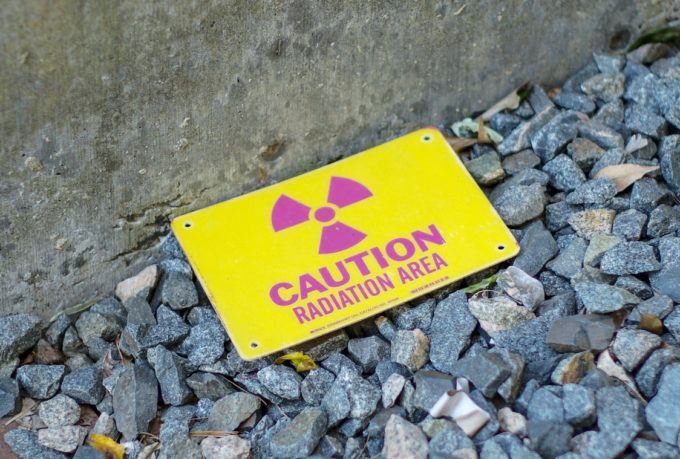
In a rare pushback against the radioactive pollution industry, the Nuclear Regulatory Commission — well known as a rubber stamp for the nuclear lobby — has flatly rejected an attempt to further weaken the agency’s radiation exposure regulations.
After six years of deliberation, the NRC’s three commissioners, two Democrats and one Republican, voted unanimously to reject formal petitions submitted in February 2015 urging the agency to adopt a cost-cutting scheme known as “hormesis” which claims that “a little radiation is good for you.” The September 16 decision by the NRC says this “threshold theory posits that “there is some threshold dose below which there is either no radiation-related health detriment or a radiation-related health benefit that outweighs any detriment.”
The order then rebukes this concept, finding the petitioners “fail to present an adequate basis supporting the request,” and “Convincing evidence has not yet demonstrated the existence of a threshold below which there would be no … effects from exposure to low radiation doses.”
The basis for hormesis had been explicitly rejected ten years earlier, the NRC pointed out, by the National Academy of Sciences in its 2005 report “Biologic Effects of Ionizing Radiation, 7th Ed” or BEIR-VII. The National Research Council summed up its book-length BEIR-7 report saying, “the smallest dose has the potential to cause a small increase in risk to humans.”
Biden’s nuclear agenda in trouble as Pentagon hawks attack
“The decision to fire Leonor suggests to me that the first draft of NPR is going to be a continuation of the line of thinking we saw in the Trump administration’s NPR…They have put themselves on the course that is a first draft that is 180 degrees to what Biden said on the campaign trail.” – Jeffrey Lewis, a professor and nuclear weapons expert at the Middlebury Institute for International Studies and host of the podcast Arms Control Wonk.
By BRYAN BENDER and LARA SELIGMAN | September 23, 2021 politico.com
One of President Joe Biden’s leading allies in his decadeslong attempt to reduce nuclear weapons has lost a battle with the Pentagon’s hawks.
The ouster of Leonor Tomero, who questioned the status quo on nuclear weapons, signals the Biden administration’s ambitious agenda to overhaul America’s nuclear policy might be in trouble.
Early in his administration, Biden installed national security officials intent on negotiating new arms control treaties and curtailing nuclear weapons spending. One of them was Tomero, a leading voice for nuclear restraint on Capitol Hill and in the think tank community, who was appointed to oversee the Nuclear Posture Review that will set the administration’s atomic weapons policy and strategy.
But officials with more traditional views on nuclear weapons, who promote a status quo agenda to include modernizing the land, sea and airborne legs of America’s nuclear arsenal, did not take kindly to Tomero’s progressive ideology, according to 11 current and former defense officials, as well as others with insight into the debate.
New push on to expand nuclear radiation compensation in US
“There is always money when there’s political will. This is a social, environmental and restorative justice issue that we, as a nation, can no longer look away from.” — Tina Cordova, a cancer survivor and co-founder of the Tularosa Basin Downwinders Consortium
By SUSAN MONTOYA BRYAN | AP apnews.com September 22, 2021
Corbin Harney, an elder with the Western Shoshone Tribe, beats a drum during a May 2002 tribal protest near the planned Yucca Mountain national nuclear waste dump.ALBUQUERQUE, N.M. (AP) — A bipartisan group of lawmakers is renewing a push to expand a U.S. compensation program for people who were exposed to radiation following uranium mining and nuclear testing carried out during the Cold War.
Advocates have been trying for years to bring awareness to the lingering effects of nuclear fallout surrounding the Trinity Site in southern New Mexico, where the U.S. military detonated the first atomic bomb, and on the Navajo Nation, where more than 30 million tons of uranium ore were extracted over decades to support U.S. nuclear activities.
Under legislation introduced Wednesday by U.S. Sens. Ben Ray Luján, a Democrat from New Mexico, and Mike Crapo, a Republican from Idaho, other sites across the American West would be added to the list of places affected by fallout and radiation exposure. Eligibility also would be expanded to include certain workers in the industry after 1971, such as miners.
The legislation also would increase the amount of compensation someone can receive to $150,000 and provide coverage for additional forms of cancer.
Op-Ed: Gen. Milley did the wrong thing for honorable reasons. We need new rules for starting nuclear war
“But let’s be clear about where the problem lies: It’s with the existing U.S. system for controlling the use of nuclear weapons… If the United States is intent on maintaining at the ready a large nuclear strike force, as is apparently the case, the nation needs comprehensive safeguards to prevent reckless and ill-considered decisions regarding their use.”
By Andrew Bacevich | LA Times latimes.com September 16, 2021
A new book by journalists Bob Woodward and Robert Costa contains a singularly startling allegation. In the waning weeks of the Trump administration, Gen. Mark Milley, chairman of the Joint Chiefs of Staff, twice called his counterpart, Gen. Li Zuocheng, of the People’s Liberation Army, offering assurances that the United States was not about to launch an attack against China.
“If we’re going to attack,” Milley told Li, according to Woodward and Costa, “I’m going to call you ahead of time. It’s not going to be a surprise.”
The surprise turns out to be the revelation of Milley’s actions. Some in the Defense Department may have known about the calls, but one thing seems clear: President Trump, the U.S. commander in chief, did not. Milley acted of his own volition, without prior presidential approval. On that point, Christopher Miller, then serving as acting Defense secretary, is emphatic, describing Milley’s actions to Fox News as a “disgraceful and unprecedented act of insubordination.”
Providing adversaries with advance notice of U.S. military actions does not number among the prescribed duties of the chairman of the joint chiefs. Arguably, the Woodward-Costa allegations, if accurately reported, qualify as treasonous. At the very least, they raise serious doubts about Milley’s respect for the bedrock principle of civilian control of the military. To state the matter bluntly, when adherence to that principle raised the possibility of an outcome not to Milley’s liking, he seemingly granted himself an exemption.
Of course, all of this happened in a specific context: Woodward and Costa’s chilling account is only the latest to depict the unraveling Trump presidency following the November election. Unwilling to accept defeat, the incumbent all but ceased to govern and instead devoted himself to overturning the election’s results by any means necessary, violating the rule of law and waiving the Constitution.
Kildee Introduces Bipartisan Resolution Opposing Proposed Canadian Permanent Nuclear Storage Site Near Great Lakes
By Devlin Barrett and Martin Weil | September 16, 2021 Press Release dankildee.house.gov
Woodward/Costa book: Worried Trump could ‘go rogue,’ Milley took secret action to protect nuclear weapons
“Woodward and Costa write that after January 6, Milley ‘felt no absolute certainty that the military could control or trust Trump and believed it was his job as the senior military officer to think the unthinkable and take any and all necessary precautions.’
Milley called it the ‘absolute darkest moment of theoretical possibility,‘ the authors write.”
By Jamie Gangel, Jeremy Herb and Elizabeth Stuart, CNN September 14, 2021
Washington (CNN) Two days after the January 6 attack on the US Capitol, President Donald Trump’s top military adviser, Joint Chiefs Chairman Gen. Mark Milley, single-handedly took secret action to limit Trump from potentially ordering a dangerous military strike or launching nuclear weapons, according to “Peril,” a new book by legendary journalist Bob Woodward and veteran Washington Post reporter Robert Costa.
Woodward and Costa write that Milley, deeply shaken by the assault, ‘was certain that Trump had gone into a serious mental decline in the aftermath of the election, with Trump now all but manic, screaming at officials and constructing his own alternate reality about endless election conspiracies.’
“You never know what a president’s trigger point is,” Milley told his senior staff, according to the book.

A private company got federal approval to store nuclear waste in Texas. The state is fighting back.
“The Nuclear Regulatory Commission’s approval of the planned facility opens a new front in a decades-long battle to find a home for the country’s nuclear waste.”
By: Douglas MacMillan and Aaron Gregg | THE WASHINGTON POST September 12, 2021 washingtonpost.com
A private company has won federal approval to build an expansive nuclear waste site in Texas, even as residents, state lawmakers, environmentalists and Texas Gov. Greg Abbott (R) rail against it.
The Nuclear Regulatory Commission (NRC) on Monday issued a license for Andrews, Tex.-based Interim Storage Partners to store as much as 5,000 metric tons of radioactive waste. It’s one of two proposed storage sites — the other is in southeastern New Mexico — that has been under agency review for several years.
Nuclear waste facility near Carlsbad sees COVID-19 surge as infections rise in New Mexico
COVID-19 infections resurged at the Waste Isolation Pilot Plant in recent weeks as cases of the virus climbed in the communities surrounding the nuclear waste repository in southeast New Mexico.
There were 14 positive cases among workers at the site or associated with the facility reported between Aug. 17 and 31, per the latest report from Nuclear Waste Partnership (NWP) – WIPP’s primary operations contractor.
In total, WIPP reported as of Aug. 31, there were 25 active cases.
WIPP officials did not report the identities of patients or companies where the infected workers were employed.
All employees at WIPP were encouraged to receive a COVID-19 vaccination, per an NWP news release, and required to wear protective face masks when indoors, vaccinated or not, and social distance when possible.
U.S. still prepared to engage with North Korea after missile test
“North Korea’s cruise missiles usually generate less interest than ballistic missiles because they are not explicitly banned under United Nations Security Council resolutions. However, analysts said calling it “strategic” could mean it was a nuclear-capable system.”
Reuters reuters.com September 13, 2021
ABOARD AIR FORCE ONE, Sept 13 (Reuters) – The United States remains prepared to engage with North Korea, a White House spokeswoman said on Monday, despite Pyongyang’s announcement that it had tested a new long-range cruise missile over the weekend.
“Our position has not changed when it comes to North Korea, we remain prepared to engage,” principal deputy press secretary Karine Jean-Pierre told reporters.
North Korea’s state media announced on Monday what it said were successful tests of a new long-range cruise missile that analysts said could be the country’s first such weapon with a nuclear capability. read more
U.S. officials, speaking on the condition of anonymity, said initial indications were that North Korea had carried out such a test.
Biden blasted for ‘wishful thinking’ as new ‘potential nuclear crisis’ looms
“Iran deserves a measure of the blame for resurrecting a matter that diplomats spent more than a dozen years putting to rest…It is the US that is overwhelmingly responsible for the current crisis.”
The US President promised throughout the 2020 election campaign he would restore the Joint Comprehensive Plan of Action (JCPOA) with Iran, which Donald Trump withdrew from in 2018. However, his administration are reportedly getting “closer” to giving up on the deal.
Since Mr Biden took office on January 20, Iran elected hardline judge Ebrahim Raisi as their new President.
While talks have been held between Washington and Tehran on renewing the JCPOA, no new agreement has been struck.
Borzou Daragahi, senior non-resident fellow at Washington think tank the Atlantic Council, said Mr Biden’s administration “still needs to figure out what it wants in Iran”.
Why China’s attack on Nato ‘double standards’ suggests it will continue to build up nuclear arsenal
“The alliance’s head Jens Stoltenberg accused Beijing of increasing its firepower ‘without constraint’ and urged it to sign up to international arms controls – But Beijing hit back by criticising Nato’s nuclear sharing arrangements and said the US and Russia should lead the way by disarming”
Liu Zhen scmp.com September 12, 2021
China is expected to continue building up its arsenal of nuclear weapons despite Nato’s appeal for it to sign up to international arms controls. Last week Nato Secretary-General Jens Stoltenberg criticised China’s efforts to develop its nuclear capacity – by building more warheads, delivery systems and silos – “without any limitation or constraint”.
He told Nato’s annual arms control conference in Brussels that this was making the world “more unpredictable, more competitive and more dangerous”.
20 years after 9/11, Yankee’s nuclear fuel still poses security risk
“Deb Katz, the executive director of Citizens Awareness Network, a New England-wide anti-nuclear group, said her group supports ambitious improvements to the storage facilities.
“We support hardening the waste on site. This includes double walling the casks, increasing the distance between the casks, if possible, berming them in to protect them from acts of malice,” she said.
“The waste must stay on site until there is a scientifically sound and environmentally just solution,” she said, referring to a nuclear industry move toward building interim nuclear waste storage facilities. One is proposed for west Texas, the other in New Mexico.”
By Susan Smallheer, Brattleboro Reformer benningtonbanner.com September 11, 2021

VERNON — The Vermont Department of Health is still planning for the worst at the Vermont Yankee site in Vernon.
But the worst, thanks to the active decommissioning of the Vermont Yankee site currently underway, is not as bad as it could have been six years ago, when Vermont Yankee shut down and its nuclear fuel was moved out of the reactor core and put into storage in giant steel and concrete casks.
“The Health Department’s Radiological and Nuclear Emergency Response Plan originally had a heavy emphasis on releases from Vermont Yankee, which could impact large areas and populations while it operated. Even with the shutdown of Vermont Yankee, we continue to maintain many of our resources for radiological emergency response,” said William Irwin, the state’s radiological health chief.
Texas bans storage of highly radioactive waste, but a West Texas facility may get a license from the feds anyway
The new law may soon be in conflict with federal regulators. A decision from the Nuclear Regulatory Commission on one company’s license could come as early as Monday.
BY ERIN DOUGLAS
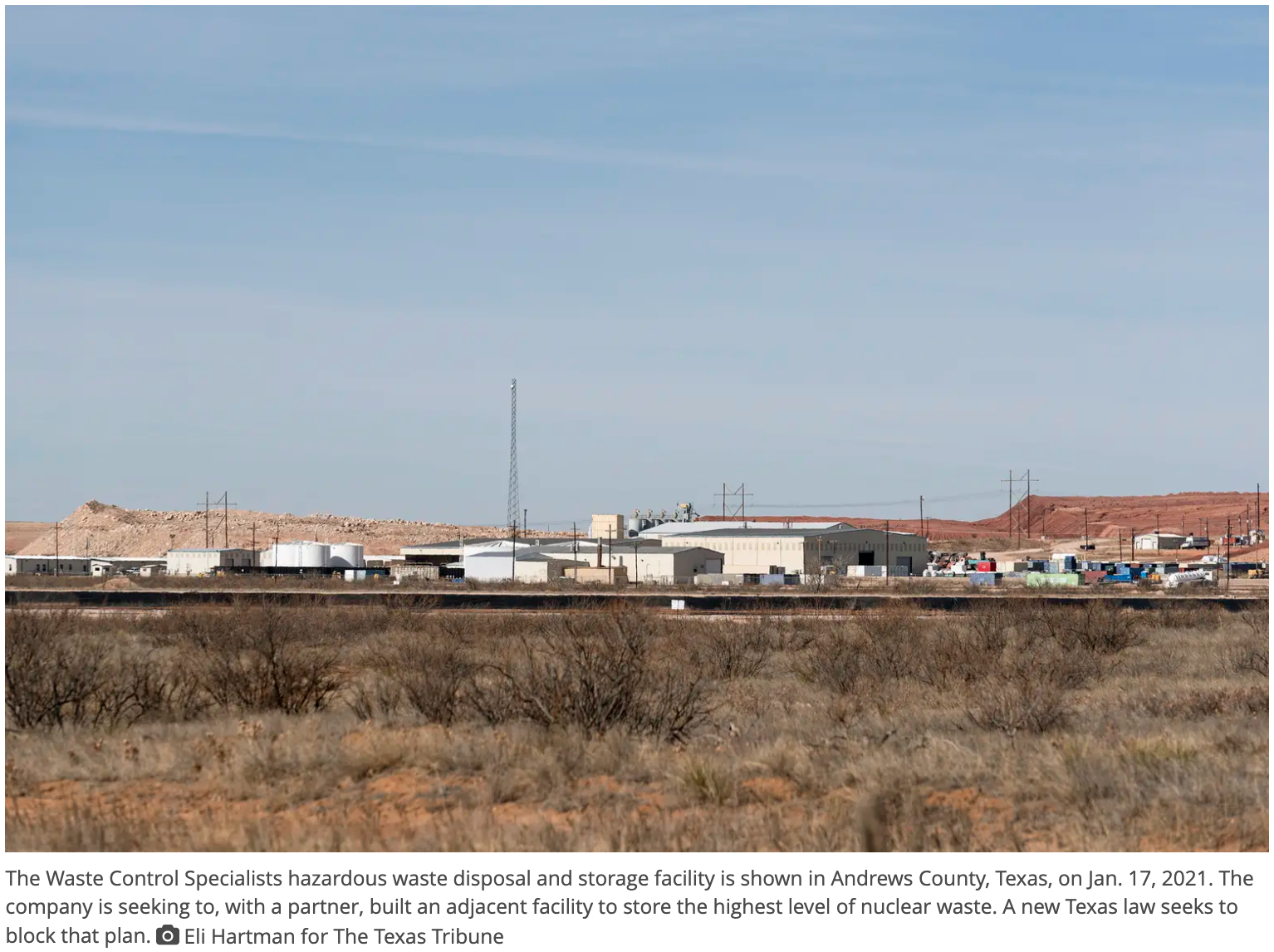
Gov. Greg Abbott on Thursday night signed a bill into law that attempts to block a plan to store highly radioactive nuclear waste at a site in West Texas.
House Bill 7 effectively bans highly radioactive materials from coming to Texas, targeting one company’s plan to build such a facility near the New Mexico border in Andrews County.
But, the new state law may soon be in conflict with federal regulators. The Nuclear Regulatory Commission is advancing the company’s application for a license to allow the high-level nuclear waste to Texas, and a decision from the federal agency could come as early as Monday, a spokesperson with the commission said.
For years, environmental and consumer advocates have protested a proposal by a West Texas company, Waste Control Specialists, to build with a partner an interim storage site for high-level nuclear waste, which is mostly spent fuel rods from nuclear power plants. Waste Control Specialists has been disposing of the nation’s low-level nuclear waste, including tools, building materials and protective clothing exposed to radioactivity, for a decade in Andrews County.
Continue reading
Lawmakers set for battle over next-gen nuclear missile
“For the W87-1, whose plutonium cores, or pits, are to be produced in part by the Savannah River Plutonium Processing Facility in South Carolina, at stake are jobs and billions of federal dollars to upgrade buildings or construct new factories. It’s all intertwined with shaky plans launched by the Trump administration to have Savannah River and Los Alamos National Laboratory in New Mexico produce a combined 80 pits per year by 2030.”
Joe Gould defensenews.com September 9, 2021

WASHINGTON ― Nuclear modernization opponents and defenders are gearing up to fight again over the next-generation intercontinental ballistic missile and other efforts.
Rep. John Garamendi, D-Calif., and a skeptic of nuclear spending on the House Armed Services Committee, confirmed he plans to offer nuclear-themed amendments when the annual defense bill receives House floor consideration later this month. One aims to pause the Air Force’s nascent Ground Based Strategic Deterrent in favor of maintaining the missile it would replace, the Minuteman III; another would zero out funds for the GBSD’s warhead, the W87-1.
“The bottom line is that we could pause the entire GBSD program and push forward into the future a $100 billion expense,” Garamendi, who chairs the House Armed Services readiness subcommittee, told Defense News.
With the Biden administration’s Nuclear Posture Review due early next year, Garamendi said the amendments are part of his “strategy to raise the issues, to gather the data, test the arguments against the opposition … and create an occasional success.”
More nuclear waste may be heading to WIPP on US 285
[WIPP is the world’s only operating underground nuclear waste dump. It is limited to nuclear weapons waste, but the federal government is trying to expand WIPP and break its promises and social contract with New Mexicans.
Help Us STOP FOREVER WIPP-Waste Isolation Pilot Plant. The nuclear waste dump is permitted to operate until 2024, but the Federal government wants to expand the amount and types of waste allowed with NO end date.
We need your help to protect New Mexico!]
“At a recent Santa Fe County Town Hall, activist Cindy Weehler of 285 ALL said the U.S. Department of Energy made it clear that it’s going to expand its nuclear waste program, she said. She said she’s concerned about the new type of radioactive waste that would be traveling through the county, which would be diluted plutonium, instead of contaminated items.”
BY ISABELLA ALVES / JOURNAL NORTH abqjournal.com Copyright © 2021 Albuquerque Journal
Spanning the length of the state, U.S. Highway 285 is a major thoroughfare for truck transports and other traffic. This busy highway, nicknamed “Death Highway” due to the number of fatal accidents on it, may get busier.
Concerned citizens in Santa Fe County recently called out the U.S. Department of Energy’s Waste Isolation Pilot Plant for expanding its mission in a permit renewal application to include more nuclear waste being shipped along the 285 corridor.
Part of Highway 285 goes along the southern edge of the city of Santa Fe, and local activists are calling on local and federal leaders to halt this increase in nuclear waste transportation.
The permit application is requesting to add two nuclear waste storage panels to WIPP that would increase the waste volume in these areas.
Montco offering potassium iodide tablets in the event of a nuclear emergency
Radioactive iodine, a contaminant that could be released in the event of a nuclear accident, can increase the risk of thyroid cancer. Potassium iodide (KI) can help protect the thyroid gland against radioactive iodine.
By Maria Pulcinella whyy.org September 8, 2021
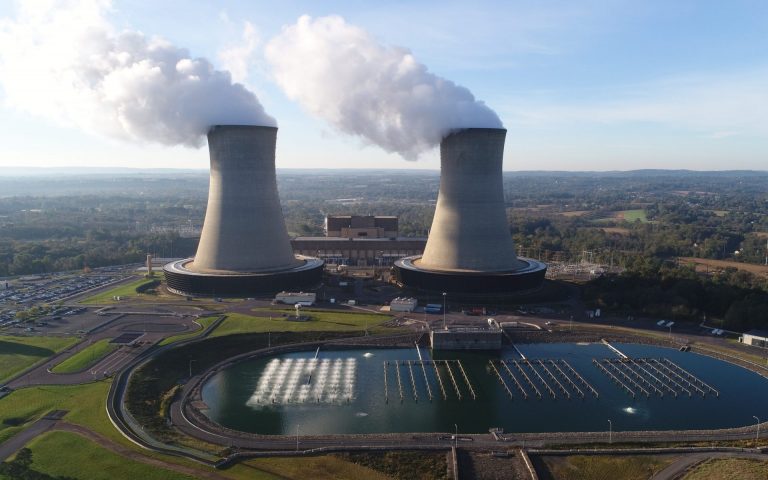
If you live, work, or attend school within a 10-mile radius of the Limerick nuclear power plant, local health officials have a freebie for you — albeit not a sexy one.
Montgomery County’s Office of Public Health will be handing out potassium iodide tablets to those in close proximity to the Limerick Generating Station.
The distribution is part of a statewide emergency preparedness effort — the Limerick site is one of Pennsylvania’s four active nuclear power plants.
General Assembly President calls for halt to nuclear tests
The President of the UN General Assembly, Volkan Bozkir, on Wednesday called for an end to nuclear tests, as ambassadors gathered to commemorate the International Day against Nuclear Tests, observed annually on 29 August.
UN News news.un.org September 8, 2021
Despite recent developments in advancing nuclear disarmament, more remains to be done, said Mr. Bozkir, urging countries which have yet to sign or ratify the Comprehensive Nuclear-Test-Ban Treaty (CTBT) to do so without delay.
Today we mark the International Day against Nuclear Tests, an opportunity to remember the victims of nuclear testing, honor the survivors and examine the legacy impacts of nuclear weapons, including that of nuclear waste. My full remarks here: pic.twitter.com/1onIGt3TJ5
— UN GA President (@UN_PGA) September 8, 2021
“More than 2,000 nuclear tests have been conducted since the advent of nuclear weapons. While the rate of testing has declined, they have not stopped,” he said.
“These tests have long lasting health and environmental consequences. They devastate the communities they impact. They displace families from their homelands.”
Progress on disarmament
Underlining the General Assembly’s commitment to nuclear disarmament, Mr. Bozkir welcomed progress achieved over the past year amid the challenges of the COVID-19 pandemic.
US attorney details illegal acts in construction projects, sealing the fate of the “nuclear renaissance”
“The indictment reveals important new information about how Benjamin and Westinghouse conspired to hide crucial information about reactor completion dates from the owners…It states that the defendant made “false and misleading statements” and “knowingly devised a scheme” to continue the project based on misrepresentations.”
By Tom Clements | thebulletin.org
VC Summer nuclear site in South Carolina, with operating unit 1 in the background and abandoned twin unit Westinghouse AP1000 nuclear reactor construction in the foreground; Tim Mousseau ©2018. Used with permission to the Bulletin of Atomic ScientistsThe ill-fated construction of new nuclear reactors in South Carolina—one of two such troubled Westinghouse reactor construction projects in the United States—was abruptly terminated on July 31, 2017, but the effort to determine legal accountability for the project’s colossal failure is only now hitting its stride.
The South Carolina legislature conducted hearings about the project’s collapse. But it has fallen to the United States Attorney for South Carolina to outline internal decisions that led to project abandonment—via court filings, plea agreements, and indictments. These filings are proving to be the best documentation so far of criminal behavior related to projects that were part of a much-hyped “nuclear renaissance” that began in the early-2000s but has since petered out in the United States.
On August 18, 2021, a second Westinghouse official was charged in a federal grand jury indictment filed with the court in Columbia, South Carolina. The charges outline “the scheme” to cover up key details about the problem-plagued project to construct two 1,100 megawatt (MW) Westinghouse AP1000 light-water reactors at the VC Summer site north of Columbia.
The project was initiated in May 2008 and gained final approval in February 2009.
According to the 18-page indictment, former Senior Vice President of New Plants and Major Projects Jeffrey Benjamin “had first-line responsibility for Westinghouse’s nuclear reactors worldwide.” He was charged, according to a news release, “with sixteen felony counts including conspiracy, wire fraud, securities fraud, and causing a publicly-traded company to keep a false record.” On August 30, the US attorney’s office announced that Benjamin would be arraigned on August 31.
In order for SCANA, parent of utility South Carolina Electric and Gas, to gain a federal production tax credit of $1.4 billion, essential to the financial viability of the project, both units had to be finished by December 31, 2020.
Benjamin and Westinghouse knew that the dates would never be met, but SCANA doggedly stuck with them given production-tax-credit pressure.The indictment reveals important new information about how Benjamin and Westinghouse conspired to hide crucial information about reactor completion dates from the owners, the publicly held utility SCANA, now defunct, and its junior partner, the state-owned South Carolina Public Service Authority (known as Santee Cooper). It states that the defendant made “false and misleading statements” and “knowingly devised a scheme” to continue the project based on misrepresentations via Westinghouse to the owners, state regulators, the Securities and Exchange Commission, investors, and ratepayers. Nervous SCANA officials played along with the inept cover-up efforts and passed on false and inaccurate information to regulators.
Benjamin, the fourth official to be charged, faces 20 years in prison and a $5 million fine. Issuance of the indictment suggests he intends to face trial rather than plead guilty—a risky proposition given the waste of $9 billion on construction of a project that delivered nothing to consumers (and potential jury members) but a series of nine rate hikes. While those hikes were eventually eliminated and further rate hikes were avoided, a small nuclear construction charge in current bills stands as an enduring reminder of the debacle.
On May 21, 2021, Carl Churchman, Westinghouse Electric Corporation vice president and project director, was indicted on the felony charge of making false statements to the FBI about the status of the project. He pleaded guilty on June 10.
In February, Kevin Marsh, former SCANA CEO, also entered a guilty plea in federal court for conspiracy to commit felony fraud. And Stephen Byrne, former SCANA chief operating officer and executive vice president, pleaded guilty in July 2020 to conspiracy to commit mail and wire fraud. Both gave false testimony numerous times to regulators.
The August 18, 2021 news release from the South Carolina US Attorney’s Office made clear that the investigation continues: “`This indictment with its attendant allegations and charges is another step toward justice for all those responsible for the VC Summer nuclear plant fiasco,’ said FBI Special Agent in Charge Susan Ferensic.”The two SCANA officials and Westinghouse’s Churchman are subject to five-year prison sentences and stiff fines but will likely face reduced sentences in exchange for fully cooperating with investigators, something required in their plea agreements.
Both Westinghouse and SCANA were eventually forced into bankruptcy. Westinghouse was acquired by Brookfield Business Partners, and SCANA vanished after an easy takeover by Dominion Energy, approved in December 2018. The fate of the debt-strapped, state-owned partner Santee Cooper rages on in the South Carolina Legislature.
One entity that will likely never be held responsible for the disastrous project that it authorized is the South Carolina Public Service Commission. Members of this body unanimously voted in favor of anything SCANA requested during the entire course of the project and balked at providing oversight as it fell apart. All were replaced by the Legislature at the end of their terms with new members, who have been less accommodating to utility requests.
Public interest intervenors were prescient in their early assessments of the project. Friends of the Earth, which intervened before the Public Service Commission against the project in August 2008, noted SCANA’s disregard for energy efficiency and alternative forms of energy. That organization predicted that the project’s fate would be what the US Attorney’s Office affirmed in the August 18, 2021 indictment: “from the outset, the Project was characterized by cost overruns and significant delays.” Likewise, toward the end of the project in June 2017, just after Westinghouse declared bankruptcy, Friends of the Earth and the Sierra Club filed a formal complaint detailing why the project must be canceled. As money hemorrhaged, the owners made that earth-shaking decision a month later. And the mighty crash still reverberates.
In Georgia, construction of the other AP1000 project, located at Plant Vogtle, stumbles along to massive cost overruns and significant schedule delays. A main difference between the projects: Georgia Power has a large enough customer base to absorb the financial blow of its struggling project. With cost projections for the two Vogtle units nearing a stunning $30 billion, finishing dates presented to the Georgia Public Service Commission remain open to question.
The Carolina and Georgia reactor projects went forward under laws related to “construction work in progress” that allowed financing charges to be billed to the ratepayers from the start of construction, long before the reactors were online. Both the South Carolina law, the Baseload Review Act, and Georgia’s Nuclear Energy Financing Act have been repealed.
The fault for the shocking AP1000 misadventure falls squarely on the shoulders of Westinghouse and the involved utilities. They all fell victim to their own reactor-promotion propaganda but lacked the technical and management competence to pull off the projects as envisaged. With pursuit of large light-water reactors in the United States all but dead, the nuclear industry is now endlessly touting an array of “small modular reactors” and a dizzying menu of so-called “advanced reactors,” all of which exist only on paper. It’s unclear if there’s a path forward for this nuclear renaissance redux, and if there is, whether taxpayers will be put on the hook for financing some of it.
Germany Calls on Iran to Resume Nuclear Talks
Informal negotiations stalled after Iran’s new hardline president was elected in June. Tehran has caused an international outcry in recent months over the broadening scope of its nuclear program.
“US President Joe Biden has signaled his eagerness to resume direct talks, but Iranian officials have yet to do the same.”
The German Foreign Ministry on Wednesday said it “vehemently” urged Iran to restart negotiations aimed at reviving a defunct nuclear deal.
“We are ready to do so, but the time window won’t be open indefinitely,” a ministry spokesman said.
The French foreign ministry made a similar statement later on Wednesday.
In 2015, Iran, the United States, United Kingdom, Germany, France, Russia, China, plus EU representatives, worked out a deal to place curbs on Iran’s nuclear program. The Joint Comprehensive Plan of Action (JCPOA) sought to prevent Iran from making nuclear weapons by restricting the extent to which it could enrich uranium, install nuclear centrifuges, and stockpile radioactive material. In exchange, the other signatories agreed to drop certain sanctions against Tehran.
‘A combination of failures:’ why 3.6m pounds of nuclear waste is buried on a popular California beach
The San Onofre nuclear power plant shut down years ago – but residents and experts worry what will happen with the waste left behind
The defunct San Onofre nuclear power plant near San Clemente, California. Photograph: Lenny Ignelzi/APMore than 2 million visitors flock each year to California’s San Onofre state beach, a dreamy slice of coastline just north of San Diego. The beach is popular with surfers, lies across one of the largest Marine Corps bases in the Unites States and has a 10,000-year-old sacred Native American site nearby. It even landed a shout-out in the Beach Boys’ 1963 classic Surfin’ USA.
But for all the good vibes and stellar sunsets, beneath the surface hides a potential threat: 3.6m lb of nuclear waste from a group of nuclear reactors shut down nearly a decade ago. Decades of political gridlock have left it indefinitely stranded, susceptible to threats including corrosion, earthquakes and sea level rise.
The San Onofre reactors are among dozens across the United States phasing out, but experts say they best represent the uncertain future of nuclear energy.
“It’s a combination of failures, really,” said Gregory Jaczko, who chaired the US Nuclear Regulatory Commission (NRC), the top federal enforcer, between 2009 and 2012, of the situation at San Onofre.
‘Star Wars’ no longer fiction
ABQ at center of research for tomorrow’s weapons
“Albuquerque, New Mexico, is the epicenter of directed energy research in the United States…If the arms race for directed energy indeed takes off, much of the action could take place in Albuquerque.”
BY RYAN BOETEL / JOURNAL STAFF WRITER Copyright © 2021 Albuquerque Journal August 20, 2021 abqjournal.com
Force fields protecting us from drones and missiles.
Guns that shoot lasers instead of firing bullets.
Rock ’em Sock ’em Robots zapping at each other on the battlefield.
A new report by the Air Force Research Laboratory titled Directed Energy Futures 2060 describes the sorts of “directed energy” weapons that may come to exist in the next 40 years. And the expected technology – much of which may be researched and developed in Albuquerque – is like something out of a science fiction movie.
Officials from multiple Department of Defense entities, partners with the North Atlantic Treaty Organization and other experts came together to write the report, which says the world is at a “tipping point.”
MOX failed. But plutonium pit production is different, argues NNSA exec.
“Even with a potential surge in production at Los Alamos, there remains uncertainty about that capability, especially with their history of outages,” U.S. Rep. Joe Wilson
By Colin Demarest cdemarest@aikenstandard.com postandcourier.com August 21, 2021

ALEXANDRIA, Va. — In late 2018, a behemoth fuel facility at the Savannah River Site was axed. Its cancellation, enabled by a court ruling and promises of saving billions of dollars, marooned more than a decade of work and vexed a clutch of South Carolina politicians.
What remained was a shell: a Mixed Oxide Fuel Fabrication Facility that was partially built and would eventually be secured and preserved, like an insect suspended in amber.
In the years that followed, the federal government began seriously pursuing a nuclear weapons mission – the crafting of warhead components known as plutonium pits — using the MOX skeleton as a springboard. That effort continues today, and at a clip some have likened to the Cold War or the Manhattan Project, the odyssey that birthed the nuclear age.
But where MOX failed, the Palmetto State pit factory will not, according Michael Thompson, a National Nuclear Security Administration executive. While bilateral friction and “higher-level policy choices” hamstrung the reactor fuel project, it’s a different matter when it comes to the plutonium cores and the Savannah River Plutonium Processing Facility, Thompson argued earlier this month.
Continue reading
We could all learn a lesson on disarmament from Archbishop Hunthausen
By Leonard Eiger nrconline.com
“I am grateful for having been invited to speak to you on disarmament because it forces me to a kind of personal disarmament. This is a subject I have thought about and prayed over for many years. I can recall vividly hearing the news of the atomic bombing of Hiroshima in 1945. I was deeply shocked. I could not then put into words the shock I felt from the news that a city of hundreds of thousands of people had been devastated by a single bomb. Hiroshima challenged my faith as a Christian in a way I am only now beginning to understand. That awful event and its successor at Nagasaki sank into my soul, as they have in fact sunk into the souls of all of us, whether we recognize it or not.”
Those are the opening lines of the “Faith and Disarmament” speech Seattle Archbishop Raymond Hunthausen delivered on June 12, 1981. Hunthausen had become active in resistance to the U.S. stockpiling of nuclear weapons and the new Trident submarine-based nuclear weapons system, which included the Bangor Trident submarine base in Puget Sound just 20 miles west of Seattle.
In that 1981 speech, Hunthausen referred to the Trident submarines based there as “the Auschwitz of Puget Sound.” In context, it was both a profound and prophetic statement of fact.
As Hunthausen said, “Trident is the Auschwitz of Puget Sound because of the massive cooperation required in our area — the enormous sinful complicity that is necessary — for the eventual incineration of millions of our brother and sister human beings.”
Stop Nuclear Waste Site Expansion Before it’s Too Late
John Watson-Jones, Letters to the Editor, santafenewmexican.com
Many New Mexicans are aware that Waste Isolation Pilot Project in Southern New Mexico is the nation’s sole repository for radioactive weapons waste, but did you know that WIPP has surpassed its authorized capacity and that the federal Department of Energy has given it a new mission: to build a new shaft and more than double its capacity?
The resulting increased amount of radioactive plutonium being transported through the Santa Fe area should worry us all. You might assume that nuclear experts have the storage and transportation situation well in hand, but the Los Alamos National Laboratory and WIPP have dismal safety records.
If the powder form of plutonium being carried by tractor-trailers on N.M. 599, Interstate 25, and U.S. 285 is accidentally released into the air, even minuscule doses are 100 percent carcinogenic, especially to children, and cleanup is virtually impossible. And it is our local jurisdictions that respond first to highway accidents. To better understand the danger, see stopforeverwipp.org.
Fortunately there is something citizens can to do try to stop this dangerous expansion. Contact Gov. Michelle Lujan Grisham, who has to approve such a change. Tell her to tell the Energy Department to stop digging a fifth shaft at WIPP. You can use governor.state.nm.us/contact-the-governor.
John Watson-Jones
Galisteo
The Secret ‘White Trains’ That Carried Nuclear Weapons Around the U.S.
For as long as the United States has had nuclear weapons, officials have struggled with how to transport the destructive technology.
“The epicenter of nuclear transit was the Pantex Plant, about 17 miles outside of downtown Amarillo, Texas, a maze-like complex of dozens of buildings located on 10,000 acres of land. Amarillo was the final destination for almost all of America’s nuclear trains and the Pantex Plant was the nation’s only assembly point for nuclear weapons, a role it maintains to this day.“
BRIANNA NOFIL | UPDATED: MAY 6, 2021, ORIGINAL: MAY 31, 2018 history.com
At first glance, the job posting looks like a standard help-wanted ad for a cross-country trucker. Up to three weeks a month on the road in an 18-wheel tractor-trailer, traveling through the contiguous 48 states. Risks include inclement weather, around-the-clock travel, and potentially adverse environmental conditions. But then the fine print: Candidates should have “experience in performing high-risk armed tactical security work…and maneuvering against a hostile adversary.”
The U.S. government is hiring “Nuclear Materials Couriers.” Since the 1950s, this team of federal agents, most of them ex-military, has been tasked with ferrying America’s roughly 6,000 nuclear warheads and extensive supply of nuclear materials across the roads and highways of the United States. America’s nuclear facilities are spread out throughout the country, on over 2.4 million acres of federal real estate, overseen by the Department of Energy (DOE)—a labyrinth of a system the Bulletin of the Atomic Scientists called “highly scattered and fragmented…with few enforceable rules.”
Some sites are for assembly, some are for active weapons, some are for chemicals, some are for mechanical parts. What this means in practice is that nuclear materials have to move around—a lot.
Staffers see little interest or action on nuclear waste issues
“The Town of Vernon supports a repository site or sites under the following conditions: Approval by the Federal Government, DOE, Congress, and the NRC. Deemed/tested safe by engineering and environmental experts by known and reasonable standards. Received approval/consent from the state, territory, town, or country chosen to be the repository/repositories. This includes one single repository, multiple repositories, or interim storage,”
By Susan Smallheer, Brattleboro Reformer | August 24, 2021, reformer.com

Photo provided by NorthStar
BRATTLEBORO — The 117th Congress has introduced few bills this session dealing with nuclear power and nuclear waste, staffers for Vermont’s congressional delegation told a Vermont committee studying federal nuclear waste policies Monday.
The committee, an arm of the Vermont Nuclear Decommissioning Citizens Advisory Panel, is investigating whether it should take a stand on what happens to the high-level radioactive waste currently stored at the Vermont Yankee site in about four-dozen stainless steel and concrete casks.
Two companies, including the parent company of NorthStar Decommissioning, which owns the Vermont Yankee plant and is demolishing it, want to build interim storage facilities for high-level waste — one in west Texas and the other in New Mexico. Interim storage would hold radioactive waste until a federal depository is built.
The two congressional staffers who met with the committee, Haley Pero, from Sen. Bernie Sanders, I-Vt., office, and Thea Wurzburg of Rep. Peter Welch, D-Vt.’s office, both said they have seen little interest from the Biden administration in taking on the difficult issues of nuclear power and its nuclear waste.
The administration of former President Donald Trump tried to revive funding for the Yucca Mountain high-level radioactive waste facility in Nevada, but made no progress, Pero said. Not as many bills have come up this year, Pero said.
Congress’ attention is elsewhere, the two staffers said.
The Vermont panel last year backed off an earlier endorsement of interim waste storage, like the facilities proposed by NorthStar in Texas and Holtec International in New Mexico.
Cleaning up nuclear waste at Hanford: Secrecy, delays and budget debates
A plan to turn radioactive waste into glass logs has raised a lot of questions, many of which don’t appear to have public answers.
“It’s not clear whether the high-level waste plant will ever operate,” said Tom Carpenter, executive director of Hanford Challenge, a watchdog organization.
“We need to get some stuff out of here, or we’ll end up with it permanently staying here…This is a generational problem,” Stephen Wiesman said.
Ultimately, this project, originally scheduled to be finished this decade, will likely be completed in the latter half of this century. In other words, it could take 70 to 75 years (mid-1990s to 2069) to deal with the 56 million gallons of radioactive tank waste created by 42 years of manufacturing plutonium.
By John Stang, Crosscut columbian.com August 23, 2021

Stephen Wiesman has worked for about three decades on the Hanford Nuclear Reservation’s project to convert the radioactive waste in its huge underground tanks into safer glass logs.
A Hanford engineer since 1980, Wiesman helped create the Office of Protection, the Department of Energy’s unit in charge of dealing with the nuclear waste stored in those tanks, serving as a senior technical adviser since the late 1990s.
Now 75 and retired since 2012, Wiesman is on the Hanford Advisory Board, which represents environmentalists, Tri-Citians, tribes, health officials, business interests and governments from across the Northwest. Currently, Wiesman is the board’s chairman.
Hanford dates back to late 1942, when it became a super-secret World War II site to create plutonium for the first atomic bomb exploded — in New Mexico and later over Nagasaki, Japan. The nuclear reservation continued that mission during the Cold War and through 1987.
During four decades of production, uranium rods and other nuclear waste were stored in 149 single-shell tanks, of which at least 68 have since sprung leaks. Hanford added 28 safer double-shell tanks and transferred the liquid wastes into them.
Hanford has 56 million gallons of radioactive waste in those 177 underground tanks at this remote decommissioned nuclear production site near the Columbia River in Benton County.
Those leak-prone tanks are arguably the most radiologically contaminated place in the Western Hemisphere.
Nuclear News Archives – 2021
Nothing Found
It seems we can’t find what you’re looking for. Perhaps searching can help.


